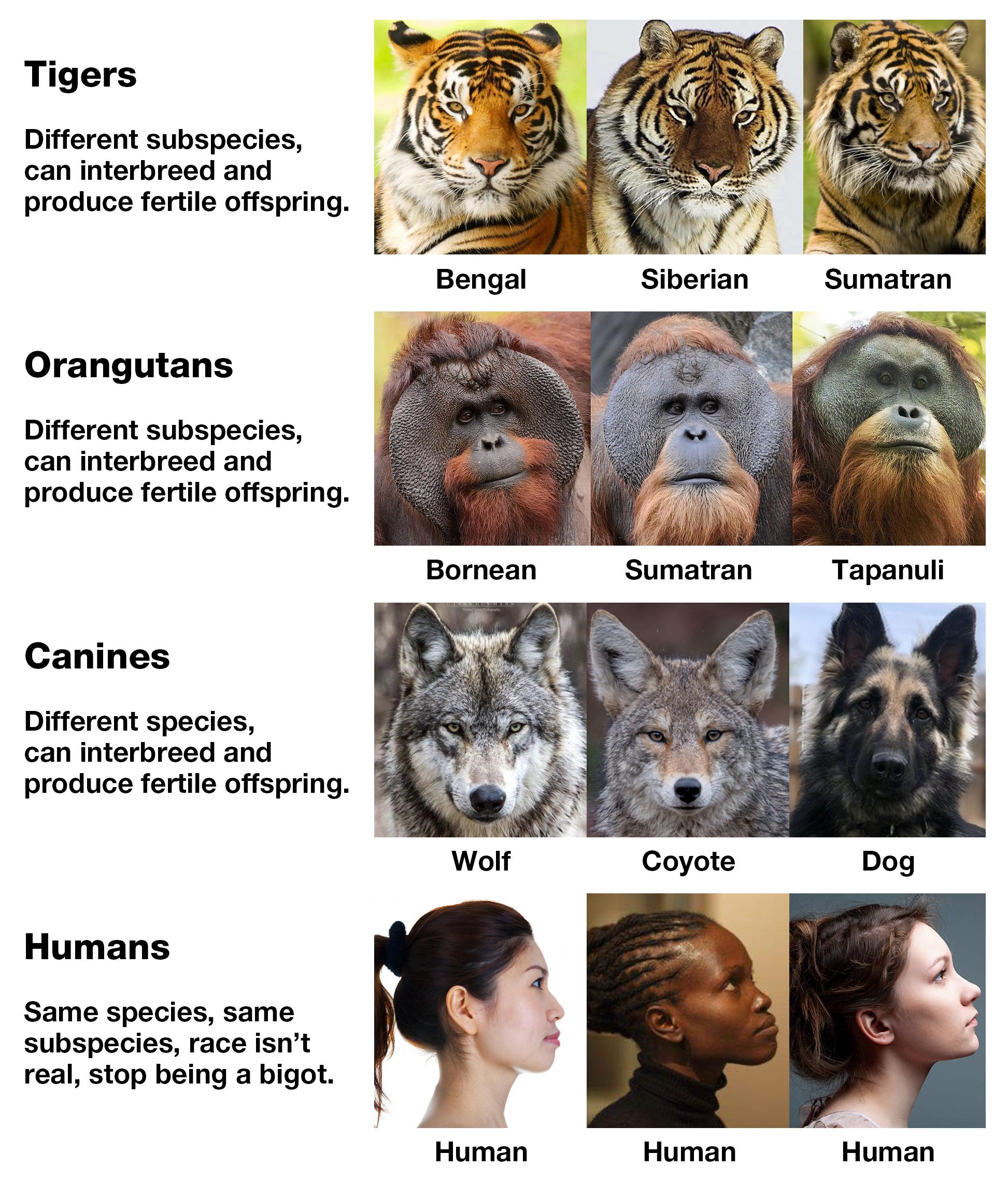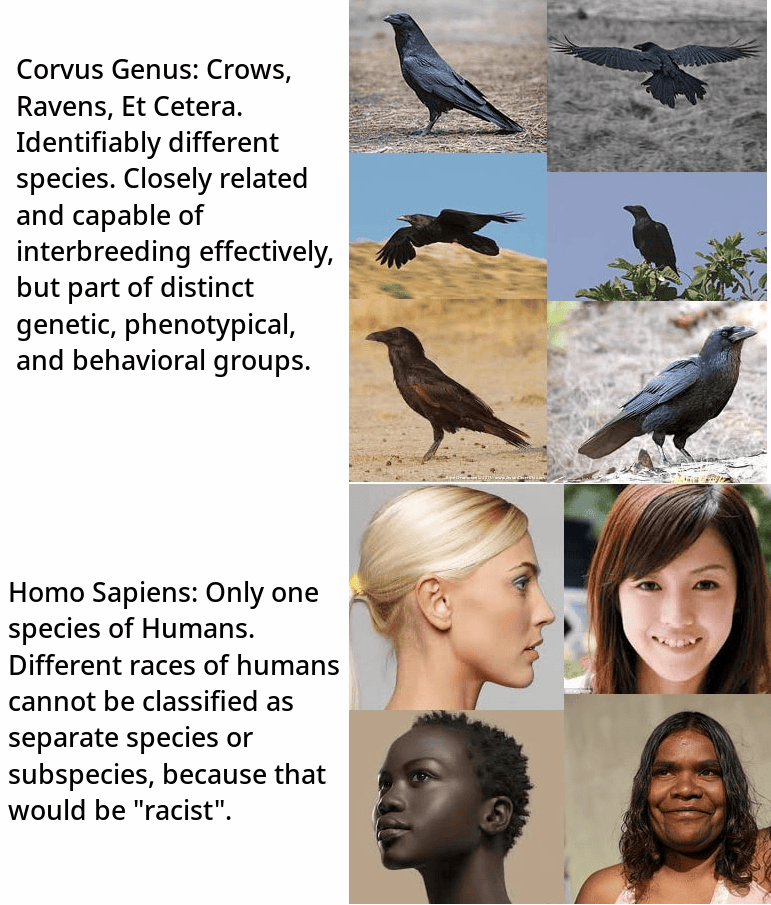Philosophy of Race FAQs
An Introduction To Race Realism, Human Biodiversity, And “Scientific Racism”
1. What Is Race?
1.1. What Is Race Realism?
Race Realism is a subcategory of Biological Realism. Race realism is a rational inquiry into the nature of race. Race realism makes the following core truth claims:
- Race is defined as “a statistical cluster of genetic variation, which is characterized by phenotypic similarities and shared ancestry”. Races typically refer to humans, and are akin to subspecies.
- Many genetic variants occur at different frequencies in each race for various reasons, including but not limited to: selective pressures, genetic drift, and founder effects.
- Racial differences and statistical clusters are continuous, not discrete.
- Racial categories tend to have predictive and explanatory power, barring outliers.
- Racial disparities are probably mostly genetic, and mostly not environmental.
- Racial disparities ultimately exist due to geographic, evolutionary, historical, and prehistorical reasons.
- A race is a descriptive category of things, not a subject (more on that below).
- Race realism doesn’t make any value claims. It’s only a set of positions on what beliefs are true or false. Truth judgments don’t imply value judgments (e.g. racism, racial equality, etc). Hence, race realism does not imply racism, nor racial hierarchies, nor subjective judgments regarding race-mixing.
See: Wikipedia: Fact-Value Distinction.
This document shall elaborate on all the major sub truth claims that relate to these macro truth claims.
A race is a descriptive category of things. Just because I can assign people into descriptive categories, it does not follow that those categories will interact with the world as units. In general, they won’t. It would be very difficult to act on Europeans as a class, just as it would be very difficult to act on all left-handed men over 6 feet tall. Neither class meets the criteria for an object. A rock is an object that can be acted upon as a unit. It has internal coherence by its nature. A race is not an object; it has no internal coherence.
Likewise a race is not a subject. It has no will or awareness. It does not act in the world. The white race doesn’t have agency any more than the set of all left-handed men over 6 feet tall has agency. Both are merely descriptive categories to which individuals can be assigned. That’s why it is stupid to blame whites as a class for such things as slavery and colonialism. White people never did anything as a unit. There were various individuals and social groups doing various things, the net result of which included such outcomes as slavery, colonialism and the expansion of European populations into the Western Hemisphere. – Blithering Genius, “Killing the Unicorns”
Related: Wikipedia: Type–Token Distinction.
1.3. Isn’t Race Just Skin Color?
Anyone with working eyes can see that race is not merely “skin color”, “just a melanin level”, etc. If race was only about skin color, then it wouldn’t be possible to identify the races of albino people… but it is.
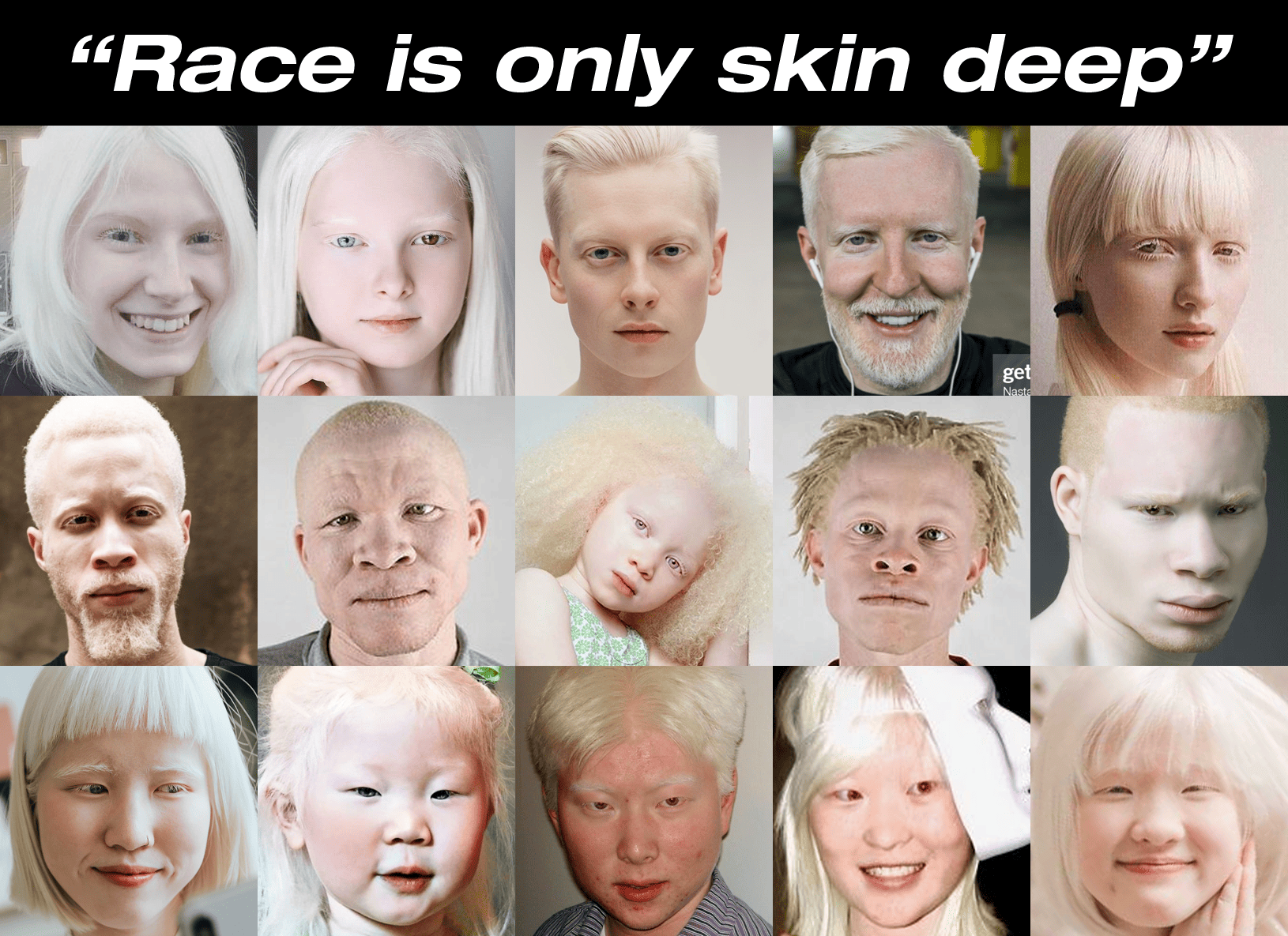
Moreover, this page features dozens of examples of how race is far more than just skin color. There is far more human genetic variation in mental traits than skin colors.
1.4. What is the difference between “race” and “ethnic group”?
“Race” and “ethnic group” are sometimes used interchangeably, and this is often done erroneously. The difference is that “race” only focuses on genetics and characteristics that depend on or affect genetics, like appearance, behaviors, ancestral environment(s), diet, etc. Ethnicities are determined by “race” to a great extent, but ethnic groups also take into account common sets of traditions, ancestry, language, history, society, culture, nation, religion, or social treatment within their residing area. Hence, “ethnic groups” and “races” are not the same thing.
In some contexts, the word “ethnicity” cannot replace the word “race”. Some examples:
- Hispanics are defined as anybody who is from or has ancestors from a Spanish speaking country. However, the Hispanics living in Mexico, Spain, and the Caribbean are still not from the same race. Most Mexican Hispanics are mestizos, most Spanish Hispanics are purely European, and many Hispanics in the Caribbean are best classified as mulattoes.
- Jews are an ethnoreligious group and nation originating from the Israelites of ancient Israel and Judah. The three main ethnic subdivisions of the Jews (according to where their ancestors settled) include: the Ashkenazim (Central and Eastern Europe), the Sephardim (Iberian Peninsula), and the Mizrahim (Middle East and North Africa). These ethnic subgroups each mixed with different races and evolved to be rather different from each other, so all the world’s Jewish people wouldn’t appear as a distinct genetic cluster under genetic analyses.
- Arabs are an ethnic group that is defined as containing anybody who can natively speak a language that’s descended from Classical Arabic, of which there’s over 30 different languages/varieties. Sudanese Arabic speakers and Iraqi Arabic speakers are thus from the same ethnic group (Arabs) because they both speak Arabic, but they’re clearly not from the same race.
- The Cantonese people and Jiao-Liao people are both from the same ethnic group (Han Chinese), but they have very different genetics. So much so that Cantonese people are sometimes grouped in with Southeast Asians instead of East Asians, depending on the context and algorithmic parameters.
In each of these example, a cursory look at Google Images verifies that each of these ethnic groups have sub-ethnic groups that look noticeably different from each other, despite being grouped into the same ethnic group.
The boundaries between ethnic groups also tend to be more arbitrary, compared to races. When race is used in a biological or a sociological context, races have more clearly defined and specific boundaries, compared to ethnic groups. Races thus have greater predictive and explanatory power for predicting social outcomes, compared to ethnic groups.
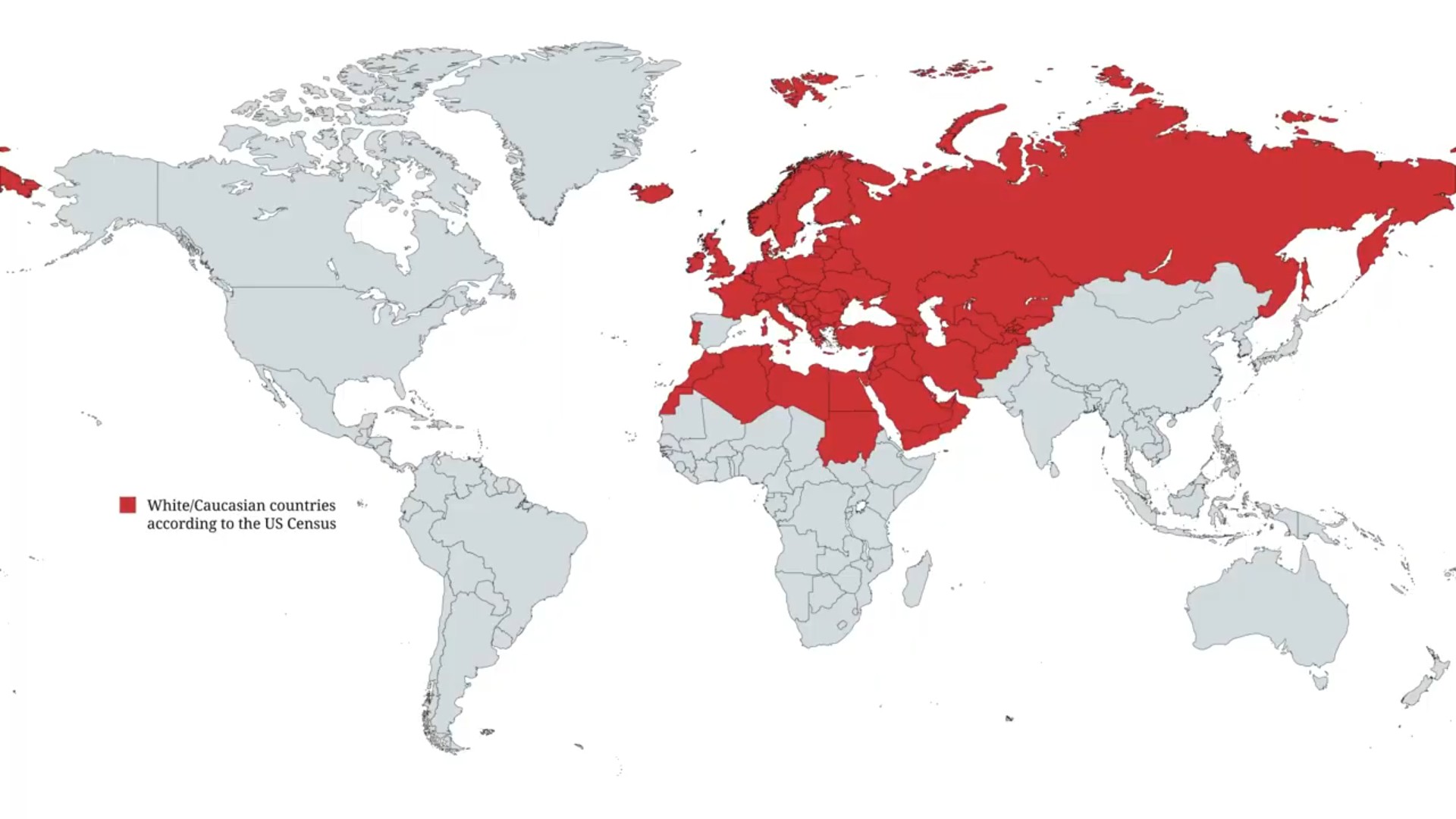
1.5. But race exists on a continuum, so race does not exist.
At least two fallacies are made in this argument, including the Continuum Fallacy:
X and Y are two extremes on a spectrum. There is no clear point at which X becomes Y, therefore, X and Y do not exist.
If races don’t exist because they exist on a continuum, then colors don’t exist either because colors also exist on a continuum. But it’s clearly useful to distinguish colors by name, so this is a contradiction.

Race denialists also use words like “White people”, “Black people”, or “Asians” to refer to people and talk about racial disparities, so they implicitly believe that people can be categorized into different races. It’s thus hypocritical of them to insist that race doesn’t exist just because it’s on a continuum. It’s bad-faith tactical nihilism.
Genetic analysis can separate humanity into reasonably distinct taxons. There are multiple different racial taxonomies, and they each vary depending on the context and how the threshold parameters for dividing taxons are set. Hence, racial groups can be lumped into vast continental-scale agglomerations or split as finely as you like. For example, Siberians could considered a separate race in one taxonomy model, while being considered a subset of East Asians in another model. Every system of categorization runs into disputes between “lumpers” and “splitters”. Whether lumping or splitting is more appropriate depends on the situation.
Subspecies or races are not branches on a tree, although sometimes they are depicted that way for convenience. They are more like waves on a choppy sea. The bumpy surface represents the distribution of genetic variants. Each bump is a cluster of similar individuals – a race – but the area between those waves is not empty. There are intermediate forms, genes flow between the bumps, and the bumps change over time. This metaphor is called “adaptive topography”.
– Blithering Genius, “Killing the Unicorns”
Even if the distribution of human groups is continuous with no distinct genetic or phenotypic breaks (and it often is), that wouldn’t render each group along the distribution non-existent, nor would it render the differences between each group insignificant. That would be tantamount to saying yellow is equivalent to orange. Sometimes racial groups are even separated by geographic landmarks, such as deserts and mountains, which enable us to clearly identify definitive regions and groups.
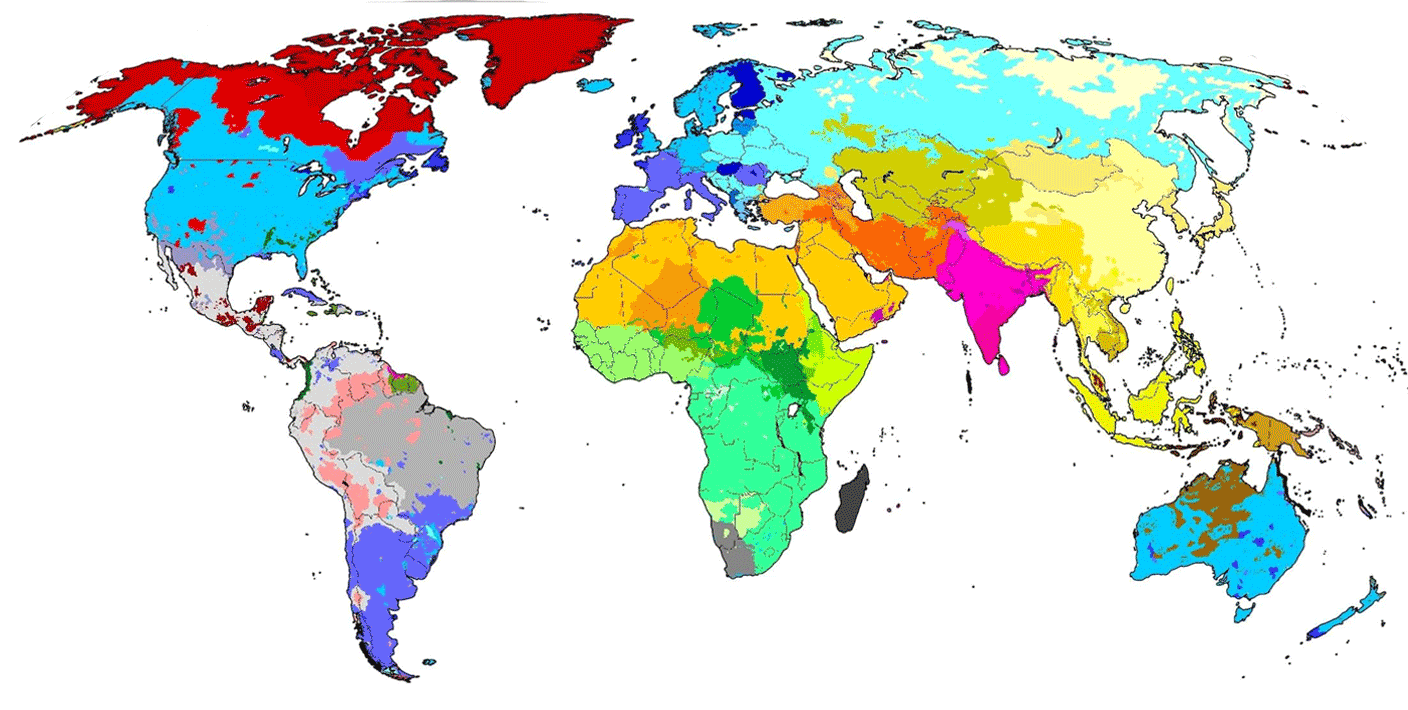 |
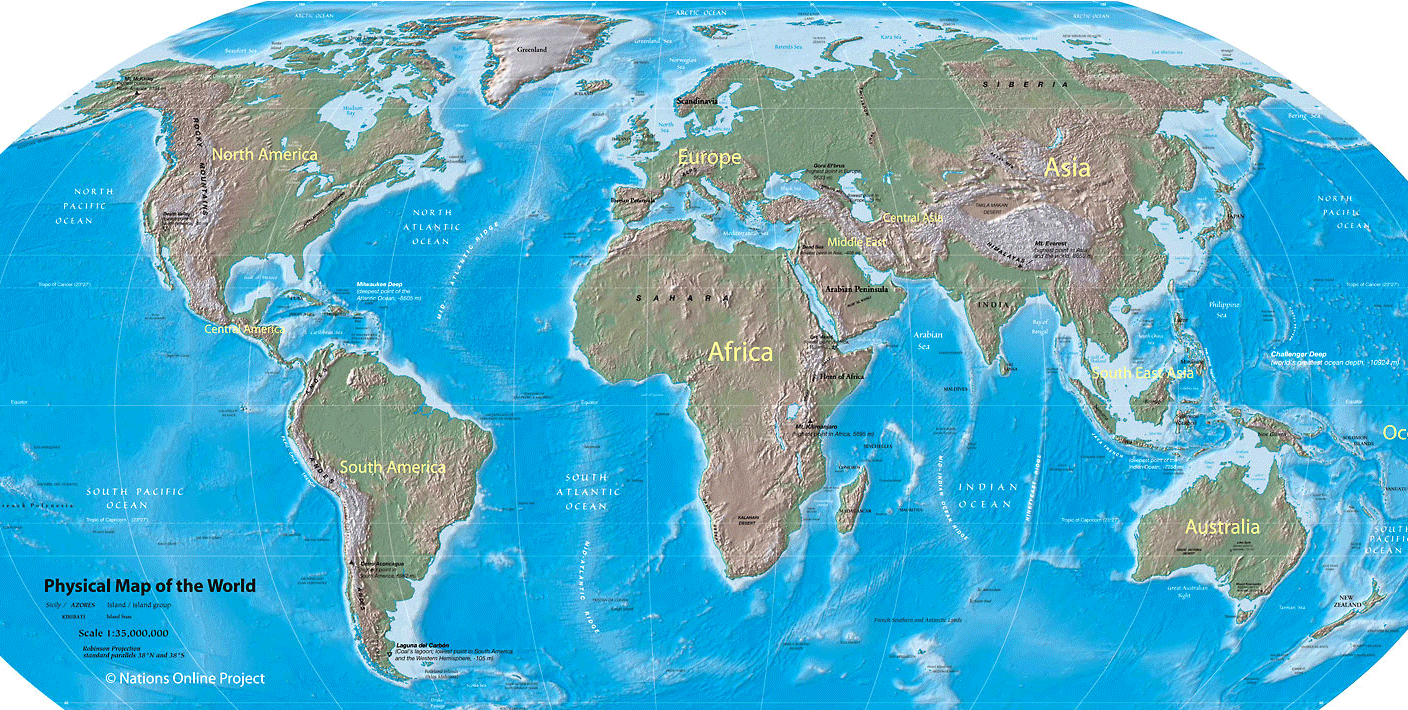 |
The genetic definitions of various races are defined by clusters of multiple characteristics. So, rejecting the validity of defining racial categories also requires rejecting the validity of all the other general variables in this list since their validity is justified by similar logic, lest there be contradicting beliefs. Most people wouldn’t reject those variables though, which suggests that it’s valid to define racial categories since they have predictive and explanatory power.
Read More: The Continuum Fallacy and its Relatives.
1.6. Aren’t clines a better way to describe human genetic diversity than races?
A cline is defined as a gradation in one measurable physical or genetic characteristic, within or between biological groups. Some race-denialists try to replace the word ’race’ with ’cline’, but this doesn’t clarify anything. The stress on the “clinial” nature of human population and genetic distribution is just motivated obfuscation, as is much of the discussion on inherited human differences.
If the word “cline” wasn’t abused to deny the validity of racial categories (and biological differences by extension), it could potentially be a useful term, similar to how dialect continuum can be a useful term in linguistics for emphasizing gradual variations across geographical distances. Races are to languages as clines are to dialect continuums. But even then, linguists still find it useful to divide dialect continuums into zones or subdivisions (e.g. the Guthrie classification of Bantu languages). So even when we replace the word “language” with “dialect continuum”, we still end up back where we started when we need to talk about the linguistic differences across the dialect continuum. The same goes for “race” versus “cline”. Most linguists wouldn’t have any problems with dividing a dialect continuum up into zones to understand it better. They might debate where the exact boundaries of the zones are, but that’s about it. This highlights their hypocrisy when they take issue with defining racial categories, which also exist on a continuum.
2. Examples of Race Being Biological
These examples are meant to show that race is far more than a supposed “social construct”. Every race has genes that make its people better adapted to survive in the environmental conditions that their ancestors evolved to live in.[2] This is an incomplete list of examples:
2.1. Bone Structure
- Bone density strongly varies depending on race, with Asians having the lowest bone densities, and Sub-Saharan Africans having the highest bone densities. Source
- African Americans don’t require as much calcium and vitamin D to maintain good bone health as other races. Source
- Despite having lower average bone mineral density than most other racial groups, Chinese women have lower rates of spine fractures and hip fractures than white women, due to differences in hip geometry and bone microarchitecture. Source
- East Asians tend to have shorter statures since this made it easier to work in rice fields for several hours, days on end.
- Pygymies have the shortest human statures in the world. Pygymy adult men are on average less than 150 cm (4 ft 11 in) tall. There are probably multiple reasons why they evolved to be this height. Source
- The Huaorani tribe in the Amazon rainforest spend much time climbing trees in order to hunt monkeys. They thus evolved to have very flat feet, which helps them to climb trees. Because of the small gene pool, many also have six toes on each foot. Source
- Sinodonty and Sundadonty dentitions occur among East Asian, Southeast Asian, and American Indian populations, but not among other races. Source
- Shovel-shaped incisors are significantly common in Amerindians from North, Central and South America. They are also common in East and Central Asians, Hungarians, the Inuit and Aleut peoples of Northeast Asia and North America (including but not limited to the Inuit peoples of eastern Alaska, arctic Canada and Greenland). In European and African groups, shovel-shaped upper incisors are uncommon or not present. Source
- The prevalence of wisdom teeth depends on race. Agenesis of wisdom teeth ranges from almost 0% in Aboriginal Tasmanians to nearly 100% in indigenous Mexicans. East Asians also tend to have fewer wisdom teeth. Source
2.2. Human Diet
- Populations that cultivate rice, wheat, and other grains tend to have more copies of the amylase gene in their DNA. This controls for the ability to produce an enzyme in their saliva called amylase, which enhances the ability to digest starch. Source
- Europeans tend to be more lactose-tolerant since being able to drink cow’s milk provided their ancestors with another food source during times of food scarcity and famine. This natural selection favored lactose tolerant genes. Source
- The Alcohol Flush Reaction is common in East Asians, but not among other races. Source
- There is a strong relationship between gene variants and yearly alcohol consumption that is related to how pleasant alcohol tastes. Source
- The species of bacteria that live in a person’s mouth depends on the person’s race, regardless of the environment that they live in (Source). Such differences may have practical significance. For example, a bacterium only found in Japanese individuals is thought to be important for digesting seaweed, which has been an important food source in Japan. Source
- The Inuit, Yu’pik, and nearly all arctic populations have the L479 allele of the CPT-1a gene which prevents them from going into ketosis. It’s likely that this was an adaptation to the low-carb, high-fat, high-protein diets that those peoples have had for thousands of years. Source
- Certain variants of the TAS2R16 and TAS2R38 genes make individuals highly sensitive to bitter flavors, and are only found in Africa. This may be related to differences regarding available food sources. Non-dietary proposed explanations include the roles of bitter taste receptors in the gastrointestinal tract and the lungs. Source
- The people of the northern Argentinean Andes, an arid region where elevated arsenic concentrations in available drinking water is common, evolved to have high arsenic tolerance. They can drink water containing arsenic beyond a few hundred times the recommended world safety limit without falling ill. Source
2.3. Disease Immunity
- Blood type distributions strongly vary depending on one’s race. This is still being researched, but the most likely reason for this is that different blood types offered different levels of immunity against certain diseases. Source
- Human populations that live in areas that at high risk of malaria inherited genes that provide immunity against malaria when heterozygous, even though this causes sickle-cell anemia when both copies of the sickle cell gene are inherited. Source
- Sickle cell anemia and resistance to malaria tends to be more prevalent in Africans and other tropical populations (Source). The comparatively lower prevalence of sickle cell disease in African Americans compared to other Africans is partly due to race-mixing in North America.
- West Africans have less red blood cells and lower hemoglobin, due to the prevalence of malaria. Since slow twitch muscle fibers use aerobic respiration, West Africans have less slow twitch muscle fibers to compensate for having less hemoglobin. West Africans thus have more fast twitch muscle fibers, which use anaerobic respiration and thus don’t need red blood cells. Source
- Cystic fibrosis, Tay Sachs disease, and other forms of genetic resistance to tuberculosis tend to be more prevalent in Europeans. Source
- Humans in urban population centers evolved resistance to leprosy and tuberculosis. Source
- American Indians did not have immune systems that were adapted to Old World diseases, thus causing ~90% of them to die out when coming in contact with those diseases.
- The descendants of the American Indians who survived the Old World diseases were more adapted to surviving those diseases than the American Indian populations had been historically. This is an example of natural selection changing a human race to become more adapted to its environment.
- Even still, American Indians had higher Covid death rates compared to other ethnic groups on average, hence why Peru was one of the most devastated countries in the world by the COVID-19 pandemic, since Peruvians have a lot of American Indian DNA. Compared to other ethnic groups, American Indians are the least well adapted to COVID-19.
- A genetic mutation known as CCR5-delta 32 is responsible for the two types of HIV resistance that exist. The gene believed to have mutated about 700 years ago and is linked to the resistance to the Black Death in the 14th century. This mutation makes about 1-2% of people descended from Northern Europeans, particularly Swedes, immune to HIV infection. For about 20% of the population, it takes longer time to get sick and the symptoms of the infection is milder. This mutation is not found among Africans, Asians or Amerindians. Source 1, Source 2
- A population in Papua New Guinea evolved to have resistance against prion-caused brain disease in populations practicing mortuary cannibalism. Source
- The Bajau in Indonesia have genetically enlarged spleens, argued to be related to their diving ability, since they have traditionally traveled the Southeast Asian seas in houseboats and collected food by free diving up to 70 meters with spears. Source
- Different populations have different frequencies of gene variants that cause wet or dry earwax, differences in body odor, and potentially even the risk of cancer. East Asians have dry earwax almost exclusively (Source 1, Source 2). This is also a rare example of a Mendelian trait. Source 3
- There are likely genetic differences between Black and White females regarding the age when the first menstrual cycle (menarche) occurs. Source
2.4. Climate Adaptations
- Blue-eyes enable people who live away from the Equator to see better during twilight and night-time when there’s little light available. Blue-eyed people were more productive in these environments and had more offspring since they could do more labor on days with very little sunlight. Genes associated with blue eyes are also associated with causing slightly lighter skin tones. Source
- Races that live within the Arctic circle evolved to have eyeballs that are 20% bigger than races who live near the equator. Their brains also have larger visual cortexes, which previous studies have shown to correlate with the size of the eyeball. These traits make it easier to see in the dark. Source
- Having darker skin near the equator makes populations less prone to skin cancer from the Sun’s higher radiation near the equator.
- Populations with epicanthic eyelids most likely developed them due to either harsh winters or as protection against overexposure to ultraviolet radiation. Source
- Some gene variants that are more frequent in populations living in cold area may be involved in adaptations to the cold climate and the food sources found in this environment. One such adaptation involves helping the body’s fat stores to directly produce heat rather than producing chemical energy for muscle movements or brain functions, a process called “nonshivering thermogenesis”. Another involves the contraction of smooth muscle, key to shivering and the constriction of blood vessels to avoid heat loss. Still another involves the metabolism of fats, especially those in meat and dairy products–a staple of the fat-laden diets of Arctic peoples. Source
- Australian Aboriginals living in the Central Desert, where the temperature can drop below freezing at night, have evolved the ability to reduce their core temperatures without shivering. Source
- The Inuit are adapted to a high-fat diet and cold climate due to a mutation that has been dated to the Last Glacial Maximum (20,000 years ago). Source
- Human populations in the Andean mountains and the Tibetan plateau evolved to have somewhat larger lung volumes, narrower alveolar to arterial O2 gradients, slightly less hypoxic pulmonary vasoconstrictor response, greater uterine artery blood flow during pregnancy, increased cardiac O2 utilization, higher red blood cell production, and denser blood, which all enhance the efficiency of O2 transfer and utilization. These traits and the genes that associated with them all make it easier for for these populations to survive in high altitude, low oxygen climates. Source
- Some gene variants involved in body oxygenation are common in Tibetans, Ethiopians, and Amerindians populations living in the Andes. It’s proposed that they are genetic adaptations to the high altitude in the regions where those populations live. Source 1, Source 2
- The Sherpa people in Nepal have a gene of homo denisovan origin, which makes it easier to breathe at higher altitudes. Source
- The “thrifty gene hypothesis” suggests that the genetic factors that predispose to weight gain might have been selectively advantageous in ancient environments, where food was scarce, but might have become deleterious in modern environments, where food is plentiful and lifestyles are generally sedentary. Based on epidemiologic evidence, specific racial/ethnic groups seem to be particularly susceptible to obesity due to genetic differences. Source 1, Source 2
- Caucasians are the hairiest ethnic group (they have the higher number of hairs on the body as a whole), with Semitic and Mediterranean people being the hairiest out of all Caucasians. Meanwhile, American Indians and Asians have the least hair on their bodies out of all ethnicities. All of the other races fall somewhere in between. Source
- East Asians have the thickest, strongest individual hair fibers out of all races. The EDAR gene is a strong determinant of hair thickness in Asians. Source
- Sub-Saharan Africans often have a head hair structure that has been described as “wooly” and that provides protection against strong sunlight. Pygmies, and some other groups who live or lived in hot and damp rainforests, instead have head hair that has been described as “peppercorn” and that grows in spirals with open spaces between tufts. This allows sweat to evaporate, while at the same time providing some protection against sunlight. Source
- Hair structure can affect behavior and health risk. A 2013 study found that 40% of African American women surveyed avoided exercise at times since hair care and hairstyle maintenance can be a costly and time-consuming process. Source
2.5. Behavioral Differences
- A comprehensive 2024 study and database analyzed genetic data from over 8,000 ancient and 6,000 modern human samples from Western Eurasia, covering over 10,000 years. The findings verify that increased intelligence, lower body fat disposition, fewer psychotic disorders, and paler skin color were naturally selected in Western Eurasian populations over the past 10,000 years. Source, Database
- For the serotonin transporter gene, East Asians are significantly more likely to have the short “S” allele (5-HTTLPR) compared to Europeans who are relatively more likely to have the longer “L” allele, which may be a contributing factor to the more collectivist culture in East Asia versus the more individualist culture in Europe. Source
- The dopamine transporter (DAT1) gene, the dopamine D2 receptor (DRD2) gene, and the dopamine D4 receptor (DRD4) gene have small but reliable effects on educational attainment. Blacks tend to have higher dopamine indices than white people. Source
The 7R gene exists at ~0 percent in East Asian rice farming societies, ~24% in Europeans, and 70% in some American Indian tribes. It’s associated with impulse seeking, extroversion, and novelty. Rice farming requires a remarkable degree of cooperation and so those people with the 7R gene probably didn’t breed or got kicked out (Source). From The 10,000 Year Explosion, page 112:
The 7R (for 7-repeat) allele of the DRD4 (dopamine receptor D4) gene. It is associated with Attention-Deficit/Hyperactivity Disorder (ADHD), a behavioral syndrome best characterized by actions that annoy elementary school teachers: restless-impulsive behavior, inattention, distractibility, and the like. The polymorphism is found at varying but significant levels in many parts of the world, but is almost totally absent from East Asia. Interestingly, alleles derived from the 7R allele are fairly common in China, even though the 7R alleles themselves are extremely rare there. It is possible that individuals bearing these alleles were selected against because of cultural patterns in China. The Japanese say that the nail that sticks out is hammered down, but in China it may have been pulled out and thrown away.
- Monoamine Oxidase A (MAO-A), the “Warrior Gene”, is known to be associated with a host of anti-social behaviors, and varies considerably around the word. Certain variants of this gene are prevalent among the Maori of New Zealand, a people with a reputation for fierceness and who today have significantly higher rates of violence than White New Zealanders. Source
- The 2-repeat version of the MAO-A gene is significantly associated with antisocial behavior and the likelihood of criminality in Black males. This allele is found in 5% of Black males, but is very rare (0.1%) in White males. Source
- The androgen-receptor gene (ARG) is a polymorphic gene that contains a trinucleotide CAG repeat, with the normal range spanning 11 to 30 repeats.
Low numbers of repeats are associated with greater binding affinity for all androgens, which may lead to heightened criminal proclivities.
- A review by Kevin Nelson and John Witte of studies on the AR gene found that 76% of African Americans, 62% of whites and 55% of Asian Americans carried short alleles. Source
- These alleles are associated with heightened sensitivity to testosterone, which is known to cause aggression, impulsivity and an increased number of sexual partners.
- A 2013 study by Marin Butovskaya and colleagues revealed that Tanzanian men with shorter ARG repeats exhibited higher levels of aggression, anger, and hostility, and had fathered more children than those with longer repeats. Source
- Daniel Cheng and colleagues compared violent criminals with non-criminals in China, and found that the criminals were significantly more likely to have a small number of ARG repeats (to be specific, less than 17) than the non-criminals. Source
- Genes can influence a person’s ability to perceive tones, which in turn influences whether a language is tonal or not. Conversely, it may be the case that tonal languages can exert some selection pressure in favor of genes that enable people to distinguish the tones. Source
- Several studies suggest that cortisol patterns during the day differ between blacks and whites. For instance, cortisol levels upon waking have been shown to be higher among higher educated whites compared with blacks and lower educated whites. Source
- Black people are significantly less likely to hear the chirps made by smoke detectors when it’s time to replace the batteries. It’s probably genetic. Source
- Ashkenazi Jews are more likely to carry the PCDHA3 gene and other genes that are associated with schizophrenia and related illnesses. Source 1, Source 2
- The gene ASPM is implicated in the regulation of primate brain growth. Alleles of this gene vary in different human populations, a new variant being more common in the Middle East (37%-52% incidence) and Europe (38-50%) than in East Asia (0-25%). This genetic prevalence resembles the prevalence of alphabetical writing systems. Source
- The Pirahã people don’t have words for counting multiple objects in their language, nor were most Pirahã children able to learn how to count objects in Brazilian numbers after being taught one hour every night for eight months. Source
- By 24 months of age, a majority of predominantly urban Western middle-class children (more than 70%) were reported to pass the mirror self-recognition (MSR) test, according to a 1972 study. By contrast, only 2 out of 82 Kenyan children ranging from 18 to 72 months old exhibited self-oriented behaviors demonstrating MSR, from the same study. Source
- Racial differences in responsive behavior are even evident right after birth. This movie documents experiments done by Dan Freedman on newborn babies of different races. Source
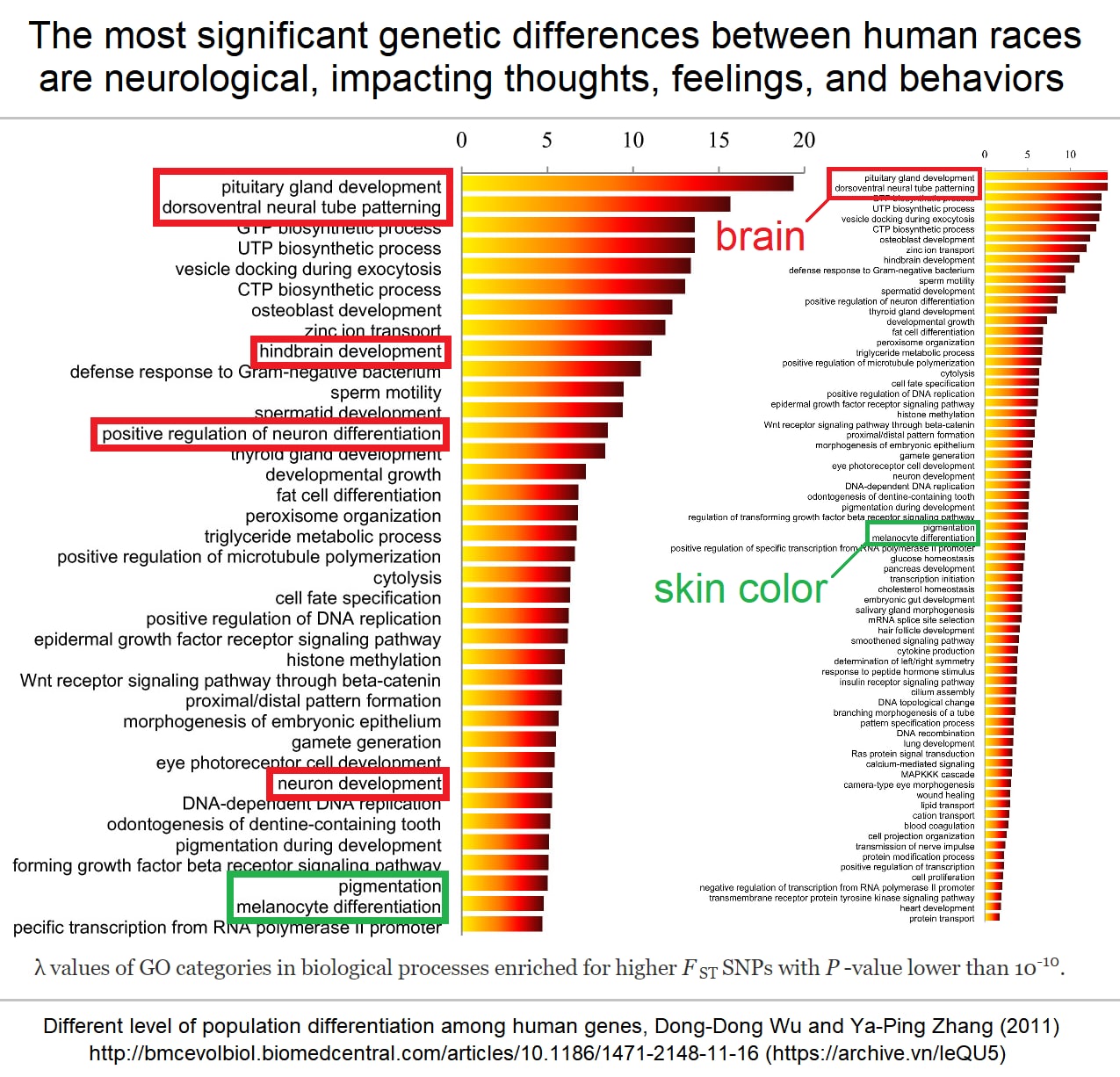
There’s definitely many, many more genetic differences and examples of biological racial differences than what are shown on this inexhaustive list. With so many examples showing how different human populations evolved different physical and internal adaptations to become more physically fit in their environments, how could anyone reasonably deny that different populations didn’t also evolve to have different mental and behavioral traits?[3]
2.6. Organ Transplants
Race matters in transplant surgeries. Simply put, you can’t mix-and-match body parts from different races. If you put a white organ in a black body, it will almost certainly be rejected, and vise versa. To successfully transplant an organ onto or into another person, the donor needs to be a genetic match, i.e. of the same race. As a result, mixed-race people have an incredibly difficult time finding suitable transplant donors.
Every race denialist inists that race is not real (i.e. race is not biological) until someone needs an organ transplant. But don’t take my word for it, listen to the medical professionals.
 |
 |
 |
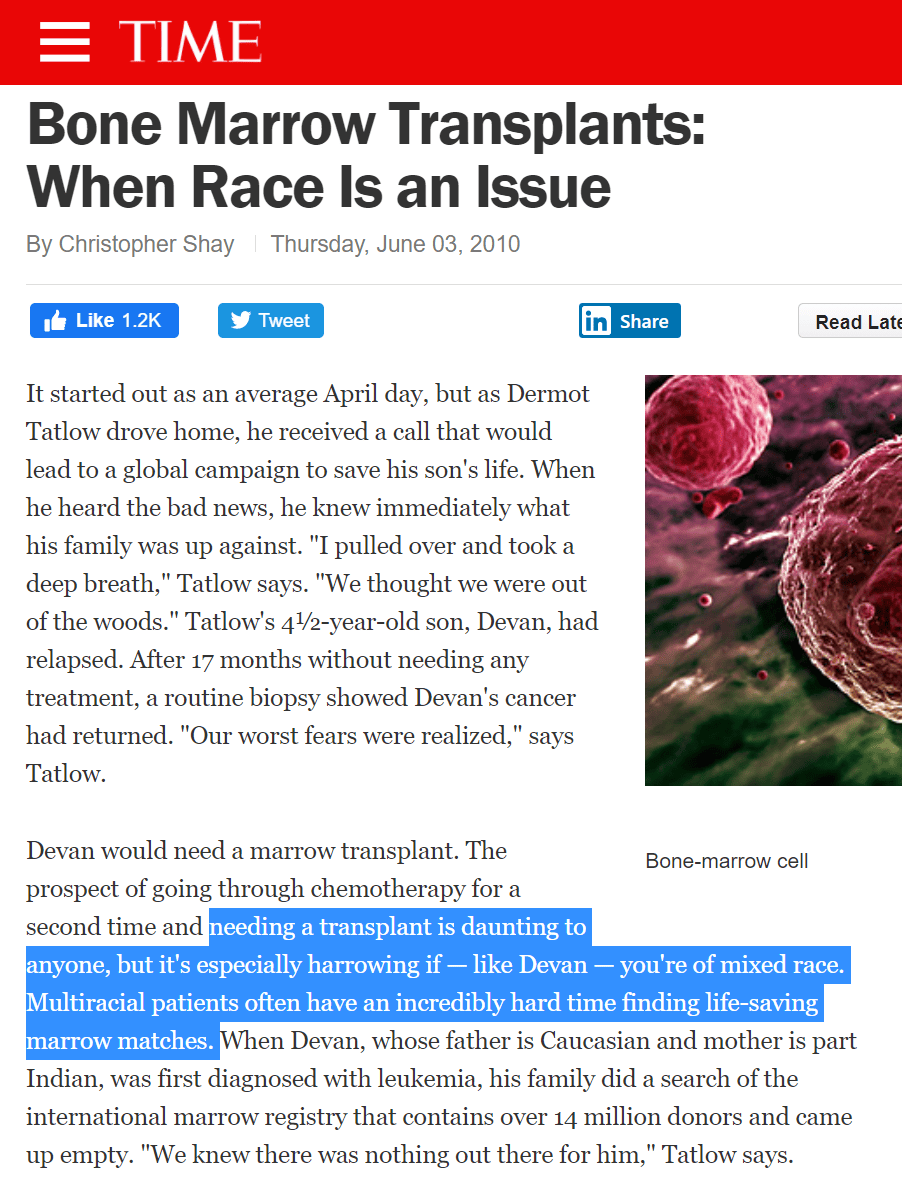 |

2.7. Athletic Performance
Video: The Role Race Plays In Sport - B4 FleX.
Most of the text in this section was transcribed from B4 FleX’s video, The Role Race Plays In Sport. However, we must first note the following disclaimers, which make it difficult to discern how genetics affects athletic performance:
- Western Privileges: Access to better nutrition, facilities, and financial opportunities in Western countries often boost athletic success, which makes it difficult to discern genetic factors.
- Inherent Advantages: Different groups may have anatomical or genetic predispositions to certain sports, but these can be outweighed by other factors like culture, training, and opportunity.
- Genetics Isn’t Everything: While genetics can provide certain advantages or disadvantages in sports, hard work and training are crucial.
- Limited Data: There is limited research on the athletic capabilities of underrepresented groups like Native Americans, Southern Africans, Indians, and Aboriginal Australians.
The Known Factors That Can Affect Athletic Performance
- Anatomy & Somatotypes: Height, limb/torso ratios, body mass, etc. Source
- Ectomorph: Slim, struggle to gain weight/muscle.
- Mesomorph: Muscular, athletic.
- Endomorph: Stockier, easily gains fat/muscle.
- Muscle Fiber Types
- Type 1 (slow-twitch): High endurance, aerobic, useful in long-distance sports. Source
- Type 2 (fast-twitch): Explosive power, anaerobic, useful in sprinting, jumping, bodybuilding. Source
- West Africans have less red blood cells and lower hemoglobin, due to the prevalence of malaria. Since slow twitch muscle fibers use aerobic respiration, West Africans have less slow twitch muscle fibers to compensate for having less hemoglobin. West Africans thus have more fast twitch muscle fibers, which use anaerobic respiration and thus don’t need red blood cells. Source
- VO2 Max: Maximum oxygen intake during exercise, important for endurance.
- ACTN3 Gene: Known as the “speed gene”; contributes to muscle power in fast-twitch fibers.
- Myostatin: GDF8 gene controls muscle growth; Myostatin deficiencies increase muscle growth. Source
- Grip Strength: Varies by race. Source
- Androgens: Hormones (e.g. testosterone) that influence muscle and bone growth. Source
- Culture & Money: Cultural emphasis and wealth can shape athletic participation and opportunities.
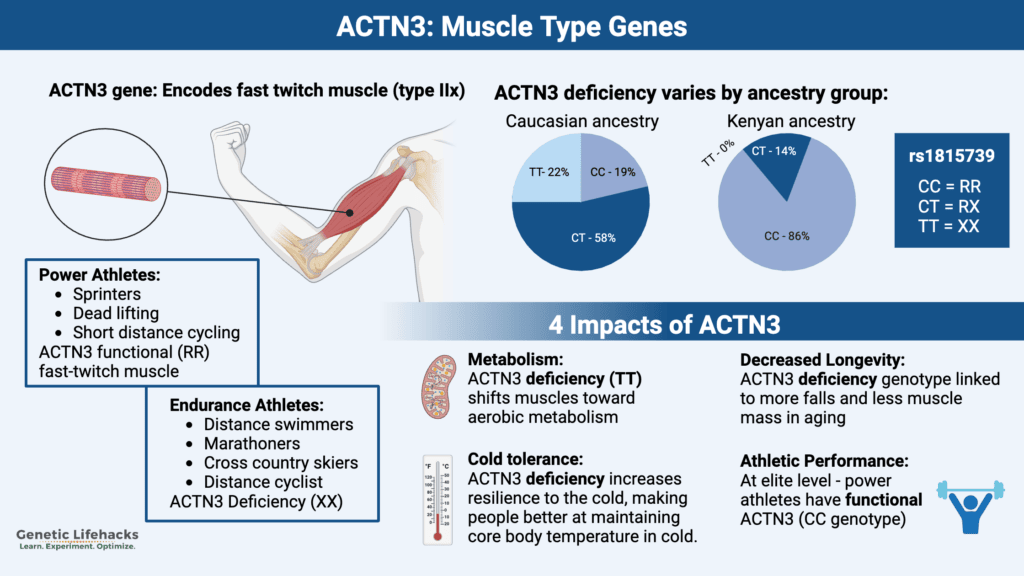
2.8. The Known Athletic Advantages and Disadvantages of Various Racial Groups
- West & Central Africans
- Dominance in Power Sports: Sprinting, basketball, football, boxing.
- Anatomy: Most mesomorphic people in the world. Narrow builds, longer limbs, high calf insertions, longer Achilles tendons, shorter torsos (advantage in sprinting, jumping).
- Genetic Advantages: High prevalence of ACTN3 RR genotypes, low myostatin (allows greater muscle growth), and high testosterone.
- Africans are not well-suited to swimming since they have a narrow build, as well as denser bones and less body fat, which make it easier to float in water.
- The center of gravity for Western Africans is 3% higher above the ground than Europeans. This gives sub-Saharan Africans an advantage in running, and Europeans an advantage in swimming.
- Although Africans have the muscles necessary for performing in strongman competitions, they are at a disadvantage due to their narrow structure, shorter torso, and shorter heights. Another factor is that there aren’t a lot of Africans competing in those sports to begin with.
- East Africans
- Dominance in Endurance Running.
- Anatomy: Most ectomorphic people in the world. Long legs, thin ankles, thin calves, long Achilles tendons, low overall body fat, low body weight, high VO2 max due to high-altitude living. Source 1, Source 2, Source 3
- Muscle Fibers: High percentage of Type 1 muscle fibers, suited for endurance.
Best ACTN3 genotype profile after West Africans.
- Europeans
- Dominance in Swimming, Strongman, Powerlifting, Weightlifting.
- Anatomical Advantages: Endomorphic, wider shoulders and chest clavicles, longer torso, shorter limbs (good for levers in strength sports), lower bone density (good for swimming). Source
- Cultural and Financial Influence: Western countries host more sporting events, leading to greater participation and success.
- Pacific Islanders
- Warrior Heritage: Origins in voyaging and close combat warfare.
- Physique: Stocky builds, strong muscles, high fat retention (useful for strength and power sports).
- Sports Focus: Excel in rugby and American football. Underrepresented in strongman competitions.
- East Asians
- Dominance in Weightlifting: Particularly in lighter weight classes.
- Anatomical Advantages: Most endomorphic people in the world. Shorter limbs with lower centers of gravity, which both benefit strength-based sports.
- Cultural Influence: Early training and professional coaching for weightlifting is culturally prioritized.
- South Asians
- Genetic Limitations: Shorter and more endomorphic, highest prevalence of ACTN3 XX genotype.
- Cultural Factors: Sports not as prioritized as academics; common vegetarian diets may limit creatine intake, which is important for muscle building.
- South Asia had 10-15 major famines within 200 years in the 1700-1900s (Link 2, Link 3). As a consequence, South Asians evolved traits that are adaptive to surviving famines, including: smaller frames, low lean muscle mass, insulin resistance, and higher body fat percentages.
- Mixed-Race and Other Groups
- Mixed-Race Individuals: May inherit favorable or unfavorable traits from multiple ethnic backgrounds, giving them advantages and disadvantages in different sports.
- Middle Eastern and North African: Diverse genetic backgrounds, often mixed with European, African, and Asian ancestry.
Article: Are Africans better runners? - Aporia Magazine.
Article: The Great Race: Why is the 1500 meters so diverse? - Steve Sailer.
3. Why Does It Matter That People Accept That Race Is Biological?
Because race realism is the best scientific explanation for differences in crime rates, academic achievement, and success between different races in the modern world. If we completely rule out the best explanation, deny the influence of biology on human outcomes, and make it evil to challenge the Left’s denial of biology, then the Left has free reign to come up with all sorts of insane, ridiculous, and racist anti-white conspiracy theories and explanations to account for the achievement gaps between races. These mistaken beliefs motivate the Left to pursue “solutions” to the achievement gaps that involve dismantling meritocracy and thwarting criminal justice at every opportunity with extreme zeal and steady progress. This is really bad if civilization is to have a decent future.
On the other hand, if people can be convinced that racial outcome gaps are caused by genetic differences instead of environment factors, then people will stop believing in hidden forces and conspiracies. The result is that meritocracy and criminal justice will be preserved, instead of being dismantled in the name of “racial equality”. If we want to preserve civilization, then we need millions of people to come to terms with biological realism. It’s the truth. A Hereditarian Revolution will be necessary for permanently ending the cycle of wokism.
TL;DR: Accepting race realism eliminates the justification for many detrimental social policies in the West, including demographic quotas, mass immigration, “anti-racism”, etc.
3.1. But knowledge about racial differences could be used to justify racism.
First, opponents should clarify what they mean by “racism”. Most people can’t agree on what “racism” is or should be. “Racism” is a loaded term that means different things to different people.[4]
Race realism is a collection of truth claims. Racism is a negative value judgment(s) towards a race(s).[5] Truth judgments don’t imply value judgments. Race realism thus doesn’t imply racism. If truth judgments can be considered “racist”, then racism is little more than a dismissive label for shutting discussions, an attempt to move the goalpost, and an incoherent concept.
See: Wikipedia: Fact-Value Distinction.
“If it is ever documented conclusively, the genetic inferiority of a race on a trait as important as intelligence will rank with the atomic bomb as the most destructive scientific discovery in human history. The correct conclusion is to withhold judgment.” – Eric Nathan Turkheimer, 1990.
This is essentially a Pascal’s Mugging Argument. Promoting race realism is supposedly an information hazard. Turkheimer and his ilk are making the following implicit assumptions:
- It’s possible to ignore the reality.
- The harms of accepting the truth are certain and severe.
- The harms of perpetuating the lie are mild and hypothetical at best.
- It’s presumably worth denying reality because denial will somehow help underperforming races.
- Society won’t be rational enough to fully understand the implications of biology, statistics, probabilistic inference, and the truth | value gap.
These beliefs are all fallacious and/or unfounded.
To be ignorant of racial differences is equivalent to denying racial differences, which is equivalent to denying reality. We can ignore reality, but we cannot ignore the consequences of ignoring reality. Even if we wanted to ignore racial differences, we could never completely ignore them in practice. The biological reality of race is still evident when people need organ transplants, when some people are at risk of disease but not others, why racial disparities continue to exist despite social intervention, who tends to wins Olympic sports, and much more.
To argue that race isn’t real is to also reinforce the assumption that racial achievement gaps are completely environmental and must be caused by some sort of historical “social injustice”, which leads to support for “Critical Race Theory”, demographic quotas, and anti-white and anti-Asian racism in order to make up for those gaps. We don’t see how that’s any better. If it is indeed the case that different races are genetically predisposed to have different behaviors, then we ought to accept the reality. There will be grave consequences if society continues to deny reality.
Denying racial differences on a societal scale would ultimately require massive censorship. Even Steven Pinker concedes he “cannot muster an argument for censorship or punishment”.
Furthermore, knowledge highlighting racial and genetic diversity doesn’t always have to be negative, nor should it be. If different races (and different people) tend to have different strengths and weaknesses, then it makes sense for a rational society to figure out how to leverage every person’s strengths, while brainstorming how to mitigate or cover every person’s weaknesses. This cannot be done if we ignore racial and genetic differences. Diversity and specialization should go hand in hand.
Lastly, we’ve clarified that averages and outliers exist for all races, which makes it irrational to discriminate against people by race, instead of by individual characteristics.
While Eric Turkheimer explicitly denies race, other leftist scholars instead avoid talking about it (usually or always). These include but are not limited to: Steven Pinker, Sam Harris, and Scott Alexander.
A leaked private email reveals that Scott Alexander knows that Hereditarianism is true to some extent, but he doesn’t want people to know that he believes that. Apparently, Scott Alexander cares more about maintaining optics and popularity, rather than spreading truth.
These closeted race realists are foolish. I’ve already explained why. When the truth eventually becomes mainstream, they will look like cowards. They are making fools of themselves and they are ruining their legacies. They are no different from the anti-intellectuals who denied evolutionary theory in the mid-to-late 1800s in order to vainly defend the old status quo.
Discussing racial differences in intelligence and other socially valued traits is incendiary, and in many contexts inappropriate. The social norms that restrain such discussion are not arbitrary. Race is contentious because multi-racial societies are fragile, perpetually threatened by resentment and conflict. I do not think that a politician should casually joke about racial differences in intelligence.
Yet in certain contexts, judicious conversation about these differences is not merely permissible but necessary. Diversity is here to stay, and we must learn to live with it. Part of that task is learning to discuss it honestly. If we do not supply accurate answers to serious questions about racial disparities, the left will gladly supply inaccurate ones. And if those answers become dominant, many will come to believe that liberalism itself is nothing but a procedural disguise for white supremacy, and they will become avowed enemies of liberalism. I do not think liberalism can endure many more enemies.
– Bo Winegard, “Pinker is wrong: We should “go there””
But race realism has been used as an excuse to justify slavery, segregation, and racism during the Age of Colonization.
That is true, but that’s not an argument against race realism. If people are dedicated to being racist, they’ll think of anything to rationalize their beliefs. Regardless, recognizing differences between humans does not imply hatred of humans. People who believe “we ought to treat people the same regardless of race” aren’t going to start suddenly hating other humans if it’s revealed that IQ distributions and other behavioral and physiological characteristics vary by race. If anything, recognizing differences between humans is important for forming a functional society.
Most white Americans would say that their own racial group is relatively unoppressed, compared to the much larger than the fraction of non-whites who say that non-whites are more oppressed than whites in the US.
Even if this is true, who cares? The Standpoint Theory of Truth is not a valid theory of truth. It’s meaningless and it has no predictive or explanatory power.
3.2. Are all race realists racists and/or white supremacists?
The short answer is: No. There is nothing contradictory about being a race realist and non-racist. Even when I first heard of race realism, I mistakenly thought that it was a racist ideology, since I didn’t know or understand what it is, and since this is a common misconception.
While discriminating is a necessary part of life, racism is a form of irrational discrimination. White supremacy and all other race supremacist beliefs are better categorized as race idealism, not race realism. “Race Idealism” is equivalent to “Scientific Racism” on the Venn diagram below.[6]
Sometimes, race realists are also labeled “Nazis” or “fascists”, but these terms are meaningless epithets. Nowadays, “Nazi” and “Fascist” are typically used for describing any ideas that people merely don’t like, so they’ve lost their original meanings.
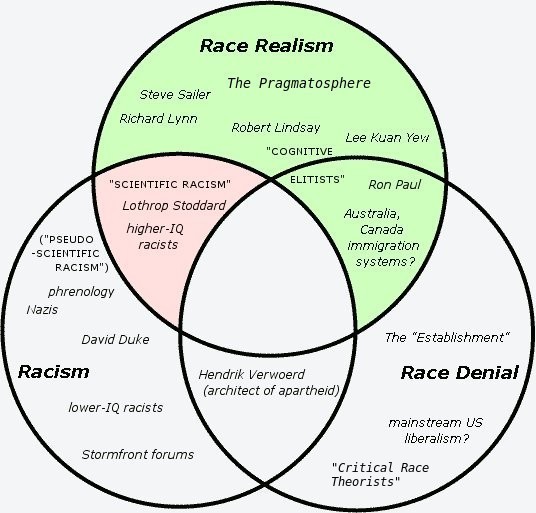
We do not advocate that some race(s) be given greater legal privileges than other races. We believe that all people from any race should be entitled to the same legal rights as anyone else. Over time, eugenics could even erase the achievement gaps and discrimination between races, if enough natural selection occurs. This would maximize true racial equality because all the world’s races would be as intelligent, low-crime, and productive as any other.
All race realists acknowledge that Ashkenazi Jews and East Asians have the highest average IQs (and lowest crime rates) of any race on Earth. This is verified by the consistent results on culture-free IQ tests. If race realism was just pseudoscience that’s intended to justify white supremacy, then whites would be shown at the top of the IQ tests, but that’s not what the data shows.
Lastly, I (Zero Contradictions, the author of this blog) am half European (mostly German) and half Japanese and Cantonese. I am certainly not a white supremacist since I am mixed-race, as is most of my entire family since both of my parents, all my siblings, and all of my aunts and uncles are also hapas. Likewise, JayMan (who made multiple contributions to these FAQs), Lipton Matthews, and B4FleX are examples of black race realists. Clearly, race realists can be of any race, which contradicts the belief that race realism is motivated by racism, rather than rationality.
Read More: The Difference Between Race Realism And Race Idealism.
Read More: Race Denial vs Racism: A False Dichotomy – Anatoly Karlin.[6]
3.3. Do race realists believe that some races are better than others?
This depends on what is meant by “better”, and in what context. No respectable race realist would say that there is a “master race” or a “racial hierarchy”, because the whole reason why races are different from each other in the first place is because they each evolved genes and traits that enhanced their ancestors’ ability to reproduce in their respective environments. Race realism is about understanding that every race has genes and traits that made them more reproductively successful in their ancestral environments. Hence, different races tend to excel at different things.
Even if it were the case that one race was often “better” than the others on average, there are still statistical outliers for every race. Hence, it’s not reasonable to treat people differently based on nothing but their race.
Meritocracy is a hill that I will die on. Unfortunately, race denialists don’t believe meritocracy, because they believe in holding back relatively successful demographics, like Whites and East Asians. Also unfortunately, racist race realists (and especially racists in general) don’t believe in meritocracy either, because they believe in holding back exceptional people who come from underperforming races. Non-racist race realists are the only ones who fully embrace meritocracy.
Read More: Are Smart People Superior? A Reply to Noah Carl and Charles Murray - Nathan Cofnas.
3.4. If race realists don’t necessarily have to be racist, why are so many of them racist?
Part of this has to do with memetics and how ideologies evolve over time. As explained in “The Rise and Fall of the Alt-Right”, the Alt-Right started out as an intellectual movement, until it degenerated into a Utopian Ideology that got dumber and dumber since ideologies need to tap into human emotions in order to propagate most effectively. When the ideology started spreading via emotions instead of reason, this caused all sorts of purity spiraling where the leaders and members of the movement started promoting less rational and more extremist ideas in an attempt to claim status over other members of the movement. “Status Pyramid Schemes” talks more about how memetic ideologies propagate and evolve in general.
The second reason why some race realists tend to be racist is that racist people are more likely to likely to believe that there are innate genetic differences between races in general. But they don’t necessarily have the intellectual or the bio-evolutionary knowledge for fully understanding race from a scientific perspective.
Nevertheless, the promotion of race realism doesn’t need to be driven by racism, emotions, or deplorable claims to social status, nor does it need to conclude that different races should have unequal rights or be treated unequally. Race realism is ultimately supported by reason and scientific evidence. There are some racist people who promote race realism, but that doesn’t invalidate the facts. To insist otherwise is a guilt by association fallacy.
3.5. To argue race is real is to argue genes are real, which is to argue for Gattaca.
Eugenics would increase the differences between those who practice it and those who don’t. But if governments subsidize IVF and embryo selection, then eugenics could be made more affordable to everyone. Instead of worrying whether or not eugenics accelerates inequalities, we should focus on lifting everybody up, so that everybody wins. Subsidizing IVF might initially increase government deficits, but it would pay off in the long run by making the population healthier and smarter, so governments might be able to reduce public spending on healthcare and education.
In the 2004 democratic transhumanist book Citizen Cyborg, bioethicist James Hughes criticized the premise and influence of the film Gattaca as fear-mongering, arguing:
- Astronaut-training programs are entirely justified in attempting to screen out people with heart problems for safety reasons.
- In the United States, people are already screened by insurance companies on the basis of their propensities to disease, for actuarial purposes.
- Rather than banning genetic testing or genetic enhancement, society should develop genetic information privacy laws such as the U.S. Genetic Information Nondiscrimination Act signed into law on May 21, 2008 that allow justified forms of genetic testing and data aggregation, but forbid those that are judged to result in genetic discrimination. Citizens should then be able to make a complaint to the appropriate authority if they believe they have been discriminated against because of their genotype.
The numbered list above was copied from the Gattaca Wikipedia Article, under CC-BY-SA 4.0.
More to the point, most people underestimate how much social status is determined by genetics. Humans have essentially lived under social caste-based societies with low, stable social mobility for nearly all of human history. We already live in a world where intelligence, fitness, social status, socio-economic mobility, etc are all mainly determined by inheritance. Hence, there is no reason to fear or believe that accepting eugenics and race realism would lead to a Gattaca-like world that’s much different from the one that we currently live in.
Read More:
- Gregory Clark’s Body of Research.
- Manifold Podcast Episode: Genetics and Social Mobility - Gregory Clark.
- Social Mobility Hasn’t Really Changed In 400 Years - Gregory Clark.
- The Grandchildren Of China’s Pre-Revolutionary Elite Are Unusually Rich - The Economist.
- The Wealthy in Florence Today Are the Same Families as 600 Years Ago - The Wallstreet Journal.
3.6. Why would underperforming demographics benefit from accepting biological realism?
Quote from But knowledge about racial differences could be used to justify racism - Race FAQs:
To be ignorant of racial differences is equivalent to denying racial differences, which is equivalent to denying reality. We can ignore reality, but we cannot ignore the consequences of ignoring reality. Even if we wanted to ignore racial differences, we could never completely ignore them in practice. The biological reality of race is still evident when people need organ transplants, when some people are at risk of disease but not others, why racial disparities continue to exist despite social intervention, who tends to wins Olympic sports, and much more.
Furthermore, knowledge highlighting racial and genetic diversity doesn’t always have to be negative, nor should it be. If different races (and different people) tend to have different strengths and weaknesses, then it makes sense for a rational society to figure out how to leverage every person’s strengths, while brainstorming how to mitigate or cover every person’s weaknesses. This cannot be done if we ignore racial and genetic differences. Diversity and specialization should go hand in hand.
- Meritocracy ultimately benefits a far greater number of people. The only people who wouldn’t benefit from meritocracy are those who would gain power by preventing meritocracy.
- Eliminating racial disparities won’t eliminate disparities in general. Eliminating one type of inequality will only make other types of inequalities matter more. Nevertheless, a true meritocracy should eliminate disparities that are caused by environmental factors, in order to function properly.
- If people from underperforming demographics are chosen for prestigious positions in a system with no demographic quotas, then they won’t have to worry about if they were merely diversity hires. They will know that they were chosen because they were the best person society had to offer for filling the position at that time.
- Societal improvements that help everybody will help underperforming demographics as well. This website proposes many ideas for improving society as a whole. For example, we theorize that Georgism would boost economic prosperity, which would collectively benefit everybody, regardless of how disadvantaged a person may be. Even if some amount of inequality between people is inevitable, it may not matter if everybody is able to achieve and afford a decent standard of living.
- See: Why Does It Matter That People Accept That Race Is Biological? - Race FAQs.
- By understanding the true causes of racial disparities, we can figure out how to address them and eliminate them more efficiently. Finding the truth is instrumental to achieving values.
- If some races have stereotypes that negatively affect how other people perceive them, then we need to ask why those negative stereotypes persist:
- If a minority of Black people are criminals or have been criminals, then that minority of people is creating a bad perception of the entire demographic as a whole. The actions associated with the criminal minority are partially holding the majority back. So, if we can imprison or eliminate that criminal minority, then the rest of the people in that demographic will benefit from a naturally more positive public perception and stereotype.
- It only takes a few people from a demographic to create a negative stereotype that ruins the public perception of the demographic as a whole. Just a few people ruin things for everyone else.
- More succinctly, if we want to improve the public perception of some demographics, then we need to eliminate the people who are creating negative perceptions of the demographic, and thus ruining the public perception of the demographic as a whole.
- As the collective performance of their demographics improve, the negative perception of those demographics having higher crime and lower intelligence will disappear, which will benefit people from those demographics more and more as they get better and better.
- Instead of pretending that the stereotype and what causes the stereotype doesn’t exist, the biological realists acknowledge it and address it directly.
- Increasing policing and locking up criminals in neighborhoods that have high crime rates would reduce the amount of crime in those neighborhoods. This would benefit all the people living within those neighborhoods, and make them safer places to live, which could help eliminate the main environmental factors that are holding back the demographics who live in those neighborhoods.
- The government can and should subsidize IVF and embryo selection for everyone. This will make it easier for underperforming demographics to have more intelligent and higher performing children. China and Israel already subsidize IVF for their entire populations.
- If we can acquire the necessary political will for enforcing reproduction licenses, it will further reduce or eliminate racial disparities over time. Eugenics would help select for better people from those races, which would put people from those races on more equal footing with everybody else.
- Reproduction licenses would make it harder to have children, which would make having and raising children higher status. This would probably reduce the population of single parent households and fatherless black children. Currently, many black men choose to seek status by being violent thugs and getting reproductive free rides.
- Legalizing all victimless crimes would help reduce the police force’s supposed racial bias towards Blacks and Hispanics. The drug war is unwinnable, and a methodical approach to decriminalizing drugs would be best for addressing and reducing the abuse of harmful drugs.
- Increasing gene flow with other races could help reduce the disparity gaps between high-performing and underperforming groups.
- It’s likely that the human race will probably mix into some sort of global race in the distant future, as race mix continues, if modern civilization manages to persist.
- If underperforming groups increase their performance, that will encourage more race-mixing, which will increase gene flow, which will cause some positive feedback loops for making those groups on a more equal level with the higher performing groups.
- Fortunately, all of these proposed ideas have positive feedback loops with each other.
- Underperforming races would benefit enormously from race realism. They would stop going through life convinced they were cheated. They would lose much of their resentment of whites. They would learn the invaluable lesson that success or failure depends overwhelmingly on their own talents, not what whites think of them.
- Black/white relations – and no one claims they are good – would benefit enormously from race realism. If many blacks did not obviously resent whites, race relations would be much less fraught with tension. If whites didn’t have to worry constantly about “privilege” and “microaggressions” and “unconscious bias”, they would have less reason to avoid blacks and better relations with the ones they know.
- Finally, if society were honest about race, the forces that created Dylann Roof, Patrick Crusius, and Payton Gendron would be much weaker. Is it surprising that some young whites get angry when they are taught that they are oppressors, have no history to be proud of, and that their eventual replacement by non-whites will be a triumph of diversity? Violent, sickening acts are even more likely when dissident views are suppressed and called “hate” or “white supremacy”.
- People who have a voice speak; people who are silenced express themselves in other ways. Brenton Tarrant is an Australian who shot up two mosques in Christchurch, New Zealand. He was opposed to mass, non-white immigration, which he thought threatened the white majority. I feel certain that if there had been a full, public debate on the pros and cons of Muslim immigration, and on the pros and cons of reducing the white percentage of the population through immigration, he would not have killed anyone. – Jared Taylor, America Must Have Race Realism
What Needs To Be Done To Reduce Crime Rates
In order for a police force to be truly effective, it’s necessary for it to monitor areas with higher crime rates. Effectiveness is measured by the police’s ability to stop and deter crime. Areas with higher crime rates may happen to have higher Sub-Saharan African, Amerindian, or Hispanic populations, but that doesn’t make it “racist” for police departments to monitor those more closely and more often. The problem with ghettos is the people who live in those places.
If anything, the best thing that whites could do for blacks is to police the hell out of those neighborhoods. Increased policing imprisons people who would otherwise be repeat offenders and/or make more offspring who are genetically predisposed to become future criminals. It also increases the game-theoretic pressure to avoid committing crimes, Increased policing will lead to less crime. Less crime thus leads to increased safety and greater prosperity for all.
Why should we care that underperforming demographics are able to perform well?
In order to end wokism, it is important that underperforming demographics understand how accepting biological realism could benefit them. One of the biggest reasons why such demographics support wokism is because they believe that they will benefit from woke policies. If people don’t understand how the world would benefit from accepting biological realism, then they are unlikely to support it. They need to understand that it is disadvantageous to let wokism continue.
3.7. How likely are people to accept race realism in the future?
This will depend on how events and social movements play out over the next few decades, but I think more and more people are going to gradually come to terms with race realism as the years go by, since the truth is on our side. Other race realists are less optimistic:
I’m not delusional. I don’t think HBD can ever become a super popular, or maybe even mainstream position. It will morph into the category of perennial questions that nonetheless have right answers, like free will vs determinism. But it’s also irrational to think the taboo can remain forever: entropy applies to societies as well as objects. – Sebastian Jensen, “When will the race taboo disappear?”
To the contrary, it will probably be easier to persuade people of race realism. Although a correct understanding of free will and determinism is less morally taboo than race realism, there are more serious real world consequences to denying race that would probably be more obvious to people. The Great Replacement will make it harder for leftists to impose demographic quotas on prestigious positions and careers. Imposing slave reparations would cause unprecedented social backlash. Reality will have consequences if people try to deny it. There are also many important social questions that necessitate examining race and IQ. Source For Table Below.
| Question | Why It Requires Examining Race And IQ |
| Why do nations differ in average wealth and development? | Cognitive ability correlates with national productivity and institutional quality. |
| Why do educational outcomes vary so consistently between groups? | IQ differences are strong predictors of academic achievement. |
| Why are certain groups overrepresented in science and professional fields? | Cognitive profiles influence occupational sorting and representation. |
| Why have decades of social policy failed to equalize outcomes? | Persistent disparities may reflect both environmental and cognitive factors. |
| Why are crime and incarceration rates uneven across populations? | Intelligence is inversely correlated with crime; ignoring this limits explanation? |
| Why do socioeconomic gaps remain stable across generations? | Intergenerational transmission of cognitive traits may contribute to enduring inequality. |
The rise and adoption of embryo selection in the 2020s, 2030s, and so on will probably also cause more people to accept eugenics, which will cause more people to accept that intelligence and other racial disparities are mostly genetic.
Persuading people to accept race realism will have to be a bottom-up grassroots social movement. Most of the Establishment is currently under woke/leftist control. There are also many people who believe in race realism, eugenics, and other taboo beliefs and values, but they don’t espouse their beliefs publicly because they know that they will face cancel culture and other negative social consequences for doing so (e.g. Scott Alexander). For these reasons, it’s safer to persuade people anonymously through the Internet and through one-on-one conversational exchanges. I encourage everybody who’s this webpage to be helpful or informative to spread the word and share this page on social media.
3.8. Averages and Outliers
The possibility that statistical outliers may exist within a data set is a major reason why racism is irrational. Even if race A has consistently lower crime rates and consistently higher average IQs than race B, it would be dangerous to assume that that would be the case for every single person belonging to race A. It would be equally wrong to assume that every single person belonging to race B is going to be less intelligent or more likely to commit crimes that every single person from race A. In order to ensure a meritocracy, individuals must always be treated based on merit, not congenital demographic properties.
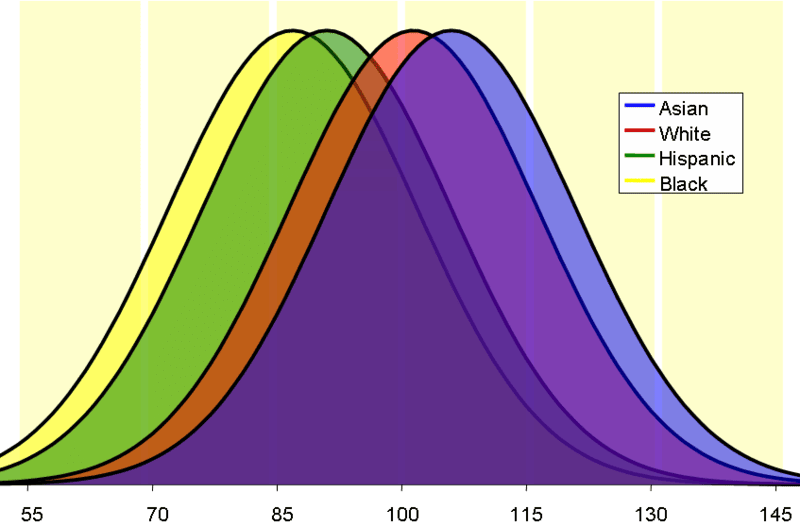
It’s true that Amerindians and Sub-Saharan Africans commit disproportionately more crimes than Europeans, East Asians, East Indians, etc. But it is simultaneously true that most people from those races are law-abiding and don’t commit any crimes. Similarly, the smartest people who ever lived may have been European or East Asian, but that does not conclude that every European or East Asian is going to be a genius. Generally speaking, the people who commit crimes and the people who have built humanity’s greatest inventions tend to be on the extreme tail ends of the normal curve(s). For further explanation of these statistics, see: Contra Jared Taylor - Eternal Anglo.
The percentage of murderers who are Black is not the same as the percentage of Blacks who are murderers. To describe this mathematically with Bayesian notation, we could write:
- P(Black | Murderer) > 50%
- P(Murderer | Black) < 5%
Read More: Understanding Regression to the Mean.
4. Addressing Objections To Genetic Differences In Intelligence
4.1. Hasn’t Academia debunked race realism as anti-scientific pseudoscience?
No, it hasn’t. In summary:
- Biologists are less likely to deny race than anthropologists.
- People who study animals are less likely to deny race than people who study humans.
- Hereditarianism is the majority opinion among intelligence research experts.
- Since the 1600s, scientists have divided humanity into around five major biological or ’racial’ groups.
- Human “races” were historically viewed as distinct subspecies, based on intuition alone. It turns out that most of those intuitions were largely correct.
- Denying the biological validity of race and the existence of these five major racial groups was popularized after the 1960s, spiking around the 1980s.
- Present-day Western scientists, who are located in the epicenter of race-denialism, are split around 50/50 on the issue of race, while the rest of the world accepts race as a basic fact of nature.
- By contrast, the global scientific consensus is overwhelmingly opposed to race-denialism. The more politically and geographically distant a country is from the West, the less likely its scientists are to deny the biological validity of race. Most Chinese and Eastern European scientists believe in race:
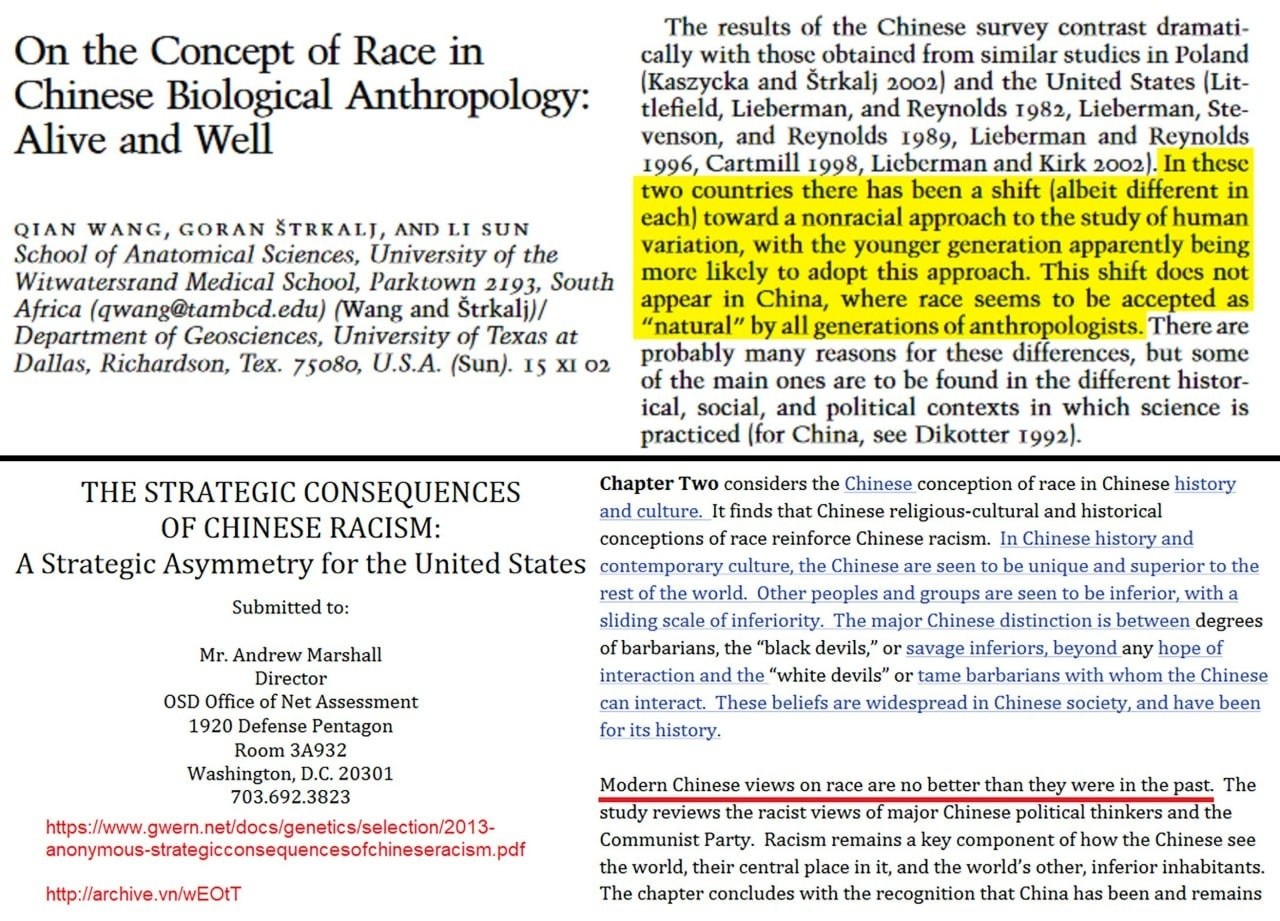 |
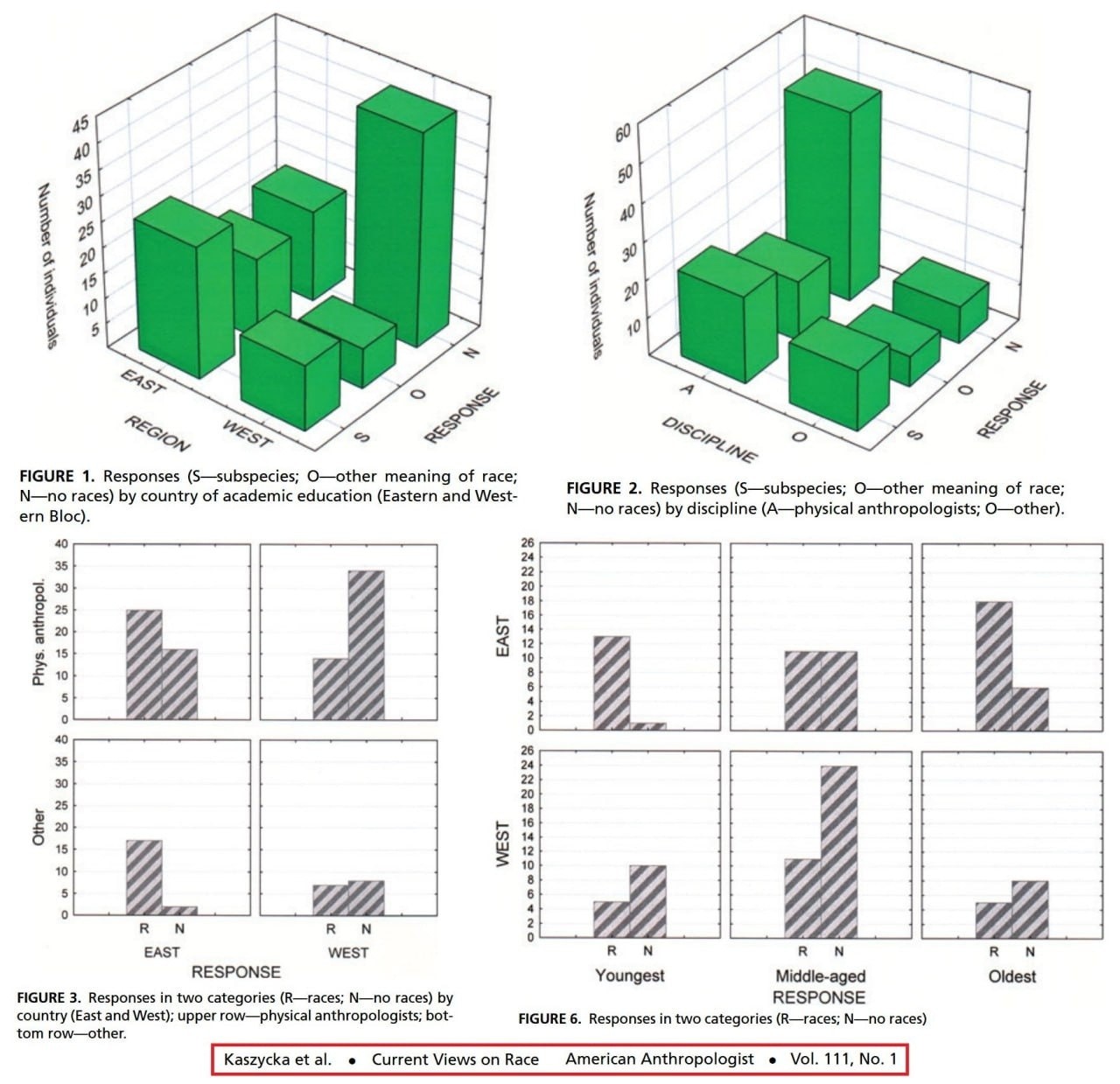 |
While we don’t endorse dividing humanity into the same five traditional racial groups, we do acknowledge that it reflected reality reasonably well, given the lack of further knowledge and the technological limitations of past times.
Let’s critique a misleading section from RatWiki, “Scientific consensus: Races aren’t useful”:
- The quotes in that section each repeat that racial categories are not discrete, even though all race realists already acknowledge this.
- Most of the quotes were cherry-picked from anthropologists, not biologists.
- Even among anthropologists, the survey had heavy selection biases (see below).
- RatWiki doesn’t want to show what the biologists’ consensus on race is, because it would expose how they’re misrepresenting the academic consensus on race.
- RatWiki’s editors are only interested in confirming their biases, not intellectual honesty.
RatWiki cites Jennifer Wagner et al. in the American Journal of Physical Anthropology (2016) as “proof” of a consensus among anthropologists on the supposed non-existence of human races. A closer examination of the study’s data and methodology reveals heavy selection biases:
- The sample was recruited from Anthropological Association (AAA), an organization dominated by cultural anthropologists.
- Cultural anthropologists were overrepresented among the professionals surveyed (53.81%).
- Only 28.31% of the anthropologists came from biology-related fields (17.83% archaeology, 10.48% from biological anthropology)
- Since the controversy of 2010 (the removal of the word “science” from the AAA’s strategic plan), many bioanthropologists have distanced themselves from the association.
- There is a lack of consensus among bioanthropologists, as shown in Table 6 of the study.
- Only 47% of biological anthropologists agree with “No races exist now or ever did”, compared to 53% of non-biological anthropologists.
- Only 37% of biological anthropologists agree that “Race has no biological influence on health”.
As a result, the average responses mainly reflect a sociocultural perspective, not expertise in population biology. The opinions of literary/cultural scholars are being misleadingly presented as a “biological consensus”.

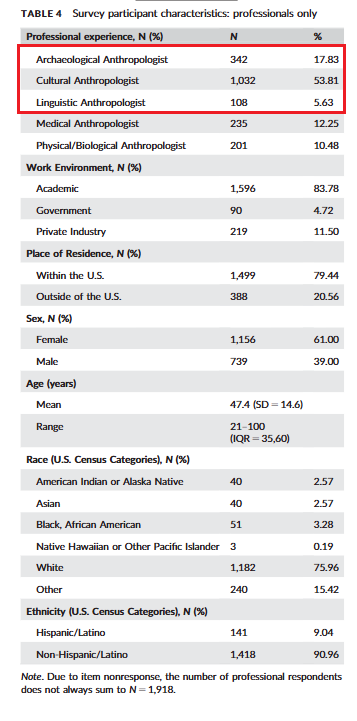 |
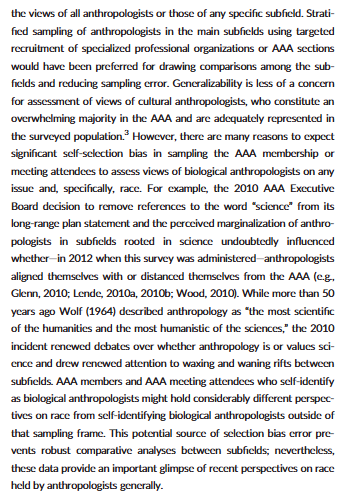 |
Read More: Is there a “Scientific Consensus” on the Existence of Human Races? - Thuletide.
Most race denialist academic papers usually follow a predictable six step formula:
- Advertise the scholarly credentials of the author.
- Characterize persons with opposing views as bumpkins.
- Demolish a strawman afflicted with “genetic determinism”.
- Make a small (and insincere) concession to opposing views.
- Proclaim allegiance to all that is politically correct and morally desirable.
- Assert that behavior X is immune to adaptationist analysis.

This question also assumes that Academia can generally be trusted, even though there are multiple reasons why Academia often cannot be trusted:
- Ideological Bias
- Perverse Incentives
- Social Circularity
- Naive/Fake Empiricism
- Statistical Manipulation (e.g. p-Hacking)
For the record, there is still a lot of valid, good-faith scientific research out there, but most of the academic “research” these days is either fake, redundant, plagiarized, out-dated, and/or useless.
Read More: A Rational Critique Of Academic Research.
But race realism has been justified by religious, moral, and pseudo-scientific claims.
That has been true historically, but recognizing the invalidity of those arguments does not disprove race realism. To say otherwise is an Argument from Fallacy. Just because the reasoning for an argument is wrong, that does not imply that the conclusion is wrong too.
4.2. But there’s no objective way to define “intelligence” or quantify it with IQ scores.
Saying “there’s no objective way to define intelligence” is not an argument against one definition or for another. We could just as easily say there’s no objective way to define “chair”. It’s technically true, but it’s tactical nihilism. Everybody still has general consensus on what a ’chair’ is. Likewise for intelligence.
So, we certainly can define intelligence. And IQ tests have been the best way to estimate it. IQ is a useful metric as long as you understand what it is and what it isn’t. The misconceptions about IQ revolve around misunderstanding what it measures, what affects it, and how it is calculated. Anybody who denies that it’s possible for IQ scores to be a valid measure of cognitive abilities would also have to reject the validity of all the other concepts in this list, lest they would have contradicting beliefs. Like many things, it is impossible to directly measure intelligence, so indirect measurements of intelligence are the next best information that we can collect and analyze.
IQ is a useful metric because it has predictive power for measuring things beyond “intelligence”, such as educational attainment, income, health, longevity, criminality, getting and staying married, etc. Indeed, the g hierarchy in the depiction below works for a host of other things past intellectual abilities. People who are good at IQ tests are hardly only good at taking IQ tests.
An individual’s IQ score will tend to be stable. That is, repeat testing will tend to give roughly similar results. We all know of occasions where we have freak results from tests, but if you tended to test significantly above average in one instance, you are likely to keep getting scores on the high side. IQ can be influenced by environmental manipulation, but there are also effective ways to eliminate that.
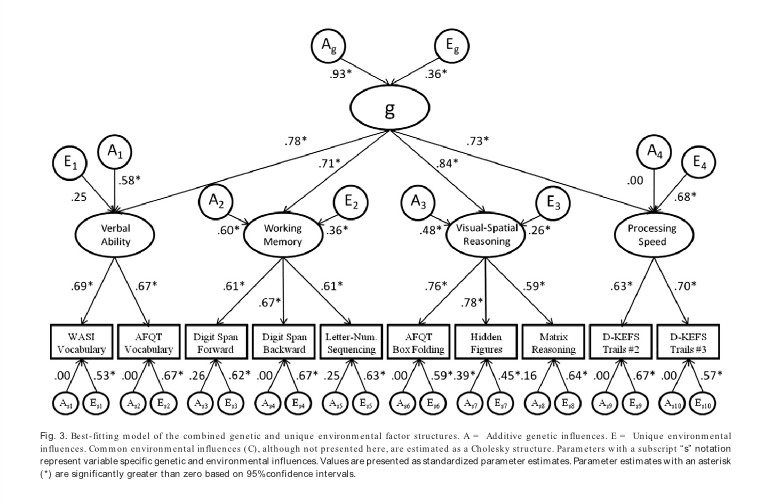
This is a schematic layout of the findings of one particular investigation to the genetic architecture of IQ (Panizzon et al, 2014), and captures our basic findings on the matter. At the top, and behind all cognitive ability is a central g factor (initially for “general intelligence”), which is behind the various major mental domains, which themselves have an impact on specific tested abilities, as seen here. The effectiveness of any mental endeavor, especially the more cognitively demanding ones (i.e. the ones that require you to “think”) will depend on an underlying mental “horsepower” so to speak. g is that horsepower.
Read More: Wikipedia: g factor (psychometrics).
There is no consensus on whether intelligence is genetic.
If this claim were true, then the difference in intelligence between a human and a chimpanzee (or any other animal) would have to be purely environmental. Only a modicum of common sense is needed to realize that this simply isn’t true. Intelligence is obviously affected by genetics. A more charitable interpretation of this claim is that there is no consensus on the extent to which intelligence is determined by genetics. In the rest of this essay, we can confidently say and explain why intelligence is mostly determined by genetics.
IQ tests are culturally biased against Blacks, Hispanics, and other ethnic groups.
If this claim were true, then Blacks and other ethnic groups should perform worse on IQ tests relative to their “true” intelligence. If so, then IQ tests would under-predict their real-world performance relative to Whites. But we see exactly the reverse. IQ tests over-predict the performance of individuals from lower-scoring groups, and Blacks do worse in real-life than we would expect from their IQ scores alone. Cultural bias cannot be an explanation, especially when we notice that each racial/ethnic population performs roughly equally well regardless of what country they live in. It’s hard to reconcile a “cultural” bias that seems to be consistent across different cultures. The simpler explanation is that Blacks have lower IQs due to genetic factors.
Read More: Bias is Often Unpredictable – Cremieux.
Additionally, we know that there are visible physiological correlates with IQ, such as head and brain size, as well various anatomical features of the brain, such as cortical thickness (Pietschnig et al 2014, Shaw et al 2006, Menary et al 2013, Karama et al 2011). A recent research team found that they were able to accurately gauge IQ from brain MRI imagery alone (correlation of 0.72 between prediction based on imagery and test-measured IQ (Wang et al 2015). Also see: Information Processing: IQ prediction from structural MRI (Steve Hsu, 2015).
Lastly, while we acknowledge that IQ is a valid measure of multiple cognitive abilities with strong predictive power for life outcomes, we caution against anybody who wants to extrapolate beyond IQ. There are many mental abilities that IQ doesn’t measure, such as the ability to learn or the ability to explain things. IQ also doesn’t measure psychological or personality traits within populations, such as psychopathy, aggression, extroversion vs introversion, etc. IQ isn’t everything, but it does accurately foreshadow many things, when it’s understood and used correctly.
Read More: The IQ Question.
4.3. But IQ has little effect on a person’s ability to accomplish tasks.
It can be difficult to reconcile the view that most traits are mostly determined at birth with day-to-day experience. Nothing I do all day seems biologically determined, but rather path dependent. I arrived late because there was traffic. I put on a sweater because it was chilly outside. Behavior geneticists mostly concern themselves with a handful of measures such as IQ, personality traits, socio-economic status, but anything more specific systematically comes out less heritable or less deterministic.
What good is it to know (again, to us simple folks) that high-IQ people will probably have high-IQ children if that knowledge becomes fuzzier and fuzzier the more specific the task/trait under observation? We are not usually interested in a highly aggregate measure such as IQ. We are interested in more specific questions, such as:
- Can this person code well?
- Are they right about X issue?
- Do they have a good memory?
IQ would be an indicator for these questions, but a weak one. Most high-IQ people can’t code, most are wrong about a lot of things. Knowing how to code is a lot more environmentally determined than IQ. Knowing how to code in python is even more environmentally determined. Knowing how to code applications in python even more so. Having coded one specific application? Hard to believe there is anything genetic involved in that.
The more specific a trait or a life event, the less genetically determined it is. We can also see this in reverse: things like IQ, personality traits and socio-economic status are highly aggregate measures, the single output of a very large amount of traits and events interacting together over a lifetime. That is why they are almost entirely determined by nature over nurture: the lifetime environment and specific mix-up of traits inherited at birth are mostly random, but aggregate measures bring patterns out of that swirling chaos.
How deterministic a trait appears in an individual should be expected to depend roughly linearly on how many lifetime inputs are involved in it, because estimating a trait amounts to taking a sample of our lifetime events. The statistical principles that make sample size important for measuring traits in populations are as applicable within individuals as they are without.
So, low predictability in specific traits or events is not a counterpoint, but an expected outcome. Put it in the “so what” folder with other anecdotes.
– Felix, “Aggregate traits”
4.4. No one has found a gene for intelligence, criminality, or any behavioral trait, so mental traits can’t be inherited.
This claim reflects a fundamental misunderstanding of genetics and how genes work. Firstly, the genome is not like a shopping list, where there is a 1-to-1 correspondence between each “gene” and some phenotypic feature. Rather, genes are like a recipe. Physical traits only emerge through the complex interaction of all the genes in the genome. As such, most traits (especially behavioral ones) are polygenic. They depend on the action of many genes, so the whole idea that there is a (single) “gene for” X trait is generally misleading. In fact, research shows that ~84% of all genes in the human genome are expressed somewhere in the brain (Hawrylycz et al, 2012) and approximately one-third of human genes are expressed primarily in the brain and during brain development (Douet et al, 2014). This creates a multitude of different potential behavioral phenotypes that people could have.
Moreover, some genes that cause different mental traits have been identified in humans, including for intelligence.[3] However, many of the genes and traits listed in that section were relatively easy to identify since they tend to follow Mendelian inheritance. Since non-Mendelian inheritance is actually more common for traits than Mendelian inheritance, some researchers have proposed emergenesis as a new theory for addressing the difficulty in identifying the relationships between genes and polygenic traits.
The other fallacy here is that it’s not necessary to know which genetic variants lead to variation in a trait to know that trait variation is affected by genetic variation. It’s true that there’s been little success in pinpointing the relevant genetic variants that produce variation in intelligence or behavioral traits (so far). But that’s also true for human height. As of 2017, only 27.4% of the genes responsible for height have been identified. No one would deny that how tall you are is heavily dependent on your genes, yet we have a hard time finding which genes make the difference. The same is true for most behavioral traits.
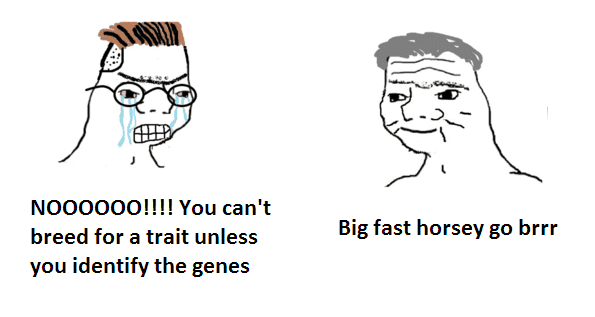
Classic behavioral genetic methods, such as twin and adoption studies, are enough to establish the high heritability of intelligence and behavioral traits by themselves. Likewise, Genome-wide Complex Trait Analyses (GCTA) provide direct verification by showing that genetic similarity across large populations is related to variation in intelligence and many physical and behavioral traits. These unambiguously demonstrate that the genes under examination are related to trait variation. Differences between groups and individuals can therefore be pinned to genes that differ between groups and individuals, even if we don’t know which genes are responsible for the variation or how they interact with each other.
4.5. Wouldn’t high intelligence be adaptive in all environments?
No, that’s an assumption. More advanced mental abilities are not always the best evolutionary strategy because intelligence has costs, not just benefits.
- Brain tissue is very energy-demanding, so that’s a major disadvantage to having a larger brain.
- It’s well-documented that greater brain size strongly correlates with higher IQ, and vice versa (Pietschnig et al 2014, Shaw et al 2006, Menary et al 2013, Karama et al 2011).
- Brain size and intelligence are both positively correlated by ~0.4.
This causal relationship can be illustrated with simulated data. - It’s well-documented that some races have larger brain sizes than others, and that brain size is mainly determined by genetics (Rushton 2004, McDaniel, M. A. 2005).
- Disease-resistant populations tend to have more stable civilizations and higher intelligence. By contrast, famine-resistant populations tend to have lower intelligence, possibly because smaller brains burn fewer calories, and would thus be more adaptive for surviving famines.
- Larger cranial/brain sizes make human childbirth more difficult and more dangerous. They also require larger pelvis structures and longer pregnancies. Larger pelvises make the body less efficient at running. (Also note how East Africans are the fastest runners in the world, and how West Africans are the fastest sprinters in the world.)
- If the brain requires further growth during infancy and childhood (during which an individual is dependent on others for survival), then there is a longer period until the brain reaches maturity, which is another disadvantage.
- IQ and giftedness tend to positively correlate with higher introversion (Source), while extroversion tends to positively correlate with EQ and higher social intelligence. There are benefits to introversion, but there’s no reason to assume that introversion is always more advantageous than extroversion in all environments.
- There’s evidence that more intelligent people tend to be more at risk for autism, schizophrenia, depression, and other maladaptive mental disorders, since each of these are polygenic traits.
- IQ and myopia both tend to positively correlate with each other. Myopia is entirely maladaptive for humans. The usual environmental explanation is that higher IQ people spend more time reading and studying, which worsens eyesight. However, a possible genetic explanation is that greater brain matter (and thus higher IQ) creates more pressure on the eyes, which worsens eyesight. Source
- There are numerous successful animal species with small or nonexistent brains.
- It’s well-known that higher IQ negatively correlates with fertility in the world’s modern environment.
- Even between members of the same race (for any race), individual intelligence tends to vary from person to person. If higher intelligence was universally adaptive in all environments, then we should expect everybody to be equally intelligent and expect every person on Earth to be a brilliant genius. This does not match what we observe in reality. We also observe that intelligence is mainly determined by genetics.
It clearly doesn’t follow that increased intelligence always improves reproductive success.
Other Reasons Why Intelligence May Vary Between Populations
It’s well-known that inbreeding causes lower intelligence and that some populations are much more inbred than others.
In particular, Muslim countries tend to have the highest rates of incest, since Islam makes it very taboo and difficult for members of the opposite sex to meet each other on socially acceptable grounds.
Since Muslims have fewer opportunities to meet members of the other sex, they end up dating and marrying their cousins, since it’s easier and more socially acceptable to interact with them than with strangers.
Inbreeding is a probable contributing factor for why Northern Africa, the Middle East, and Southwest Asia lag behind Europe and East Asia in IQ scores.
4.6. How does higher intelligence evolve?
Organisms evolve to be more intelligent when higher intelligence is adaptive. Consciousness first evolved as a way for animals to find more food, and later as a way to hunt other animals as food. For humans to have evolved far higher intelligence than all the other animals, humans had to have evolved in much more cognitively demanding environments that were and are unique to humans. Language, intelligence, social complexity, and emotions all likely co-evolved, each enhancing the other.
It’s less clear how different human races evolved to have different levels of intelligence. However, we have an answer. Increases in intelligence and IQ seem to be linked to the growth of civilization: laws, money, writing, math, etc, or things that require abstract reasoning. The most intelligent races in the world have long histories of complex civilizations, societies, and technologies. By contrast, the least intelligent races tend to have histories of simpler societies and technologies.
This raises the question why some human races created more complex civilizations than others. There is likely a feedback loop between higher intelligence and more complex civilizations. The loop had to have started due to physical environmental circumstances. There are solid reasons to believe that some environmental circumstances are more likely to produce more complex civilizations (and hence higher intelligence) than others:
- When a human population has a high rate of disease, that can prevent overpopulation, and thus prevent any wars that would otherwise be caused by said overpopulation. In the long run, the reduction of wars would enable more advanced civilizations to prosper, thus selecting in favor of higher intelligence.
- The existence of seasons creates environmental and seasonal conditions requires that humans must plan ahead by months if they are to survive and reproduce.
- They must prepare so that they don’t starve or freeze during winter.
- They must also prepare and deduce efficient agricultural practices according to seasonal changes.
- The significance of seasonality is worth questioning.
- The Ancient Egyptians, Sumerians, and Babylonians were all relatively smart for their times, despite not living in temporal climates.
- Inuits and Siberians also have ~90 IQs. They don’t have seasons in their environments, are decently smart, but are not as smart as Europeans or East Asians. It could also be that Arctic environments are more conducive to selecting higher intelligence than hot tropical environments.
- The European delayed marriage pattern was successful for helping Europe industrialize, while reducing average fertility (thus reducing the risk of overpopulation and war).
And of course, the effects of all these factors are magnified when complex civilizations are sustained for long periods of time. Racial disparities ultimately exist due to geographic, evolutionary, historical, and prehistorical reasons.
Read More:
- Recent evolution of the ability to read and write - Peter Frost.
- The Great Cognitive Advance – Peter Frost. On a per capita basis, the highly intelligent became ten times more numerous in England between 1000 and 1850.
- Genetic pacification in Western Europe from late medieval to early modern times - Peter Frost.
- Recent cognitive evolution in West Africa - Peter Frost.
- Cognitive Evolution in Eastern Eurasia - Peter Frost.
- Related Video: Why Sapiens Got Smart – While Chimps Didn’t.
4.7. How does geography affect the evolution of intelligence?
Video: How Africa’s Geography Traps it in Endless Poverty – Real Life Lore.
The theorized feedback loop between higher intelligence and more complex civilizations raises the question why some human populations failed to develop complex civilizations. The answer is that geography determines how natural selection proceeds and how populations evolve. The following geographic features explain why Africa historically had less advanced technologies and civilizations:
- Africa lacks navigable rivers and waterways, compared to other continents.
- Africa lacks arable land, compared to other continents.
- Africa lacked many staple crops found on other continents, like wheat, rice, corn, potatoes, etc.
- Africa has more landlocked countries, which makes long-distance trade more difficult.
- The Europeans built some railways in Africa, but many different standards are used across the continent, and they aren’t well-connected to each other.
- Africa has much higher linguistic diversity than Europe, which makes inter-ethnic communication more difficult, especially before colonial European languages were popularized.
- The tsetse fly and African sleeping sickness makes it difficult to domesticate animals in Africa.
The lack of livestock in Africa has made it difficult to increase the rate of disease in Africa, which thus made it more difficult to keep population numbers down enough to prevent over population and allow civilization to prosper.
- Tsetse flies -> African Sleeping Sickness -> No Domesticable Animals -> Lower Food Supply And Labor -> Less Advanced Civilization.
- No Domesticable Animals -> Fewer Diseases -> Overpopulation -> Famines -> Wars -> Less Advanced Civilization.
- Tsetse flies -> African Sleeping Sickness -> No Domesticable Animals -> Lower Food Supply And Labor -> Less Advanced Civilization.
Hot tropical climates are probably also less conducive to building civilizations than flat, cooler climates:
- Humans evolved in the African highlands, where temperatures are stable throughout the year, and close to that of spring & fall in temperate regions. This is why we feel most comfortable there.
- Close to the equator, if we’re not in the mountains, the temperatures are too high for us. Humans can’t think or work properly because we overheat, and our sweat can’t cool us off because humidity is too high.
- People in the tropics also suffer from many more diseases, more common in hot moist climates, but also because we didn’t evolve there.
- This also affects food, as agriculture is much harder in these hot moist climates, given the pests, the speed of rot, and the work required by crops.
- This prevented maladapted Westerners from efficiently transferring culture and institutions to these hot, humid, low-lying areas, yet another way these regions suffered.
- In order to avoid all that, people close to the equator tend to live higher up, in mountains, where temperatures are cooler and the dew point is lower, allowing people to cool down with sweat when necessary.
- The big tradeoff for this comfort though has been much higher transportation costs, so less trade, so less wealth.
- This also leads to much more ethnic diversity.
- This diversity breeds conflict, which makes everybody poorer.
- Ethnic diversity and conflict also mean institutions are much harder to make and keep.
This is how mountains are the most significant underdiscussed topic in economic development, and how they must be considered to better explain why warmer countries are poorer.
– Tomas Pueyo, “Why Warm Countries Are Poorer”
Since it’s harder to build complex civilizations in tropical climates, this partially explains why there was less selection for higher intelligence in human races who live in tropical climates.
Africa’s geography is the main reason why Sub-Saharan African populations have been unable to evolve the same intelligence found in Asians and Europeans. Africa’s problems are thus two-fold:
- Africa has bad geography for economic progress and civilizational development.
- Sub-Saharan Africans have low-performing genetics.
It’s counterproductive that so many leftists blame European colonialism for the lack of success in African countries, when geography (and thus genetics) is probably the much, much bigger factor.
5. Aren’t Racial Disparities Better Explained By Environmental Factors?
5.1. Heuristics For Differences Between People
We can note the following tendencies/heuristics about differences between people:
- For differences between individuals within a group, we can quantify the extent that genes are involved on a statistical level.
- For differences in the same group at different times, the cause of the differences depends on the length of time under consideration and the degree of difference in question.
- For big changes that occurred over a short period of time (e.g. the rise in obesity rates, the decline in marriage rates, etc), environmental differences are almost entirely responsible, mainly due to evolutionary mismatch.
- For differences over a long period time, genetic change (either through demographic change or evolutionary changes) can and does have an effect.
- For differences between groups, these may be caused by a combination of genetic and/or environmental differences.
5.2. Occam’s Razor on Racial Disparities
Aren’t most or all racial disparities better explained by environmental factors?
No. If there exist racial disparities and achievement gaps between races, and different races are defined by having different genetics, then Occam’s Razor concludes that genetic differences should be the default hypothesis for explaining why racial disparities exist. That doesn’t mean we assume that every difference is genetic, but that is the default explanation. We should only consider other explanations if there is data that cannot be explained by the simplest explanation (i.e. genetic differences).
The causal connection between environment and social outcomes is no more straight-forward than the causal connection between genes and social outcomes. We know that genes affect brain development. We also know that social outcomes are affected by individual actions, and individual actions are generated by brains. So, there is no mystery about the causal pathway between genetics and social outcomes.

Evolved differences in mental traits are no less likely than evolved differences in skin color, hair type, bone structure, disease immunity, metabolism, etc. The belief in the equality of mental traits between races is a religious assumption. It has no rational/scientific basis. On the other hand, there’s many reasons to believe that average intelligence varies between populations.
Arguing that genetic differences should be the default hypothesis for racial disparities is a correlation-causation fallacy.
Occam’s Razor is a necessary principle for logical induction, not a correlation-causation fallacy. A correlation-causation fallacy is when one leaps from “A is correlated with B” to “A causes B” without considering other possible explanations. For example, it would be a fallacy to leap from “Poverty is correlated with crime” to “Poverty causes crime” without considering other possible explanations, such as “Poverty and crime are both affected by genes”. In most cases, correlation does imply some causal relationship. You can find spurious correlations, if you go looking for them, but obvious correlations usually have a causal explanation. The point of the correlation-causation fallacy is that we can’t assume a direction of causation from a correlation.
“I’m rich because mom and dad left me money and a house” fits Occam’s Razor better than “I’m rich because mom and dad left me good genes that enhanced my earning potential”.
This hypothetical example fails from the get-go to eliminate the influence of genetic differences when it’s trying to argue for environmental differences. Perhaps white parents are more likely to become richer and wealthier than black parents because European genes are better suited towards achieving higher SES on average. If so, then of course white parents would have more money and wealth to pass onto their children, compared to black parents. If the white children also had better genes for enhancing their earning potential compared to the black children, then that would further compound the effects for the hereditarian hypothesis.
The way how parents raise their children is genetic too, not just the way how children behave. It might be true in some cases that bad people would’ve grown up to be better people if they had better parents. But it’s more likely in most cases that “bad” behaviors are caused by genetics, and that bad parents naturally pass on bad mannerisms when they raise their children. The children are also more likely to become “bad” if they inherited their parents’ genes.
Since neighborhoods are composed of people, it also fits Occam’s Razor better to conclude that good people make good neighborhoods and bad people make bad neighborhoods, rather than the other way around, generally speaking. Bad neighborhoods can have negative effects on the people who live in them, but it doesn’t fit Occam’s Razor as well to suppose the opposite conclusion is stronger, i.e. good neighborhoods make good people, and bad neighborhoods make bad people.
Note that we are not denying that environmental factors at least partially contribute to racial disparities. We’re just saying that environmental factors aren’t the main cause. Most race realists would generally estimate that racial disparities are ~80-88% genetic and ~12-20% environmental.[7] By contrast, many (most?) race denialists would say that racial disparities are 0% genetic and 100% environmental, so this suggests that the race realist position is more nuanced than the position presented by most race denialists.
We can investigate what proportion of the variance in a given sample is explained by environmental factors, and what proportion is explained by genetics. If we eliminate the environmental factors one after another (malnutrition, lead exposure, etc), the proportion of the variance that is explained by genetics + random noise will definitionally approach 100%. Of course if we ignore that, it can be said that any trait is both 100% genetic and 100% environmental in an absolute sense, a phenotype being the expression of genes in an environment.
Lastly, if one labels the idea that some races are innately predisposed to commit more crimes than others as “racist”, then it’s contradictory to not also label the idea that men have an innate disposition to commit more crimes than women as “sexist”.
5.3. Racial Differences In Culture
Racial disparities are best explained by cultural factors.
Racial disparities persist when people believe that minorities don’t have agency.
This is a Pascal’s Mugging Argument, and it’s false:
- Races are defined by having different genetics, so Occam’s Razor favors genetics as the simplest explanation for racial disparities.
- If racial disparities are caused by cultural differences, then that only raises the question of where cultures come from.
- The simplest explanation is that culture is largely determined by genetics, which was determined by evolution, which occurred according to physical environmental differences.
- Racial and cultural differences can be reduced by interventions to the extent that racial and cultural differences are environmental. But we can’t change genetics (at least not now anyway).
- The cultural explanation has been assumed for several decades, and the cultural belief in agency still hasn’t erased disparities.
- There are plenty of well-documented genetic behavioral differences between races.
- There’s many reasons to believe that selection for higher intelligence varies by ancestral environment.
- Racism mainly affects dead people, whereas single-parent households affect living people. Over half of black children grow up in single parent households. So, it makes more to posit that single parent households are a bigger issue for black people today than racism.
At some point, a rational-minded person will have to ask: Are racial disparities really an issue that can be fixed by “improving” (supposed) environmental circumstances? Or will blacks never achieve the same prosperity as whites without intervention since race is real?
Dog breeds are well-known for having different behaviors. There are hunting dogs, guard dogs, shepherding dogs, lap dogs, etc. Dogs are best suited for abilities and behaviors depending on their breeds. It’s nonsensical to believe that the cultures and behaviors of dog breeds aren’t mostly genetic.
Why should we believe that the cultures and behaviors of human races aren’t also mostly genetic? The genetic divergence between the ancestors of dogs and modern wolves occurred between 20,000 and 40,000 years ago. It’s true that dogs went through a lot of selective breeding over that time. However, humans started separating and migrating away from each around 70,000-60,000 years ago. Since the advent of agriculture over the last 10,000 years, the human genome has been changing 100 times faster than in prior years.
Read More: Thomas Sowell’s Wishful Thinking about Race – Nathan Cofnas.
5.4. Racial Disparities In Racism And Systemic Oppression
Racial disparities were caused by racism, slavery, colonialism, and systemic oppression.
Other authors have written longer and more detailed works on this topic, but this is a short summary:
- “Oppressed” racial minorities aren’t leaving the West. If anything, they’re immigrating to the West.
- The average black or Hispanic person in the West lives a far better life than someone of the same ethnic group who lives in a third-world country.
- Since the Civil Rights Act of 1964, black people have had equal legal rights to whites for 60+ years of time (two generations) to recover socially and economically. There are no legal rights or privileges that white people have that black people don’t have. Black people also had a variety of ethnomarxist policies and propaganda, and yet they still don’t have the same prosperity as whites.
- Racism and discrimination aren’t unique to black people. Virtually all immigrants to the New World had to deal with discrimination and fight for their rights, at one point or another. East Asians used to be oppressed in the West, but now they’re among the most successful and well-off per capita. If poor Asians can rise from the bottom to average or better SES, then this is evidence that nothing prevents other minorities from doing the same (if we assume that genetic differences don’t matter).
- Poverty isn’t unique to blacks, Hispanics, or American Indians. As of 2010, approximately half of the people living below the poverty line in the US are non-Hispanic white (19.6 million).
- Police brutality isn’t unique to black people, and neither is race-on-race violence. However, we do see that white people are attacked by other races more often than white people attack other races.
- Over 50% of black children in the US live in a single parent household, compared to just ~17% of white children (as of 2017). Obviously, this has a huge impact on how most blacks live their adult lives. However, there is no logical connection between racism and single parent households that doesn’t involve mental gymnastics. It fits Occam’s Razor better to suppose that single parent households are caused by genetic factors, or even cultural factors.
- Poverty can be reasonably attributed to life choices, rather than environmental circumstances.
- 97% of millenials who graduate highschool, maintain a full-time job, and don’t have children before marriage do not end up below the federal poverty line later in life. Source.
- 79% of millenials who do none of the above three end up below the poverty line. Source
- 90% of millenials who do end up below the federal poverty line fail to do at least one of the above three. Source
- All public schools teach their students to believe that discrimination against other races is wrong. If anything, anti-white racism is the most type of racism in the Modern West. Despite that, it’s not uncommon to hear people say that the United States is one of the least “racist” countries in the world.
- Black popular culture is fairly popular among mainstream culture these days. How would it be popular if black people are still oppressed by whites? (Of course though, white culture is still the most dominant because whites are a majority of the American population).
- Blacks have the highest self-esteem of any racial category, which contradicts the belief that they have the most grievance.
- Historically, American Indians, Native Hawaiians, and others fought lots of wars with each other. So why was it any different when white Europeans arrived to the New World and did the same thing?
- The population of Africa skyrocketed after the Europeans colonized the continent, which implies that European colonization was largely a good thing since it largely ended war, disease, and famine in Africa for the time being.
- The best explanation for different crime rates between different races is different genetics. Races are defined by different genetics, and this is the default conclusion by Occam’s Razor.
To a large extent, the perception on how much racism/“racism” exists in the United States depends on what people consider to be racism, which depends on a person’s ideology and what they believe. Nevertheless, I’d argue that the more reasonable position is that the United States has really low levels of racism, with anti-white racism being the main exception.
Also see: How Bad Was Anti-Black Discrimination In The Past? – Aaron Dymarskiy.
Also see: How Bad Was Racial Economic Discrimination in post-Civil War America? – Aaron Dymarskiy.
5.5. Racial Disparities in Intelligence
5.5.1. Replicable Identical Twin And Adoption Studies
For the record, an adverse environment with severe poverty (e.g. modern-day sub-Saharan Africa) does have a negative effect on IQ. Hence, the average IQ in sub-Saharan Africa is somewhat lower than what it could be under optimum conditions. However, we can’t reduce all racial IQ differences to environmental deprivation. Environmental differences may contribute to IQ differences, but they’re not the main factor.
Identical twin studies and adoption studies make it easy to separate the genetic factors from environmental factors regarding the variance among individuals. When we examine identical twins who were raised apart (thus isolating genetics as a control variable), we see that they are still similar in IQ. The heritability of IQ and mental traits is very stable throughout life, reaching into the 0.8-0.9+ range during adulthood when genes have been given the chance to fully express themselves. This means, out of a group of people, at least 80-90% of the variance between them can be attributed to genetic differences.
Likewise, we could compare adoptive siblings who live under a “shared environment” (thus isolating environment as a control variable). The impact of environmental factors is consistently ~0. Adoptive siblings might as well be random strangers for the degree of similarity between them in intelligence, behavioral traits, or outcomes. The research conclusively tells us that there aren’t any such lasting potential effects from parenting or upbringing. For differences between groups, it follows that the provably high heritability of behavioral traits and the reality of genetic racial differences that differences in intelligence between races must also be heavily genetic.[7]
Unlike other fields in academia, there is no replication crisis in intelligence research.
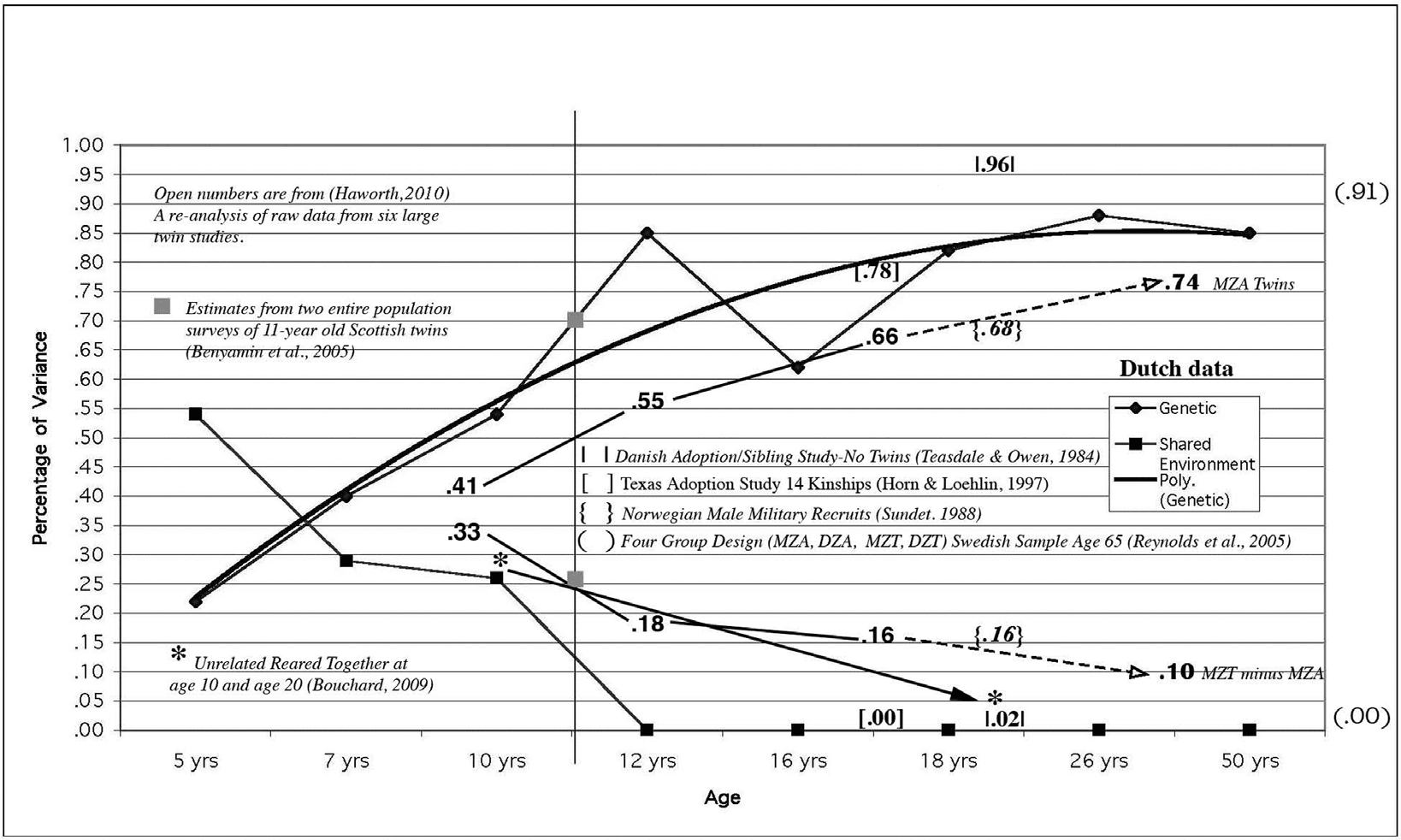
Read More:
- It’s Probably Mostly Genetic - Blithering Genius.
- Race, Genes, & Intelligence: An Empirical Test of the Hereditarian Hypothesis.
- Race And Intelligence (Explanations) – Psychology Fandom Wiki.
- Thomas Sowell’s Wishful Thinking about Race – Nathan Cofnas.
- Most Accurate National IQs Possible – Sebastian Jensen.
- The Global Bell Curve – Sebastian Jensen.
- Are Richard Lynn’s National IQ Estimates Flawed? – Noah Carl.
- National IQs Are Valid, Robust, Reliable, And Realistic – Cremieux.
- Links on IQ and Socio-Economic Status – Gwern.
- Missing Heritability: Much More Than You Wanted To Know – Scott Alexander.
- The answer to the “missing heritability problem” – Sebastian Jensen.
- World Map: Birthplaces of Nobel Prize Winners.
- Test Anxiety? Maybe You’re Just Not Smart – Cremieux.
Test anxiety is more about low IQs than anxiety interfering with performance. - Why Do We Keep Getting This Wrong?: On the causal effects of education – Cremieux.
5.5.2. The Black-White IQ Gap in the United States
But Dickens & Flynn (2006) showed the black-white IQ gap decreased from 1972 to 2002.
That’s not true. Dickens & Flynn (2006) is the only paper that finds a narrowing, so it suffers from clear publication bias. Even if we assume that it wasn’t due to an unrepresentative sample, this is not surprising, since it ignores all the evidence that disagrees with a closing in the IQ gap. More recent studies (Lasker et al., 2019; Hu et al., 2019; Kirkegaard, Fuerst & Meisenberg, 2018) further show that the Black-White IQ Gap has remained stable for 150 years.
While Nisbett (2005) claims to have found the same thing, it makes the Sociologist’s Fallacy. It cites a paper that found gains by controlling for “family background”, which narrows the gap since IQ is very predictive of SES. Some other papers make the same claims as Dickens & Flynn, like Nisbett et al. (2012), which was addressed in Rushton (2012) and Mackintosh (2011), despite the fact that it found that the adoption of black children into middle-class white homes did nothing to reduce the race difference in IQ by age 17 (as expected, see the Wilson Effect).
Where the data are available (e.g. the National Longitudinal Surveys of Youth), we see that any “closings” are not in g. Where the data are not available (e.g. Dickens & Flynn 2006), we obviously cannot know. On a more academic note, the totality of evidence was empirically contrasted to the Dickens & Flynn analysis by Rushton & Jensen (2006), who found Dickens & Flynn were essentially wrong.
One might ask (especially regarding Dickens & Flynn), why does it matter if the closings are in g or not? The purpose of IQ - in a psychometric sense - is to test general intelligence as best as it can. This is represented by the g-factor. The fact that it is more heritable, more predictive, and less affect-able than IQ aligns with Spearman’s Hypothesis, which has been tested many times and is supported. For the logic of g inferences, you can consult Bartholomew (2005). Floyd, Clark & Shadish (2008) also covers further information, especially regarding the transferability of latent variables compared to observed ones.
How do we know the average racial IQ differences are on g?
We can observe tests of Spearman’s Hypothesis. Although the gap on g has been tested separately, it is essentially the same size as the IQ gap (see: Roth et al., 2006).
Read More:
- A Plethora of Evidence for Genetic Influence of American Race-Ethnic Gaps in Intelligence.
- On Proposed Environmental Causes of the American Black-White IQ Gap – Ideas & Data.
- Resolute Ignorance on Race and IQ, Courtesy of Kevin Drum - Cremieux (2019).
- The Cherry Picked Science In Vox’s Charles Murray Article (2017).
- Race and IQ: A Theory-Based Review - Rushton & Jensen (2010).
5.5.3. European DNA in African Americans
The researchers focused on nearly 4,000 African Americans who participated in two important studies, both sponsored by the National Institutes of Health. The Health and Retirement Study consists of older volunteers sampled from urban and rural areas across the U.S., while the Southern Community Cohort Study focuses on African Americans in the South, particularly areas that have a disproportionately high burden of disease. Together, these two studies are among the largest sources of genetic data on African Americans. Importantly, they represent a geographically broad sampling of the African-American population, which is critical for outlining the patterns of genetic history.
The researchers first looked at what fraction of African Americans’ genetic ancestry could be traced back to Africa. Not surprisingly, the data shows that, for most African Americans, the majority of their DNA comes from African ancestors. The results also show that essentially all African Americans have some European ancestry as well. The genetic mix of African and European DNA, however, follows a striking geographical trend: African Americans living in Southern states have more African DNA (83 percent) than those living in other areas of the country (80 percent). Conversely, African Americans outside the South have a larger fraction of European DNA. Even within the South, this trend holds: Blacks in Florida and South Carolina have more African DNA than those living in Kentucky and Virginia.
The implication of these findings won’t be surprising to anyone: Widespread sexual exploitation of slaves before the Civil War strongly influenced the genetic make-up of essentially all African Americans alive today.
But this poses a puzzle: If African Americans can trace most of their European ancestry to an era when America’s black population was overwhelmingly confined to the South, why is it that African Americans now living outside the South have more European DNA?
The researchers propose an interesting answer. They argue that the Great Migration of African Americans out of the South was genetically biased: African Americans with a higher fraction of European ancestry, who often have lighter skin, had
better social opportunitiesmore European-like behavior, and were thus in a better position to migrate to northern and Western states. Though it will take further evidence to show this definitively, the McGill researchers’ results imply that, even after the end of slavery, discrimination that varied with shades of skin color continued to influence the genetic history of African Americans. – Michael White, How Slavery Changed the DNA of African Americans
TL;DR:
- Virtually all African Americans who are descended from slaves have some European DNA, due to widespread sexual exploitation of slaves in the antebellum United States.
- The general public’s perception of race is oversimplified and misguided.
- African Americans who live outside the Southern United States tend to have more European DNA than African Americans living in the South, on average. (New Orleans is an exception.)
- African Americans in cities (especially Northern cities) have a larger fraction of European DNA.
- Many famous or notable African Americans in history have a larger fraction of European DNA.
- Blacks, African Americans, and Sub-Saharan Africans who have less European DNA tend to be less intelligent, more likely to commit crimes, etc, on average.
- Once again, outliers exist for all groups. It’s reasonable to believe that there are some highly intelligent Africans who have no non-African DNA at all.
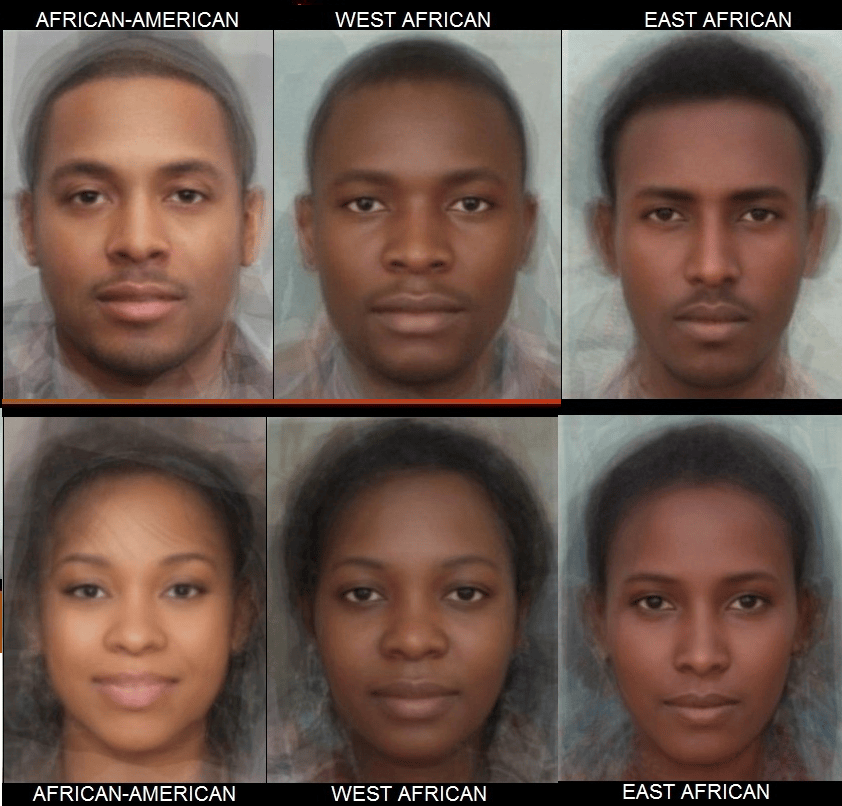
5.5.4. The IQ of Europeans vs East Asians
See also: Why is the Average IQ of Ashkenazi Jews So High?
In today’s world, IQ tests show that East Asians have higher IQs than Europeans, on average. However, this seems at odds with how a greater number of historical intellectual discoveries have been made by Europeans, compared to East Asians. A common explanation for this discrepancy is that East Asians lack creativity and ingenuity, despite being smarter. Supposedly, East Asians aren’t as good as Europeans at inventing new ideas, for whatever reason. However, we should expect creativity to correlate with IQ in most cases, so we need to theory to explain why the correlation doesn’t occur in this case.
The theory that I propose is that East Asians are marginally smarter than Europeans on average (according to IQ metrics in the present-day), but the reasons why Europeans made most of the inventions of modern civilization are:
- Europe industrialized before East Asia did because Europe experienced the Flynn Effect first. East Asians had a higher genetic potential for intelligence that failed to fully actualize before Westerns fully actualized their genetic potential for intelligence. So, when the East Asian environments (more or less) equalized, the East Asians surpassed Europeans on IQ and intelligence.
- Europeans were better educated during the 1800s and 1900s following the Industrial Revolution (1750-1970). Since there is a finite number of useful inventions that can be made, it was too late for East Asians to invent many things by the time most East Asian populations were taught literacy and received comparably high-quality educations. Notably, most East Asians also use logographic writing systems, which create a stronger barrier to literacy than (morpho)phonemic writing systems, but may improve the spatial reasoning of those whose master them.
- Europeans might have higher variation in their IQs and intelligence, and therefore have/had a slightly larger number of >130 IQ individuals, even though their average IQ is slightly lower than the average East Asian IQ.
- This is plausible since the European marriage pattern made it possible for Europeans with similar traits to breed together, which likely created humans with higher IQs near the right tail of the curve to arise, and possibly also humans with lower IQs near the left tail of the curve.
- This is consistent with how European populations are known to have more genetic diversity than East Asians, how East Asian populations have the least genetic diversity of all races (due to the Founder Effect), how ~84% of all genes in the human genome are expressed somewhere in the brain (Hawrylycz et al, 2012), and how one-third of human genes are expressed primarily in the brain and during brain development (Douet et al, 2014).
- Ashkenazi Jews have made a disproportionate number of technological contributions and innovations, despite their small size. The average IQ of Ashkenazi Jews is estimated to be ~110, compared to the average ~100 for most of Europe. There are also many reasons to believe that Ashkenazi Jews had higher selectionary pressures for intelligence than Europeans. Hence, categorizing Ashkenazi Jews as “Europeans”[8] probably enhances the apparent historical and technological contributions of Europeans, even though non-Jewish Europeans tend to be less intelligent than Ashkenazi Jews, on average. For more info, see: Why is the Average IQ of Ashkenazi Jews So High?
- East Asian innovation has likely been held back by the Communist takeover of China and North Korea, as well as the prior colonization of China, Korea, and Taiwan by Japan and European powers. Chinese culture would probably be just as influential in the West as Japanese culture is today, if it hadn’t been for the Communists winning the Chinese Civil War.
- Some claim that the average European IQ peaked around ~1850 shortly after the Industrial Revolution, and has been steadily declining ever since (Source). This is disputed.
- The European intellectual tradition was focused on creativity, comprehensiveness, and polymathy.
Meanwhile, East Asians selected their elites for millennia by test taking.
Thus, it could be that East Asians have higher IQs only because they have a heavier test taking culture, compared to Europeans.
If so, then this would explain why East Asians perform better on tests, whereas Europeans perform better on real world results.
This also seems consistent with what we’ve seen on IQ tests and the last 200 years of history.
If all of this is true, then Europeans would theoretically have similar or higher IQs than East Asians if Europeans also had a heavy test taking, tiger parents culture.
Read More: Asian immigration and the signaling model of education – Arctotherium. - The cognitive abilities of humans that cannot be measured by IQ may differ between Europeans and East Asians. Hence, the intelligence of a European could be different from the intelligence of an East Asian, even when they have the same IQ scores.
- Singapore’s IQ was probably raised slightly due to its past (dirigiste eugenic) population planning policy from 1966 to 1986.
Most of the world’s atheists are in the Western world and East Asia. It seems that intelligence correlates with the prevalence of atheism.
5.5.5. The Intelligence of Ashkenazi Jews
5.5.6. Aren’t there exceptionally smart people from all races?
Evolved differences in mental traits are no less likely than evolved differences in skin color, hair type, bone structure, disease immunity, metabolism, etc. The belief in the equality of mental traits between races is a religious assumption. It has no rational/scientific basis. On the other hand, there’s many reasons to believe that average intelligence varies between populations.
To answer the question: Yes for the most part, but this does not debunk the definition of race realism. Once again, a race is a statistical cluster of genetic variation. That means that there can be statistical outliers to any generalized claim made about a race(s). Relatively high-IQ people can come from low-IQ races, and relatively low-IQ people can come from high-IQ races, but when this happens, those people are the statistical outliers of their respective races. Race realism is the recognition of statistical tendencies that are caused by historical evolutionary patterns, not dogmatic judgments.
Read More: Averages and Outliers.
But aren’t all individuals are born with the same amount of knowledge?
Yes, it’s true that every person is born knowing virtually nothing, and that every expert was a beginner at some point. However, this ignores that some people (and hence some races) are better at becoming experts and intellectuals than others (on average), so differences in intellectual abilities still persist.
To be clear, there is definitely a group of people on Earth who can be considered to be the world’s smartest humans, dead or alive. But one should be skeptical of anyone who claims that any one of those people is definitively smarter than all the others within the group. It would be more accurate to say that each of the world’s smartest humans are smarter than the others within the group in different ways, aspects, and subjects.
5.6. Racial Disparities in Economic Status and Academic Achievement
Income and educational attainment is correlated with IQ for all races. We could interpret this environmentally as income boosting IQ and educational attainment, but we could also interpret this genetically as IQ boosting income and educational attainment. The former is true to some extent, but the causal relationship in the latter is much stronger. The average African American has a higher standard of living today than Issac Newton and all the other Enlightenment thinkers who lived in the 1600s, or even the standard of living for European Americans in the early 1900s. And yet, African-Americans have still failed to achieve the intellectual, educational, or economic achievement of Europeans and East Asians.
Racial gaps in IQ and achievement persist in developed countries just as much as they persist in developing countries. The racial IQ and achievement hierarchy that is visible in the United States is found all over the world. In every country on Earth, Blacks statistically do poorly in comparison to Europeans. Likewise, East Asians and Ashkenazi Jews collectively do well all around the world, better than Europeans do. Across the globe and across very different societies and economic systems, we see roughly the same pattern as we see in the United States. This is true with populations who have been in these respective countries for many generations (e.g. Brazil). Even if someone came up with some cultural explanation for any particular society, it wouldn’t explain the consistency in global racial disparities.
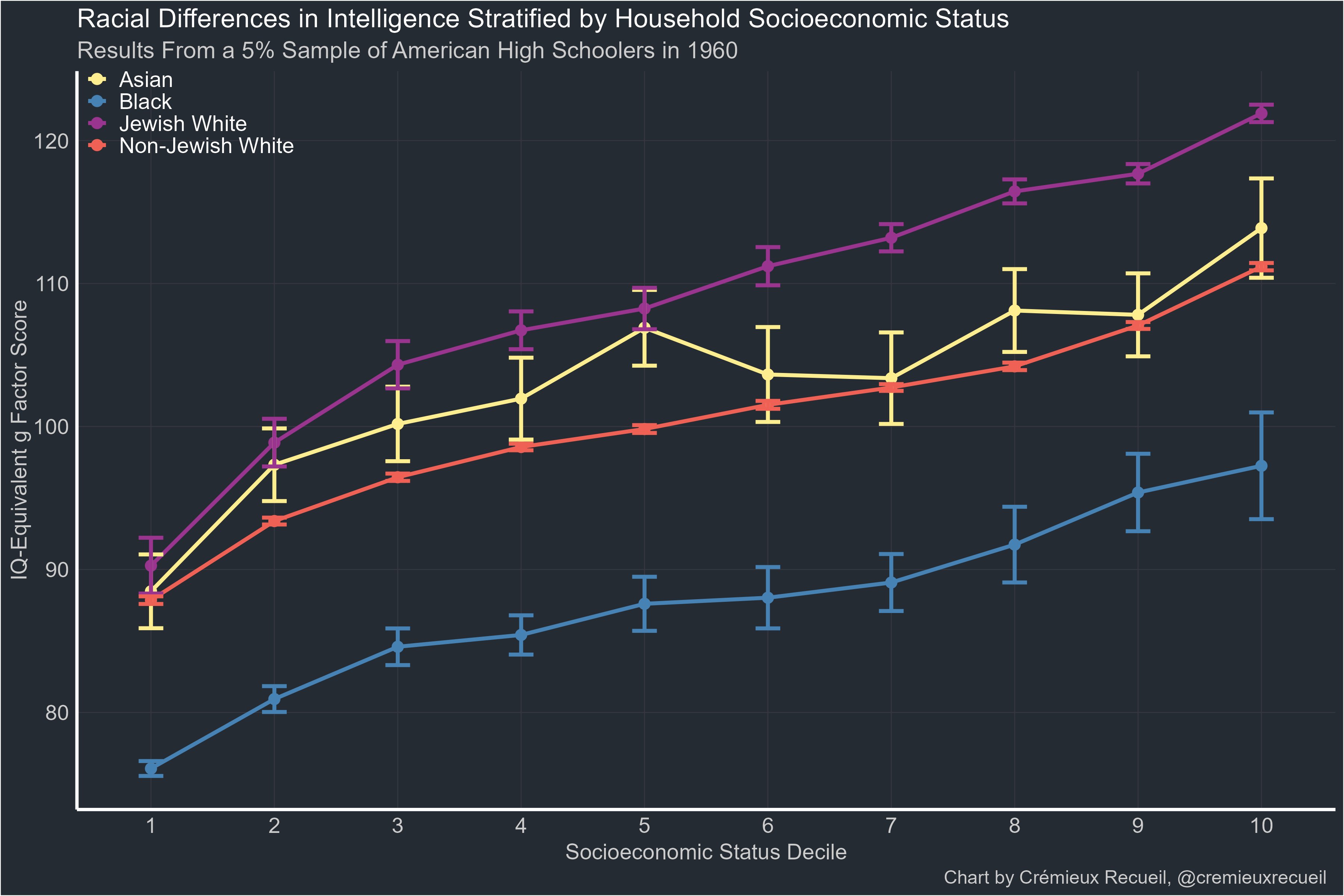
Average IQ positively correlates very strongly with national development, in measures such as GDP per capita. Some countries lag behind despite receiving decades of foreign aid and assistance, while others have done well despite having few natural resources.
Wealth disparities are responsible for observed national IQs.
This is untenable upon close examination. When looking at the outliers from this pattern, one can see that average wealth does not affect national outcomes in IQ. For example, people from impoverished interior China tend to perform better on IQ tests than people from wealthy yet not particularly intelligent Middle Eastern oil-exporting nations.
“I’m rich because mom and dad left me money and a house” fits Occam’s Razor better than “I’m rich because mom and dad left me good genes that enhanced my earning potential”.
This hypothetical example fails from the get-go to eliminate the influence of genetic differences when it’s trying to argue for environmental differences. Perhaps white parents are more likely to become richer and wealthier than black parents because European genes are better suited towards achieving higher SES on average. If so, then of course white parents would have more money and wealth to pass onto their children, compared to black parents. If the white children also had better genes for enhancing their earning potential compared to the black children, then that would further compound the effects for the hereditarian hypothesis.
5.7. Racial Disparities in Single-Parent Households
To some extent, it’s difficult to define what a single-parent family or household is. Do children living with married step-parents count? Do cohabiting parents count if they’re unmarried? What about children raised by other relatives (e.g. grandparents, aunts, uncles, etc) or children who live in group quarters (institutions, dormitories, orphanages, or group homes)?
However it’s defined, there are huge racial disparities in the rate of single-parent households:
- According to Pew Research in 2017, over 50% of black children live in single parent families, compared to just ~17% of white children.
- According to the AECF, 67% of black children live in single parent families, compared to 25% of white children. The AECF considers cohabiting unmarried parents to be “single”, but not married step-parents.
- According to the US Census Bureau in 2022, 70% of white children lived with married birth parents, compared to only 33% of black children.
Racism was and is the cause of the high rate of black single-parent households.
There is no evidence to support that belief. The rate of black single-parent households was much lower back in the 1950s when America was far more racist than it is today. As racism declined in America during the mid-to-late 1900s, the rate of black single-parent households increased.
The racial disparities in single-parent households are the main cause of other racial disparities.
This does not fit the evidence. Single-parent households were uncommon in the US during the 1950s, yet blacks accounted for 30% of all arrests and 60% of the arrests for crimes involving violence or threat of bodily harm–murder, non-negligent manslaughter, rape, robbery and aggravated assault, despite making up only 10% of the US population. We also mentioned before that identical twin studies and adoption studies disprove the hypothesis that environments are the main cause of differences in intelligence.
Even if single-parent households do contribute to higher crime rates, this fails to consider possible genetic causes. It could also be the case that parents who don’t take care of their children have genetics that make them less responsible, less intelligent, and more likely to commit crimes to begin with. Likewise, people who grew up in fatherless single-parent households may be less responsible and more likely to commit crimes because both they and their parents have genes that make them less responsible in the first place. Correlation does not imply causation, but genetic factors shouldn’t be ruled out in favor of environmental factors just because genetics is a more taboo explanation. A child with good genes would probably perform decently well even without a father present, although they would obviously be better with a father in all cases.
There is no such thing as “white privilege” in the US today, but there is “father privilege”.
Over 50% of black children live in single parent families, compared to just ~17% of white children. This has a big impact on parental investment and household income. It also has a big psychological effect. Children need fathers as well as mothers. Boys need male role models. Also, fathers are male authority figures, and father-son interaction teaches boys how to deal with male authority.
Sexual promiscuity is often associated with violent behavior. Love and marriage go together, and so do violence and promiscuity. It’s a basic biological principle. When paternity cannot be established, males will not invest energy in caring for offspring. Instead, they will compete for access to females.
Having a father is not a privilege, but it is a huge advantage in life. This advantage is not being denied to black people by white people. It is being denied to black children by their parents.
– Blithering Genius, “Ferguson: Race and Violence”
Furthermore, the rates of violent crime have been falling since the mid-1990s, in spite of a surge in single parenthood during the 1970s and 1980s. However, the theory that single parenthood causes criminality would predict an increase in violent crime that follows the increase in single parenthood by about 20 years. That is the exact opposite of what happened in the 1990s and 2000s. While this doesn’t prove that single parenthood has no effect on crime rates, it’s still counter-evidence that needs to be considered. Other explanations for why crime rates fell during the 1990s and onward include: the legalization of abortion, better policing tactics, higher incarcerations rates, improvements in medical care lower the fatality of assaults and injuries, etc.
Other proposed factors include how welfare states and other leftist policies have subsidized the reproduction of genes linked to social and sexual irresponsibility, the breakdown of the Church, and the movement of blacks into urban environments (which makes them even more distant from their ancestral social environment). Some would even argue that Jim Crow laws helped to maintain the black community, because blacks would have separate black-owned enterprises, and thus there used to be a stronger pathway to financial success and social status. But even then, whites did not respond to the welfare state in the same way as blacks (on average), so there are racial (and genetic) differences that have a clear effect here. Genes cannot be rationally dismissed as affecting the racial disparity.
Government welfare policies encourage single-motherhood and single-parent households.
That’s true, but many of the problems in the African-American family were present at the time of slavery.
See: Conservatives Are Wrong About The Black Family - Lipton Matthews.
5.8. Racial Disparities in Crime Rates
It’s a contradiction to insist that the high incarceration of black people (relative to their proportion of the population) is caused by environmental factors, while also insisting that the fact that males make up >90% of the prison population is not caused by environmental factors. To resolve this contradiction, one would have to pick between one of two options:
- There’s no such thing as people having innate dispositions to commit more crimes and violence than others. Note that this would imply that the high incarceration rates for men are completely caused by environmental factors, which virtually everybody would disagree with.
- Some races have innate dispositions to commit more crimes. (the more reasonable position)
For the most part, good people make good neighborhoods, and bad people make bad neighborhoods. It’s not the other way around.
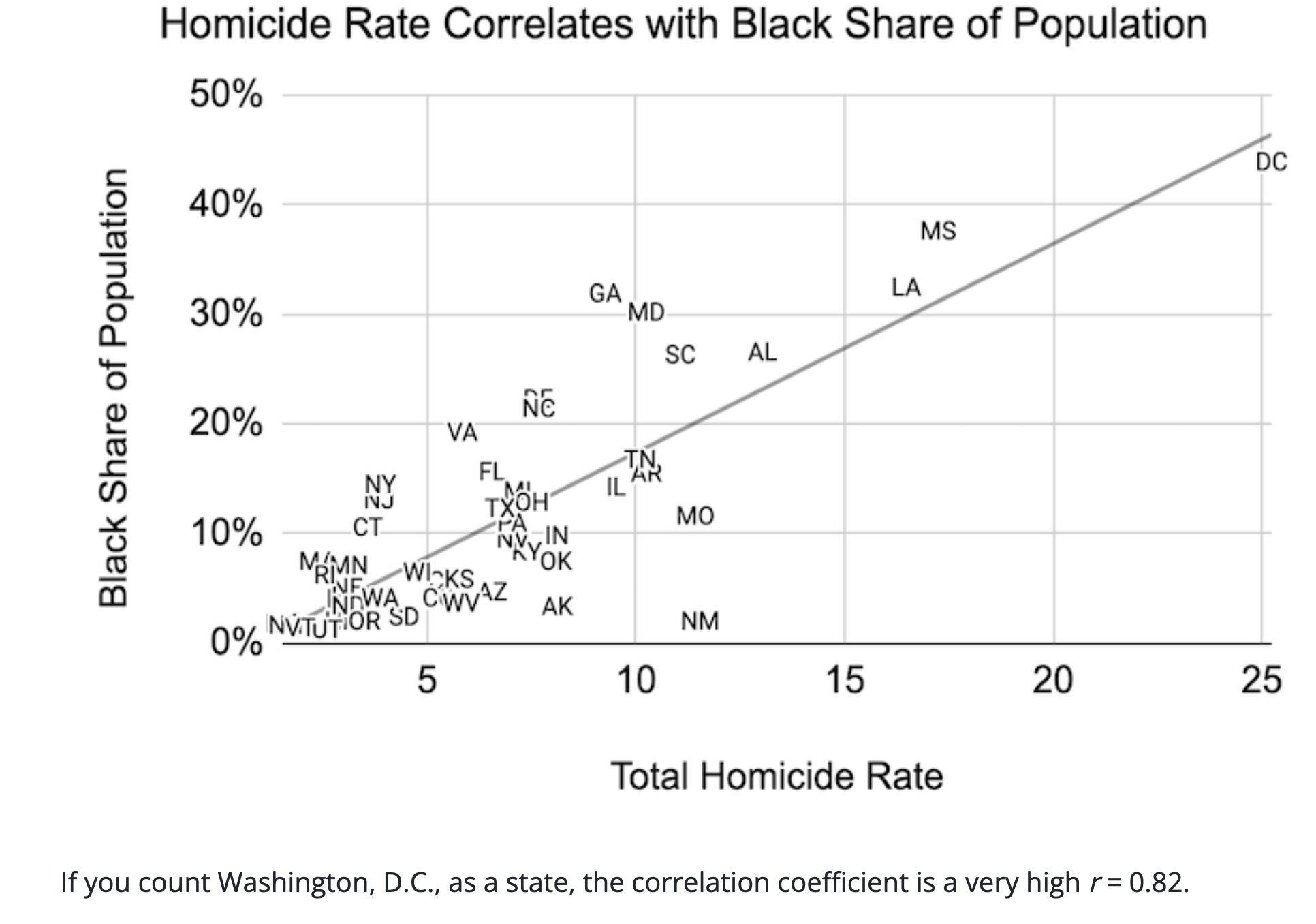 |
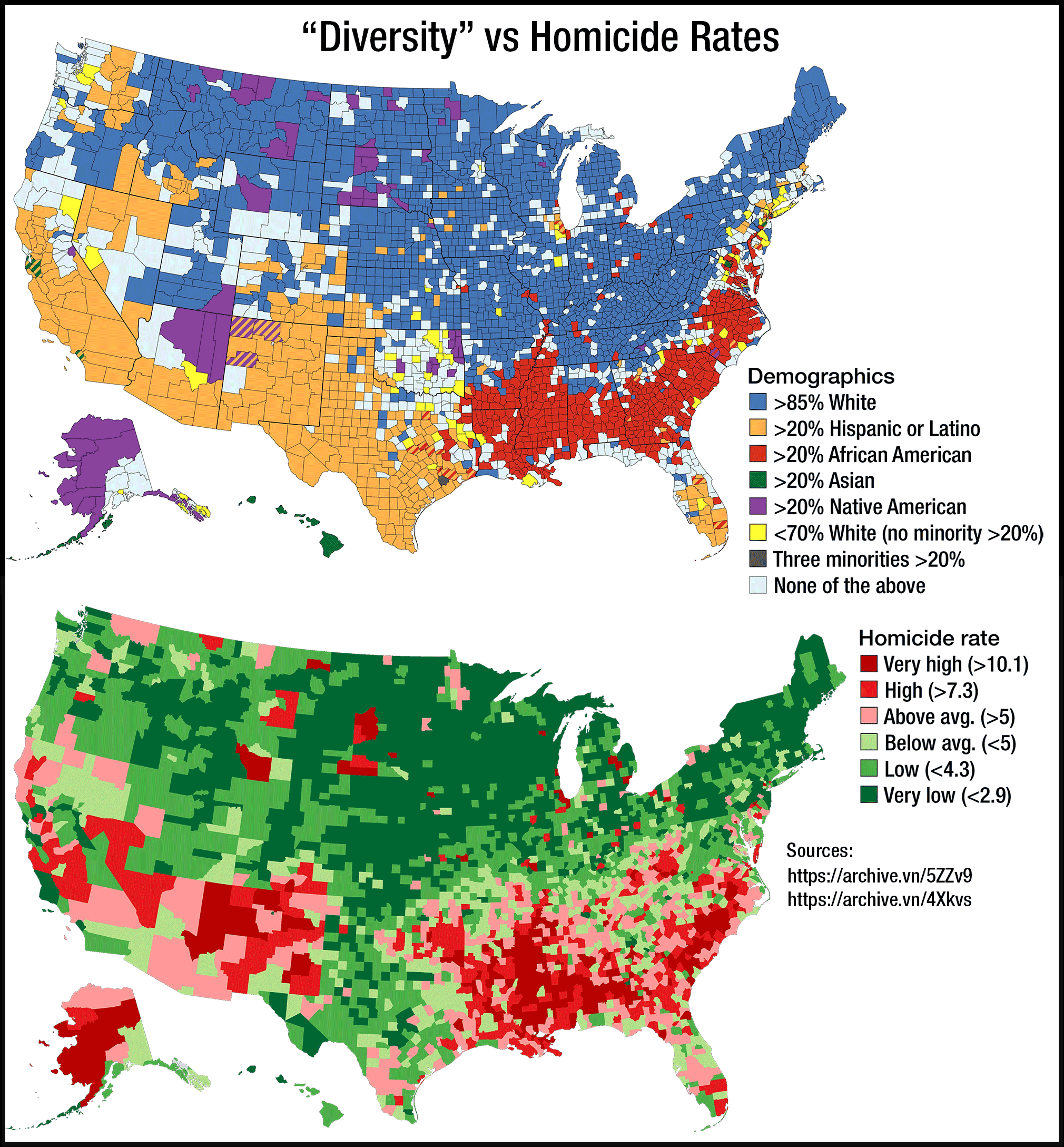 |
Read More:
- Racial Crime Statistics: A Series of Infographics on Globally Consistent Trends (Downloadable PDF).
- US Mass Shootings, 2018-2020: Who’s responsible? - Thuletide.
- Western Europe, State Formation, and Genetic Pacification - Frost & Harpending 2015.
- Violence Around The World - HBD Chick.
- In 2020, over 56% of known murder offenders in the US were black, while blacks make up only 13.6% of the US population. Source 1, Source 2
- In 2019, over 91% of murder suspects and arrestees in NYC were black or Hispanic, while blacks and Hispanics make up only 53% of NYC’s population. Source
- The sons of black families from the top 1 percent of household income have about the same chance of being incarcerated as the sons of white families earning $36,000 (~34th percentile). Source
- Immigrants constitute 73% of murder suspects, 70% of robbery suspects, and 58% of suspects for all crimes in Sweden. Source
- Calculating the Aboriginal Crime Rate – Heretical Insights.
Note: While theft, murder, rape, and human trafficking are the most archetypical types of crime (which blacks happen to do more of), we’ve explained and addressed that there are some specific types of crimes that whites do more than blacks per capita (e.g. hacking, pedophilia, deadlier mass shootings vs spontaneous mass shootings, etc).[9] There is a lot of nuance to the claims that we’re making here, which most people fail to understand.
5.9. Addressing Objections To Racial Disparities In Crime Rates
Blacks are more likely to be killed by police officers than whites. This indicates that the police is systemically biased against blacks.
The crime rates are not lying, nor are they unfairly biased against races. That’s mental gymnastics. Blacks would face fewer encounters, killings, or police brutality if they committed fewer crimes. Anybody who insists otherwise simply doesn’t want to accept the truth.
Blacks have higher crime rates and more violence is because they were segregated from the rest of society as a permanent bottom caste, placed into decades-old enclaves of poverty, subjected to discrimination across every dimension, and all of their communities were drained of resources.
These things may have been true before the mid-1900s, but none of them have been true for the past 60 years. There’s also no clear connection between poverty and crime rates (see next paragraphs).
Also See: Racial Disparities In Racism And Systemic Oppression.
The crime gap can easily be explained by blacks more often being in an economic situation that would encourage theft (being poor), and having worse life prospects. People are less likely to risk committing crimes if they have better life prospects.
This is a good example of one-sided reasoning, which simply ignores other explanations. While poverty does correlate with higher crime rates, correlation does not imply causation. The available evidence does not support a causation relationship between poverty and crime rates.
Furthermore, the crime gap between races is bigger for murder than for theft, and it is not explained by economics. Most murders have little or no economic benefit. The same goes for rapes, which are more likely to be committed by blacks than whites per capita.
There are also many natural experiments that support the genetic hypothesis over the wealth inheritance hypothesis. For example, some minorities quickly rose in social status after immigrating to Western societies with little or no wealth: Irish peasants, the Chinese, Ashkenazi Jews, etc. Countries that were extremely poor, such as Japan after WWII or China in the 1980s, have had huge increases in prosperity. Their poverty did not hold them back.
No crime-causing genes have been identified in humans.
To the contrary, scientists have identified genes that strongly correlate with higher crimes, as well as other genes that affect behavior in general. Moreover, this argument has a major conception. “crime-causing alleles” is not like a binary thing you either have or you don’t. There are probably thousands of different places in the human genome that each have small contributions to criminal behavior. All these alleles vary by frequency for every race.
There’s a lot of alleles that, say 80% black people have that only 20% of white people have. Many places in the genome are like that, which is what causes racial differences in appearance and behavior. Black people probably have more alleles related to aggressive behavior, lower foresight, and worse impulse control on average, which accounts for that group’s 5-8x higher chance of committing a homicide. And of course, criminal behavior also isn’t purely genetic. It’s also a result of random factors and circumstances, but these aren’t the main factors regarding people’s behavior, in the grand scheme of things.
White males make up ~88% of all child sex offenders.
Of course there are things that whites do more than other races. The bottom line is that different races will have different behaviors and different rates for different kinds of crimes. White people may be more likely to do non-consensual pedophilia or hacking, whereas black people are more likely to kill, rape, steal, cheat, etc.[9]
Most mass shootings are done by white people. Between 1982 and December 2023, 80 out of the 149 mass shootings in the United States were carried out by white shooters.
This is a red herring fallacy, not an argument against race realism. From the same data set, blacks make up a somewhat disproportionately higher percentage of mass shootings. Also, race realism isn’t “white people good, black people bad”. It’s “races are real and races differ in average mental traits”. If you look at patterns of murder, there are probably racial differences that go beyond the incidence level.
For example, one stereotype is “black men can’t shoot”, because there’s a lot of mass shootings with few deaths where the perpetrator is almost always black. The carefully planned and executed mass murders take a lot more victims, and they tend to be done by autistic Asians and Europeans. There’s also Muslims who have impressive group agency and suicide attacks. The bottom line is that different people have (statistically) different behaviors.
White supremacy is the most common motivation for domestic terrorism in the United States.
There seems to be ideological bias regarding what gets labeled as “terrorism”, so this is a questionable claim. For example, the Waukesha Christmas parade attack was not labeled “terrorism”. Neither was the 2023 Nashville school shooting, although it seems to have been inspired by social/political views. Amren has a decent article comparing the Waukesha incident to the Charlottesville incident.
I don’t know if there’s any non-partisan statistical analysis on terrorism that clearly defines how it categorizes the motivations of every terrorist act, but people can contact me if there is one. Regardless, terrorism is relatively uncommon compared to other types of crime, so the prevalence of terrorism motivated by racial supremacy does not disprove how some races are innately more likely to commit crimes than others.
Immigrants commit fewer crimes than native-born Americans.
Statistics are often cited for that claim, but they tend to make the error of not examining crime rates by race. We know that some races commit more crimes than other (Blacks and American Indians), so that’s a major reason why native-born crime are higher than the crime rates of immigrants.
When trying to make an honest judgment on whether immigrants commit more crimes than the native-born population, it thus makes sense to divide crime rates by race. Most immigrants to the United States are usually Latin American, Middle Eastern, or Asian (South, Southeast, East, or Pacific Islander). The immigrant crime is higher than the native-born white crime rates. Hispanic crime also tends to get worse in the second generations.
5.10. What if genetic engineering manages to erase racial disparities?
It seems likely that at least some form of gene editing (and probably many different types) is going to become successful and widely available within the next few decades. If or once this happens and if it becomes possible to use gene editing to create more intelligent humans of every race, it’s possible that all racial disparities between races could be largely wiped out. We support eugenics, so we’d welcome erasing such disparities, even if that meant that this webpage would become little more than a historical artifact that documents refutations to false beliefs that used to be prevalent before the widespread adoption of gene-editing.
It’s difficult to predict what could result from cheap and widespread genetic engineering, but it could potentially wipe out the taboo against race realism if it causes more people to become interested in understanding genetics and human races. The ability of gene editing to erase racial and individual disparities will depend not only on the successful development and capabilities of the technology, but also on how the technology(ies) are regulated. For now, it seems too soon to tell what will happen.
I also wouldn’t be surprised if there was significant historical negationism to cover up how Europeans, Ashkenazi Jews, and East Asians were the most intelligent and most successful races before embryo selection and gene editing became popular and widely accessible. It would of course be dishonest to hide how evolution (initially) selected some races to be smarter, less violent, more responsible, etc than others. But I’m also not sure how much that would matter (if at all) if gene editing permanently equalizes the distribution of mental abilities among every race of humans.
Read More: Eugenics FAQs.
6. Race Taxonomy and Tactical Nihilism Fallacies
Read: Race 101: What is Taxonomy? - Thuletide.
Read: The Genetic Validity of “Race” - Thuletide.
Whether or not human races can be classified as separate subspecies depends on the chosen taxonomy and the criteria for racial/taxonomic classification. Race realists generally contend that human races are different enough to be categorized as separate subspecies, while race denialists contend the opposite. The former position is more coherent than the latter, but this isn’t very important. The bottom line is that human races are different from each other to have their own names as well as noticeable and distinguishable physiological features.
See Also: Race 101: Genetics Glossary.
6.1. K-Cluster Analysis
Wikipedia: k-Means Clustering.
The existence of an “ideal” number of clusters is not required for there to be validity to the structure we find in the clusters. When one chooses n+1 clusters instead of choosing n clusters, the effect is splitting a cluster rather than reshuffling all the clusters. Then what you usually see is individuals staying in their current cluster and also being assigned to a sub-cluster. There isn’t any “moving from one cluster to another cluster”, except perhaps some fuzziness on the edges, which does not destroy the validity of the concept. If you look closely at this chart showing the genetic similarities and differences of modern humans, what we find is that:
- When K=1, the cluster is all of humanity.
- When K=2, the clusters are Sub-Saharan Africans (which are still in the “humanity” cluster) and Non-Sub-Saharan Africans (which are still in the “humanity” cluster).
- When K=3, the clusters are Sub-Saharan Africans, West Eurasians (which are still in the “Non-Sub-Saharan African cluster) and East-Eurasian+Amerindians (which are still in the ”Non-Sub-Saharan African“ cluster)
- When K=4, the clusters roughly correspond to Sub-Saharan Africans, West Eurasians, East Eurasians (which are still in the East-Eurasian+Amerindians cluster) and Amerindians (which are still in the East-Eurasian+Amerindians cluster)
- When K=5, the clusters roughly correspond to Khoisan (which are still in the Sub-Saharan African cluster), non-Khoisan Sub-Saharan-Africans (which are still in the Sub-Saharan African cluster), West Eurasians, East Eurasians, and Amerindians.
- When K=6, the South Eurasian cluster splits from East Asians. This ancestry is found at high levels in Oceania and South India, and low levels throughout East and Southeast Asia.
- When K=7, Siberians appear as a separate group, distinct from East Asians. Even at this level of analysis, Siberia is relatively heterogeneous. The vast region is accessible to a diverse range of racial and ethnic groups and historical migrations. As a result, the Siberian population carries East Asian, West Eurasian, and Amerindian ancestry.
- When K=8, South Asians appear as a distinct group. Ancestry components previously classified as West Eurasian and South Eurasian are now almost entirely South Asian. This green component most likely represents a prehistoric population descended from both West and South Eurasian peoples.
- When K=9, the West Eurasian splits into European and West Asian. This ancestry component likely originated in West Asia before spreading to North Africa via an ’into Africa’ return migration.
- And so on and so forth.
The “race exists” position is “there is some inherent structure in all this”. The “race doesn’t exist” position is “there is no inherent structure in all this and/or there are no phenotypical implications of any of this”.
6.2. But human races are too similar to be considered separate subspecies.
This is tactical nihilism. Every algorithm for classifying taxa and taxonomy has to have parameters plugged into it. In particular, the threshold parameter is important for determining whether two groups are classified as different taxa or not. In essence, this means that anybody can come up with whatever algorithm they want for classifying races as distinct taxa, or not.
An FST of 0.25 is the required cutoff for there to be different subspecies. – Dishonest Academics
Any cutoff point that you choose is going to arbitrary. And even if that’s true, this Wikipedia chart implies that humans have basically two subspecies. If you apply max-linkage agglomerative clustering to the ancestry groups in this chart, and there’s a subspecies cutoff of 0.25, then the two subspecies of humanity are “black” and “non-black”. This is consistent with how K=2 in K-Cluster Analysis divides all of humanity into Sub-Saharan Africans and Non-Sub-Saharan Africans.
Regardless, if you tell a clustering algorithm to group people based on genetic data (and the threshold parameter for separating humans into distinct groups is set to the right level), you will get the socially defined races with practically perfect accuracy. In one example, a genetic cluster analysis of 3636 people grouped people into 4 categories who identified as white, Asian, black, or Hispanic. Only 5 of those people fit into a category different to that of their self-identified race (Tang, 2004). The algorithm GRAF-pop is able to predict individual ancestry with high accuracy (Yumi, 2019).
See: “All humans are 99.9% genetically identical, therefore race isn’t real” - Thuletide.
See: What Is The Difference Between Genetic Similarity And Relatedness?
6.3. But humans have less genetic variation than other animal species.
This is a red herring fallacy.
- It will always be inevitable than some set of subspecies will have the lowest genetic variation between them of any subspecies set.
- The criteria for categorizing a set of organisms into different species or sub-species cannot be set by what organisms are already considered separate subspecies. That would only raise the question of what criteria were used to classify of the previous set of organisms in the first place.
- Race / subspecies classification is based on observed characteristics (phenotypes), not genotypes.
- Humans have more genetic variation than many animal species that are indisputably categorized into different races. For example, there is less shared DNA between some human races than between bonobos and chimpanzees.
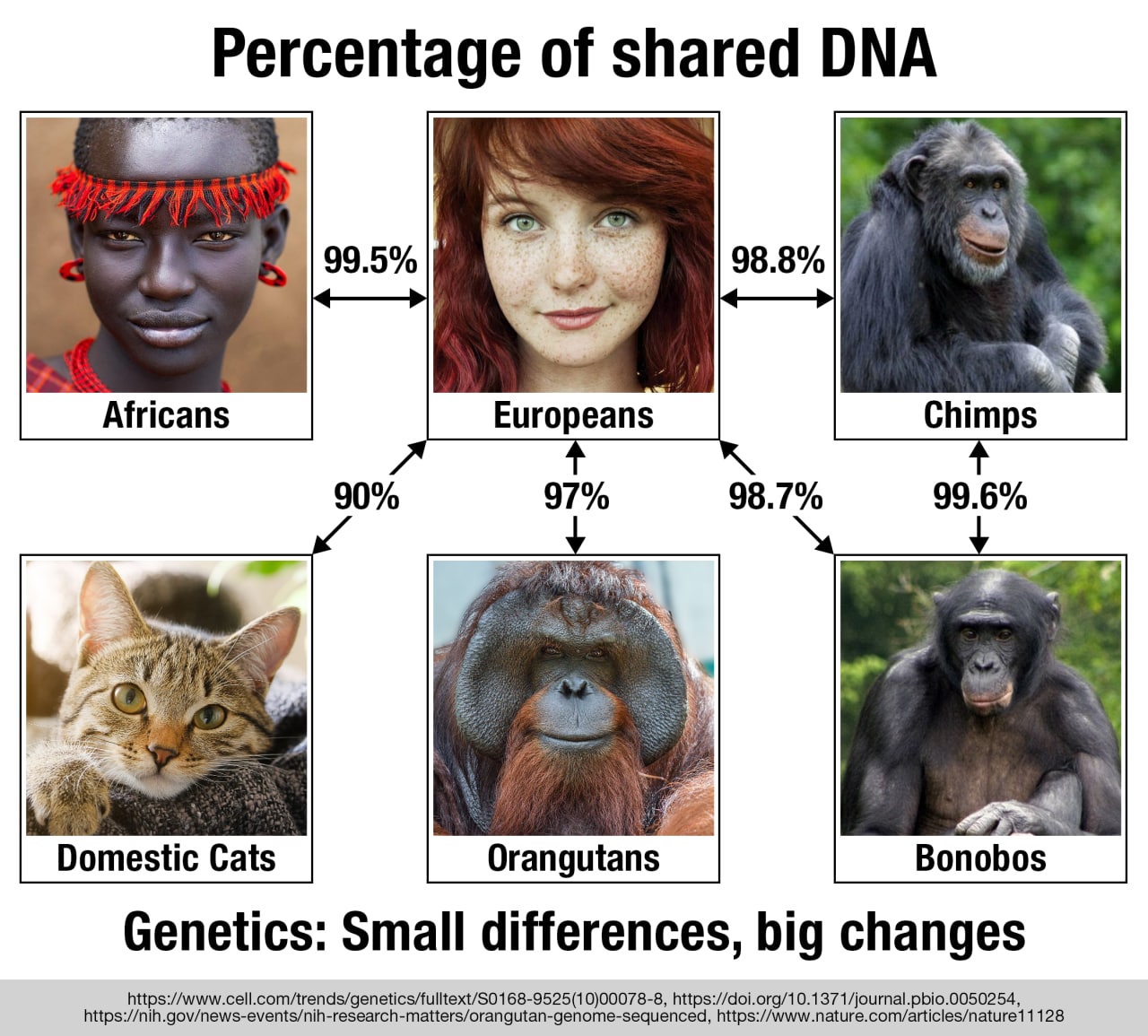
6.4. But you can’t always accurately guess a person’s race or genetics.
But you can’t always accurately guess someone’s race or genetics based on their appearance, especially if a person is mixed-race, which is becoming increasingly common in today’s world.
That’s true, but there’s a few points that we want to make clear:
- We do not advocate for phenotype being the primary or only way to determine taxonomy and genetic variation. Regardless, basing taxonomy on phenotypic traits and habitats has been the historically preferred method of taxonomical classification, and that’s still true when biologists are classifying non-human plants and animal species. It was also more accurate in the past before modernity enabled historically unprecedented race mixing.
- While taxonomy based on phenotypic traits is now somewhat outdated due to the advancement of new methods and information, as well as increased race-mixing, it’s not necessarily too inaccurate in many cases, even in today’s world. Nevertheless, we are absolutely in favor of using other factors besides appearance to determine racial admixture and classification.
- Even if it is difficult to tell what race someone is from, it’s easier to identify a person’s race the more and more people expose and familiarize themselves with what different people from different races look like. EthnoGuessr is an online game that people could play to improve their ability to guess a person’s race, based on their physical appearance.
- These points matter because:
- This is a point of contention that’s often brought up. We want to clarify our position on how taxonomy should be determined and what criteria have traditionally been used for taxonomy.
- Appearance does correlate with races and genetic traits. That’s part of the nature of race.
- Inaccurate guesses are often due to unfamiliarity with the physical characteristics of races.
- Being unable to guess a person’s race does not invalidate the truth claims of race realism.
- None of these contentions change our preferences for race-blind government policies.
- None of these contentions imply that we propose that appearance or race should be used in medical diagnoses, when more precise information is available.
And for the record, I can testify from personal experience that it is indeed difficult to correctly guess a person’s race. Most people can discern that I have European ancestry, but few people have guessed that I also have ~50% East Asian ancestry. The same is true for many people.
Related Game: EthnoGuessr, Guess the geographic origin of ethnic groups based on their phenotype.
6.5. Pancake Fallacy: “All races are mixed, therefore race does not exist”
See: Pancake Fallacy: “All races are mixed, therefore race does not exist” - Thuletide.
Human populations can’t be kept separate enough for long enough to develop highly distinct races in the modern world anymore.
That’s irrelevant. Mixed races inherit qualities from both of their ancestral races, so interbreeding merely changes the statistical genetic frequencies that define the world’s races. And when races do mix, the resulting race inherits the respective percentages of its ancestral races. Races may be mixing all over the modern world, but mestizos, mulattoes, and hapas are all still different from each other. Each of them may be half European, but they’re still half Amerindian, half sub-Saharan African, and half East Asian respectively. Thus, they all behave, think, and act differently from each other. Same with mulattoes, zambos, douglas, and blasians (all half sub-Saharan African).
The Pancake Fallacy uses similar tactical nihilism to the Continuum Fallacy.
6.6. Why is it practical to classify humans based on race, instead of traits?
RatWiki has stated the following question in their fallacious and bad-faith “Racialism” article:
Why stop with simplistic appearance-based racial classifications? Why not racially classify humans based on other genetic traits that are just as geographically dispersed as skin color?
Almost nobody classifies humans mainly based on traits, rather than race. That’s true whether someone is a race realist, a race denialist, or simply doesn’t care. When people talk about groups of people based on their genetics, their appearance, and/or their ancestry, it is very common and very accepted to describe and refer to people based on their race. In practice, the people who ask these kinds of questions still tend to talk about races as a way to refer to groups of peoples (e.g. complaining about how white people have more money than black people). So if it’s implicit that it’s okay for race denialists to talk about race, but not okay for race realists to talk about race, then this is tactical nihilism and it’s a bad-faith question.
More to the point, the answer is that classifying humans based on traits has less predictive power than classifying humans based on race. As stated before, the definition of race is “a statistical cluster of genetic variation which is characterized by phenotypic similarities and shared ancestry”. Hence, if we know a person’s race, but not their individual traits, then we can make predictions about a high number of their traits, and the predictions will have a high tendency to be correct. The same goes for IQ scores.
Obviously though, the best method for classifying humans depends on the context. If you can judge a person based on their personal traits than their racial background, that’s always more preferable. For example, medical diagnoses and treatment should always be conducted on an individual-by-individual basis.
Nevertheless, the main reason why it’s so taboo to acknowledge these facts is that it would strengthen the argument that most racial disparities are caused by genetic, rather than environmental factors. The argument that we can classify humans based on traits instead of race is a tactical nihilism argument. It’s not intended to be good-faith. The real intent of making such an argument is to hide the reality that some people (and some races) are naturally destined to be smarter, to commit more crimes, etc than others, due to their genetics.
6.7. But what about Lewontin’s Argument?
In 1972, a scientist named Richard Lewontin claimed that dividing humans into races or subspecies is biologically invalid because “there is more genetic variation within races than between them”. Supposedly, this means that the concept of race is meaningless.
However, the following would hold if we took this argument to its logical conclusion:
- There is more genetic variation within dog breeds than between dog breeds (Source). Therefore, different dog breeds don’t have meaningfully different mental or behavioral characteristics.
- The variation in height within males is larger than the variation in height between males and females. Therefore, women aren’t shorter than men.
- Schools don’t matter. School-level data for student outcomes is not worth considering because schools only account for 10 to 15% of variation in students’ academic achievement.
- The income difference between blacks and whites in the US is smaller than the income variation found among blacks and among whites. Thus, the income disparity between blacks and whites is insignificant and not to be discussed.
Obviously, these examples are all ridiculous and illogical.
Furthermore, an FST of 0.12 between human races represents the average increased probability of a single gene being different. Analyzing a single gene in isolation is unlikely to tell you the race of an individual, but analyzing multiple genes together can predict someone’s race to a high degree of accuracy.
As an example, suppose that you are asked to guess whether a person was a male or female, based on whether they were taller or shorter than average, or hairier or less hairy than average, or whether their voice was higher or lower pitched than average. If only one of these facts were told to you, you could make an educated guess, but there would be a decent chance that you would be wrong. If you combined data on say 20 such sex differences, your chances of correctly guessing the person’s sex would be very high. And as we all know, males and females are clearly distinct from one another. By the same principle, a single gene might not be a very good predictor of someone’s race, but that doesn’t mean that the combined data on many genes won’t be.
Read More:
6.8. Transracial Fallacy: “Two people of European descent may be more genetically similar to an Asian person than they are to each other”
As more and more loci are considered, the probability that two random people from two geographically distant populations (Europeans, Africans, Asians) will be more genetically similar than two random people from the same population becomes virtually zero. Source
6.9. There can’t be racial differences because human evolution stopped 50000+ years ago.
This is not true. To the contrary, human evolution has accelerated during that time. Since the advent of agriculture over the last 10,000 years, the human genome has been changing 100 times faster. In short, agriculture led to greatly increased population size. Increased population meant more individuals in which mutations could appear. More mutations meant that natural selection had more to work with.
Additionally, the rise of states and the more varied environments created by humans meant stronger and more geographically and temporally variable selective pressures, which further sped up human evolution. The age estimate of several human alleles (genetic variants) from Hawks et al. can be graphically demonstrated.
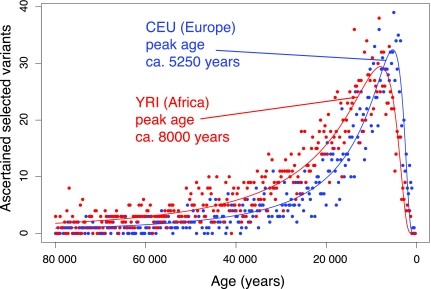
Read More:
- The 10,000 Year Explosion: How Civilization Accelerated Human Evolution by Gregory Cochran and Henry Harpending (2009).
- Wikipedia: Recent Human Evolution.
- We Cannot Transcend Evolution by Blithering Genius.
6.10. Why are anecdotes on race often misleading?
There are multiple reasons:
- The media is not representative of the average person from each demographic.
- For example, the black people shown on TV, in movies, advertisements, and high-social-status positions are not representative of the average black person.
- The Quillette argues that casting for African Americans unfairly favors “lightskins” for conforming to a more white beauty standard, being prettier, etc. While this is about appearance, rather than mental traits, it’s still good evidence that the media isn’t representative of the average black person.
- Parasocial relationships have increased during modernity, and they tend to distort people’s perceptions of other races to be more positive.
- Woke propaganda is strong.
Often time, it even discourages people from sharing anecdotes that portray some races in a bad light.
This hides the truth.
- Fake news tactics make it difficult for people to discern the truth.
- Wokists and the establishment deliberately portray underperforming demographics more positively than they actually are. Under the Parasocial Contact Hypothesis, the justification is that these portrayals will help reduce racial disparities.
- The problem is that this doesn’t tend to work. It also denies reality, which harms society.
- The mainstream journalists, academics, and other establishmentarians who promote race denialism propaganda tend to be upper-class people who live in nice neighborhoods and sheltered ivory towers.
- Wokism is largely a luxury belief. The people that the establishmentarians interact with are not representative the average person, and they tend to project their experiences into their works, and thus onto everyone else.
- People who are privileged enough to hold luxury beliefs aren’t altruistic/empathetic. They promote their luxury beliefs to conceal their wealth/gain status. They make it seem as if they hate white people, because it makes them appear weak/self-criticizing, when the motivation is optics only… not to actually be weak.
- The Contact Hypothesis proposes that “intergroup contact under appropriate conditions can effectively reduce prejudice between majority and minority group members”. However, reality is more complicated than this. There is some truth to the Contact Hypothesis, but it’s mostly false.
- If wokists had to interact with different and more representative demographics (e.g. facing reality essentially), then they’d be more likely to reconsider their views.
- Selective immigration policies make it difficult to discern the average intelligence of different races.
- Leftists are more likely to live in big cities. The blacks who live in big cities tend to have either migrated to the West through selective immigration policies, and/or they tend to have higher intelligence and more European DNA than the average African American.
- Most developed countries are low-fertility societies where people don’t have much experience with children.
Leftists and race denialists are especially less likely to raise children or be around children because they have lower fertility rates than right-wingers.
- The lack of child rearing experience in society thus makes it more difficult for people to understand how difficult it can be to make some people behave properly or get good grades in school.
- If people were raising more children, then it’d be easier for people to recognize how environmentalist interventions in children’s upbringings can’t always equalize the performance of different children and different races. This would make people more likely to consider that genetics has strong impacts on how people act and behave.
7. What Do Race Realists Think About Race-Mixing And Ethnic Diversity?
7.1. What Is Race Mixing?
Race-mixing is a natural phenomenon that can have both good and/or bad consequences for any biological species. Unlike species, which almost always go their separate ways after diverging, races split and merge in the same way that waves on a choppy sea split and merge. A racial category is just a statistical cluster of correlations among genetic variants. The distributions of variants, and their correlations, change over time. Races mix, merge, split, appear or disappear for all kinds of complicated historical and geographical reasons. For example, when Europeans discovered the New World, there was a lot of race-mixing, which lead to the creation of new races, like mestizos, mulattoes, and zambos. – Edited from Blithering Genius, “Killing the Unicorns”
Most humans would not exist without race-mixing. If you go back far enough in history, nearly everybody living today is “mixed-race” in a sense, and race-mixing was an important part of human evolution. Modern humans were formed from interbreeding between homo sapiens, neanderthals, denisovans, and other hominins, to varying degrees for all the races of the world. Many races have further split, mixed, merged, appeared, or disappeared since then. For instance, virtually all modern white people are a mix of Western European Hunter-Gatherers, Early European Farmers, and Proto-Indo-Europeans. There are both good and bad reasons to support or oppose race-mixing between modern humans, which will covered in the following subsections.
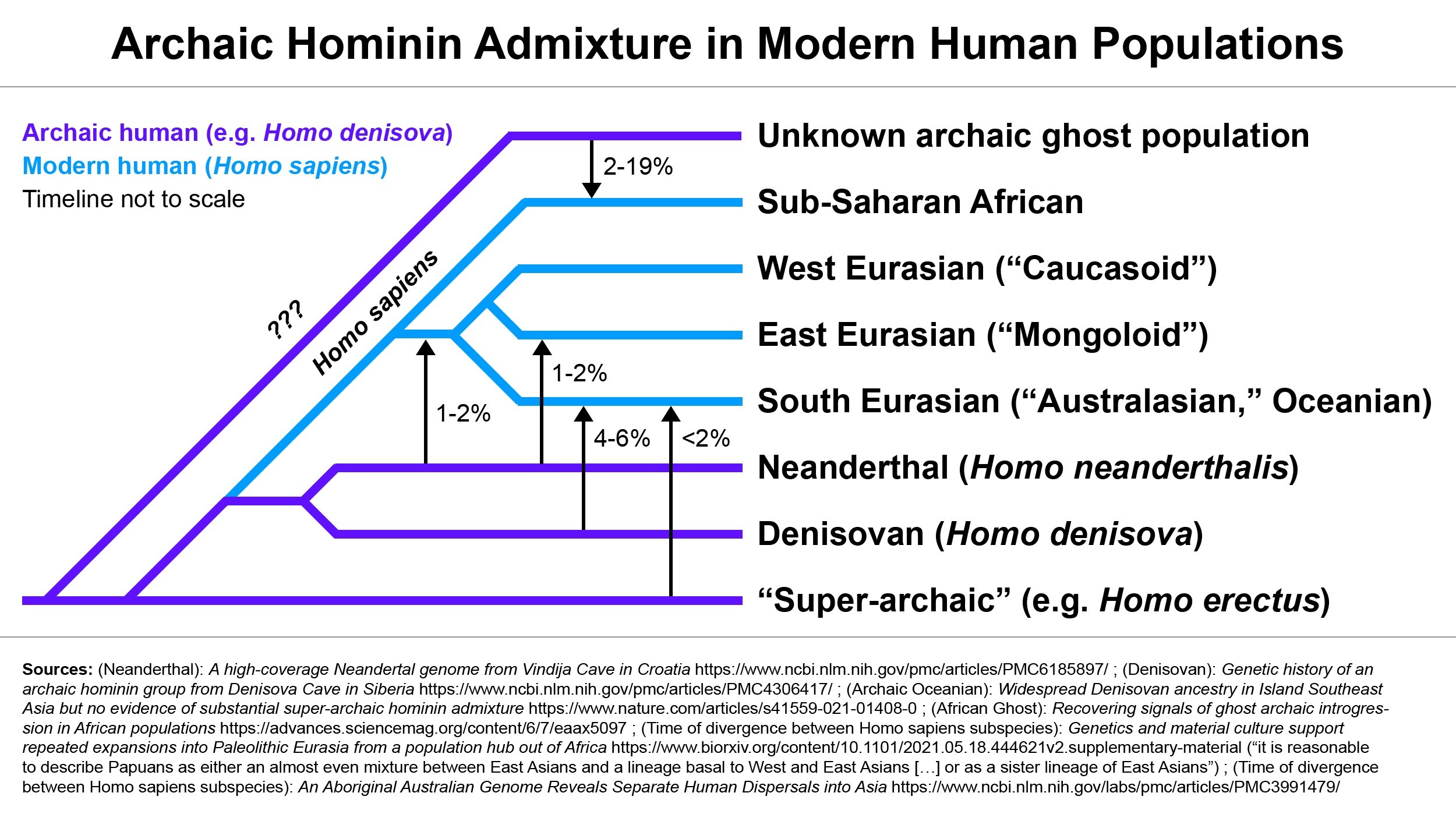 |
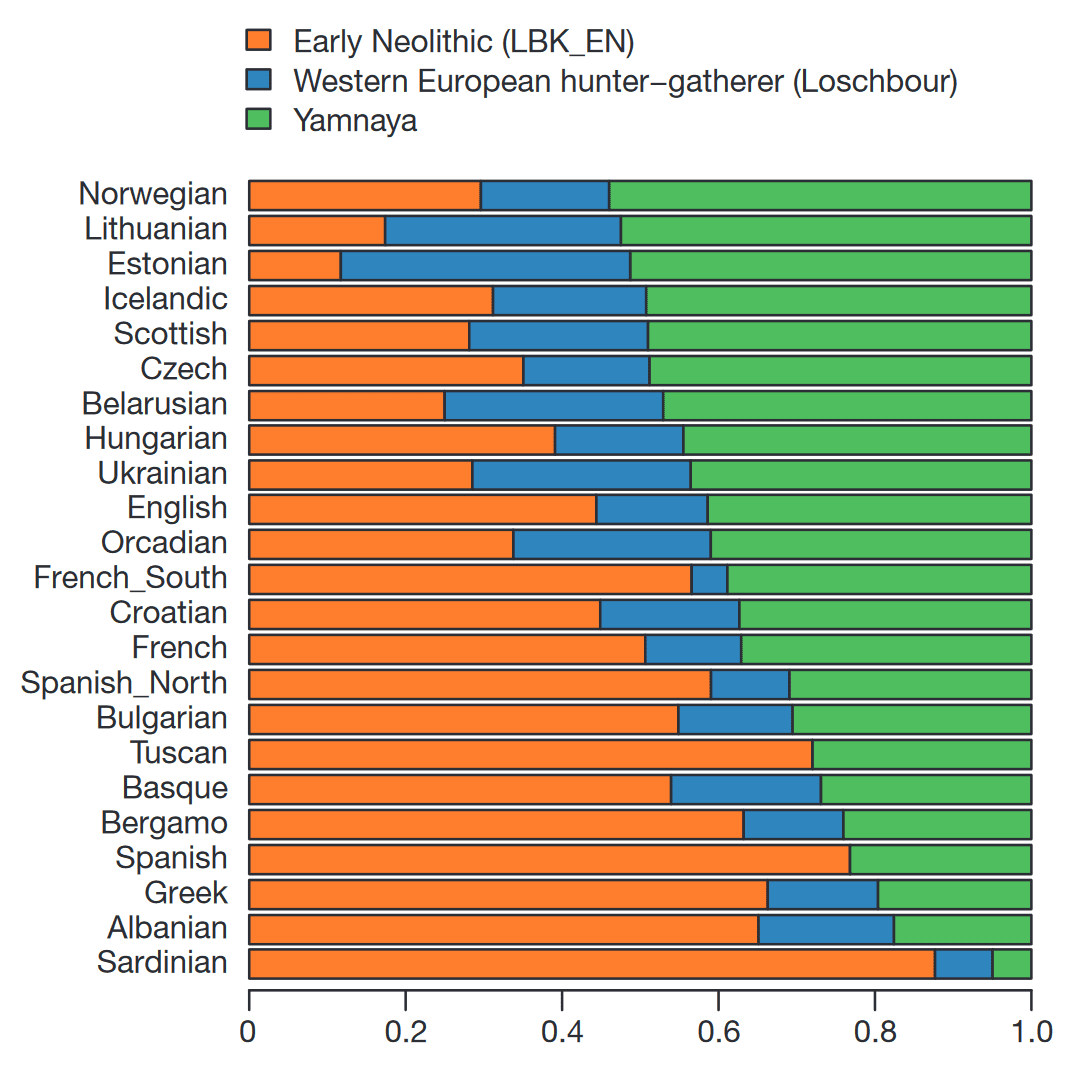 |
To an extent, the notion of “mixing” is somewhat misleading, because there aren’t separate discrete types that are being “mixed” together. Rather, existing racial clusters can disappear and/or change, due to different selective pressures and global migration. In that sense, some level of “mixing” is always inevitable, since genes are always mixed when a male and female mate and conceive a child.
Whether race-mixing is “good” or “bad” is a normative question – a question of value. Hence, we cannot evaluate race-mixing without defining the perspective that we’re viewing it from or without analyzing its effects. There are three main effects that race-mixing has on society that I’ve observed:
- Decreased Fitness, versus Increased Fitness. This falls under biological value. (the most obvious one to biological realists)
- Racial Discrimination, Conflict, Culture, etc. This falls under psychological and social value. (the most obvious one to basically everyone)
- The Dating Market(s) for different ethnicities and sexes. This falls under psychological and social value. (the most obvious one to incels, and people in interracial relationships)
I elaborate on each of these in the next few subsections.
Clarifications
Although East Asians tend to have higher IQs than white people, South Asians and Southeast Asians tend have lower IQs than white people on average.
The IQs of the diasporas for these people in Western countries can often differ significantly from the IQs of the people in their ancestral countries.
This is due to past and present selective immigration policies within Western countries.
Since the US and other Western countries don’t have optimally defined racial categories for collecting statistics about race (e.g. distinguishing between East Asians and Southeast Asians in the statistics that they collect), this makes it harder for people to realize the implications that race realism has for humans. In this essay, I use the terms South Asians to refer to people from the Indian subcontinent, Southeast Asians to refer to people from Southeast Asia, and East Asians to refer to people from East Asia. If I use the term “Asians” without any other descriptors, I am using it as a shorthand for referring to East Asians specifically.
7.2. The Effects of Race-Mixing on Biology
Biological value is what is good or bad for an organism. Fitness is the quantitative representation of individual reproductive success. Race-mixing is good for an organism if it increases its fitness, and bad if it decreases its fitness.
A potential disadvantage to race mixing on a global scale could be that populations around the world would become less adapted to their environments, which could cause some concern in some areas, but most of these possible concerns won’t matter much in the modern world. Some examples:
- Adaptive Coherence: Race-mixing could potentially interfere with a community’s adaptive coherence by causing more people to have genes that don’t work as well with the memes or culture of a given community, thus reducing fitness and disrupting the cultural character of the community.
- Disease Immunity: Immune systems tend to be adapted to local conditions, parasites, and diet. However, conditions in the modern world conditions are completely different than they are from the past: parasites are either gone or global, and diet is totally different and globalized. So this doesn’t matter much, as far as race-mixing is concerned.
- Organ Donation: Organ transplants tend to have greater compatibility and higher success rates with recipients who are of the same race as the donor. But as the world continues to race-mix more and more, this will become less of a problem over time, if it’s a problem at all.
- Giving Birth & Congenital Malformations: Mixed-race births face different risks for congenital malformations and babies born to WMAF couples have some of the highest rates of caesarean deliveries (33.2 percent). But this doesn’t matter much either. It’s a known fact that babies with genes that cause them to require C-sections to be delivered are becoming more and more common in the modern world, so even if race-mixing causes this to be a slight problem, it’s as much of a problem as how the prevalence of C-sections have been increasing. There’s much more critical problems to worry about in the modern world.
- Et Cetera
For most traits, race won’t matter when you take the parent’s traits into account. Good looking parents have good looking children, smart parents have smart children, and tall parents have tall children.
Since races tend to already be well-adapted to the respective territories that they inhabit, most of the genes from a race that evolved in a foreign environment are unlikely to improve the fitness of the race living in its local, ancestral environment. Nevertheless, race-mixing still has the potential to introduce genes that could increase the biological fitness of a population. For example, the Sherpa people in Nepal have a gene of homo denisovan origin, which makes it easier for them to breathe at higher altitudes and thus makes them more fit for their respective environment. The Sherpa wouldn’t have that gene if homo sapiens never interbred with homo denisovans. More generally, allowing genetic recombination is important for allowing complex life on Earth:
There is another mixing process that could be relevant to questions of race, race-mixing and human genetics in general. There could be co-adapted alleles of different genes that occupy the same region on a chromosome, that tend to be passed together to offspring as a package. Recombination could break up those packages, not only in the first generation, but in subsequent generations. Let me explain.
DNA is packaged into chromosomes. You inherit one chromosome from each parent, but the chromosome you inherit is not a copy of one of your parent’s chromosomes. Instead, it is a combination of both of your parent’s copies of that chromosome. During meiosis, crossover mixes the DNA of the parent’s chromosomes. In a sense, sex takes place not only between organisms, but also between paired chromosomes. Chromosomes “mate” by mixing their DNA to produce a new chromosome. As an aside, I believe that recombination is a mechanism to prevent chromosomal competition. If chromosomes were replicated as units, then there would be the potential for competition between the two copies of a chromosome. In fact, there can be chromosomal competition between sex chromosomes, which do not recombine. (See here for example.)
Recombination would eventually break up these genetic packages, recombining them with the genes on a different strand. It could be that mixing races, or mixing genetically distant subpopulations (whether we consider them to be races or not) could break up co-adapted gene complexes not only in the first generation, but in subsequent generations. Crossover could cause a kind of multi-generational “regression to the mean” that is not true regression to the mean. If your chromosomes are different, then combining material from them to produce a new chromosome could break up gene complexes.
I raise this issue because it is an interesting possibility to consider, but I don’t think it is something to worry about in humans. It is theoretically possible that “out-breeding” (mating with a more genetically distant person) could cause problems by breaking up co-adapted gene complexes. On the other hand, in-breeding can also cause problems, such as genetic diseases caused by recessive genes.
Nature doesn’t have any rules about who breeds with whom. Organisms mate, produce offspring, and then selection operates on them. Gene flow is not intrinsically harmful, and it is necessary to bring together beneficial mutations that occur in different populations. Also, the repeated mixing of DNA forces genes to work well with other genes, and makes the genome more “modular”. The constant mixing of DNA by sex might be really important in creating complex life, not only because it allows beneficial mutations to become associated, but also because it prevents DNA from becoming ad hoc, tightly coupled “spaghetti code”. Just as reuse in different contexts forces programmers to create cleaner code, the reuse of genetic code in different contexts forces evolution to create cleaner genetic code.
– Blithering Genius, “Regression to the Mean”
For all biological organisms more generally, interspecies breeding can sometimes create new species that have unique collections of adaptations that enable them to fill ecological niches that neither of the parent species could tap into.
Biology Video: Why Hybrid Animals May Take Over the North – Real Science.
Biology Video: The Hidden Timer That Kills Every Species – Extinct Zoo.
As mentioned in Does Evolutionary Theory Imply Genetic Tribalism?, race-mixing between European men and native women proved to be a great reproductive strategy for both sides where both races were able to exchange positive contributions for raising their children together. From the perspective of the Mestizos and their ancestors, this race-mixing was a good thing. From the perspective of white nationalists, it was a bad thing. More Information: Effects of Race Mixing - Metapedia (Biased Source).
7.3. The Effects of Race-Mixing on Individuals
Race-mixing can sometimes lead to identity problems among the offspring of interracial couples. However, most mixed-race people say that it hasn’t made a difference for them, or that’s even been an advantage. In the latter case, this is likely because they’re proud of their ancestry.
Even if someone argues that the mixed-race respondents to the Pew poll have no idea what it would be like if they were born to only one race, it’s still natural for humans to be proud of their race and ancestry, regardless of whatever they are. Humans are naturally selfish, and racial pride in one’s ancestry and oneself is useful for justifying one’s existence and continued survival. So while this poll and similar ones rely on self-reported data, and while they could have larger sample sizes (n = 1000), it’s likely that they’re closely aligned with reality.
Related: Racial Pride is Reasonable - Gnew.
It’s often assumed that mixed-race children are more likely to have physical and mental health problems. There’s conceivably some truth to this, but the only study that I could find to support this claim had a low sample size. More studies and greater sampling should be made on this topic before reaching a more definitive conclusion. A better explanation for why mixed-race people are more likely to be neurodivergent is that neurodivergent people are more likely to miscegnate:
Neurodivergent people tend to interracially date and as a result of genetic transmission mixed-race individuals are more neurodivergent relative to monoracial ones, even after accounting for ancestry, discrimination, and the effects of genetic mixing itself. There is also assortative mating between races beyond characteristics that differentiate interracial daters themselves.
– Copy-edited from Sebastian Jensen
Read More: Interracial Dating Paper FAQ.
If you can reasonably expect your children to face significant discrimination or outbreeding depression for being mixed-race in the future, it could be better for your future children if you can avoid breeding with other races. However, this problem will gradually disappear as tolerance for other races continues to increase, and as race-mixing further blurs racial differences.
According to most polls, a majority of people around the world identify more strongly with their country or nationality than they identify with their race. Race doesn’t have much effect on most people’s identities, regardless of whatever race they are. That’s true for multi-ethnic and multi-racial countries just as much as it’s true for (relatively) ethnically homogenous countries.
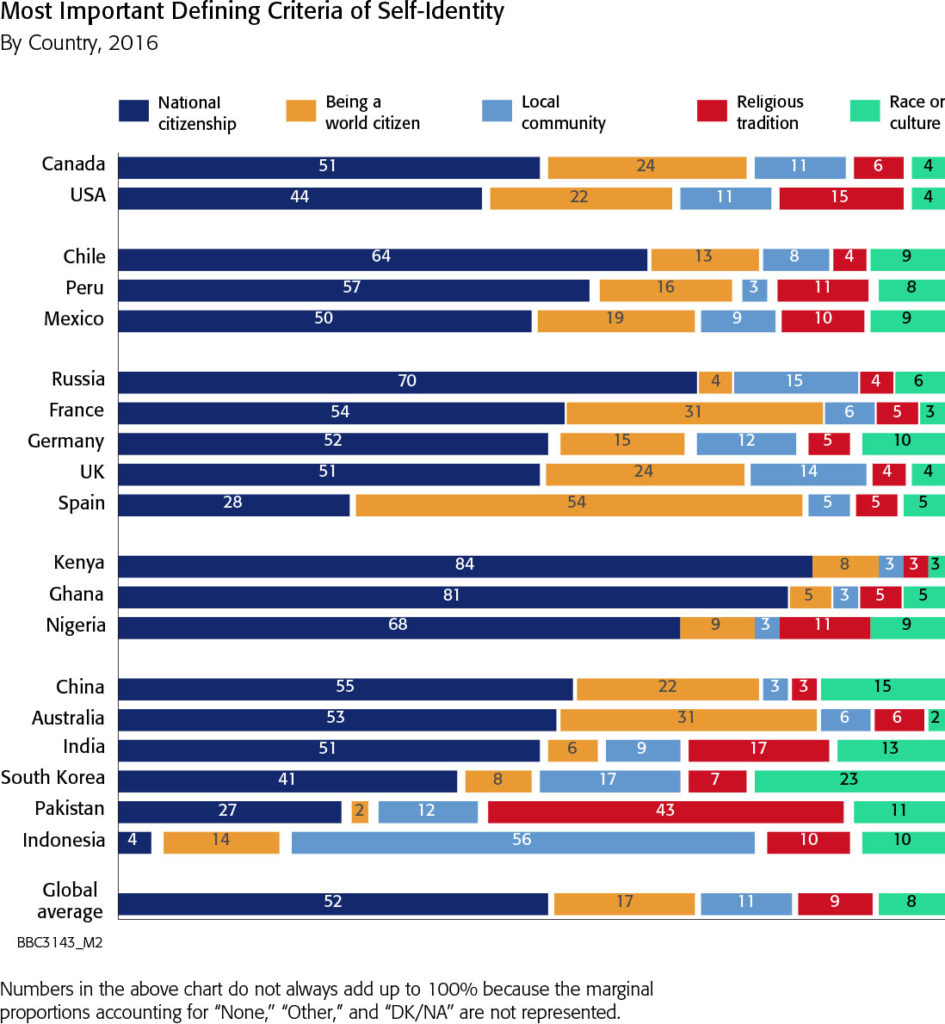
7.5. The Effects of Ethnic Diversity on Culture
To an extent, a multiracial society may also be a multicultural society that gains cultural enrichment from the collection of all the various different races cohabiting the same space. For example, the United States has managed to blend a lot of different European races and traditions together, and while there are clear examples of how this diversity has created a rich and varied culture in the United States, there’s also examples of how it has created division instead (e.g. Anti-Catholicism, anti-German sentiment during and after WWI, anti-immigrant sentiment, etc). The extent to which European races and cultures have been successfully mixed together can be attributed to the comparatively lower genetic differences and not-as-drastic culture shocks of all the various European immigrants, in comparison to say mixing white culture with black culture. Generally speaking though, it isn’t necessary to mix races together in order to spread cultural traditions to spread nowadays, especially during the Internet age, international commerce, and mass media.
Race-mixing tends to have better outcomes when the races that are being mixed are closely related to each other. One example includes how Western Hunter Gatherers interbred with Early European Farmers and how their offspring later mated with Proto-Indo-European descendants. The WHG, EEF, and PIE peoples were closely related, and each separated by a few thousand years of evolution. Another example is how all the various white immigrants mixed with each other in the United States during the 1800s and 1900s to create mixed-race white offspring. After the ethnic tensions passed, pretty much all the white immigrants who arrived to the US were well-assimilated, and it created the perfect individualist and hard-working population for creating the most powerful and most prosperous country on Earth.
Multi-ethnic countries are more likely to be multilingual. Being multilingual in each of the country’s national languages can have economic advantages if the languages spoken in the country can be used to communicate with other countries (e.g. Switzerland). But it can also hinder a country’s economic progress if the languages aren’t widely spoken outside the country (e.g. India, Indonesia, Papua New Guinea, DRC, etc). An overwhelming amount of diversity in indigenous languages creates social and communication barriers. It also requires more time and education to learn other languages that are spoken inside and outside the country.
Dysgenics is another consideration regarding race-mixing within a society. Not all humans are created equally because genes and traits vary from population to population (e.g. IQ, impulse control, psychopathy, etc). For Western countries, the average IQ for white people is approximately ~100 and since whites have the highest IQs in the world besides Ashkenazi Jews and East Asians, if whites were to race-mix with other races, then the resulting offspring would probably have lower IQs on average when compared with the rest of the whites in the society. Of course, IQ is only one polygenic trait to be considered, and we’ve already mentioned from a biological perspective how race-mixing can have many negative effects on organisms and populations that could make them less biologically fit for the environments that they inhabit.
Links For Reading More:
- The Negative Impact of Racial and Ethnic Diversity Upon Societies and Individuals
- [Study] How Races Rate Each Other
- In-Group Preference (aka “Racism”) by Race and Political Alignment
- We are biologically programmed to be attracted to people who are genetically, physically, and psychologically similar to ourselves
7.6. The Effects of Miscegenation on the Dating Market
White Male Asian Female (WMAF) couples are popular in the West when considering how many Asian women marry outside their ethnicity. Likewise, Asian men and black women are statistically the least desirable races of their sexes when it comes to dating preferences. The 2010 US Census confirms that these trends extend from dating to interracial marriages too, with 8.2% of Asian men marrying outside of their race while 17.5% of Asian women did the same, and that 10.8% of black men married outside of their race compared to 4.6% of black women.[10] This has caused many Asian men and black women to be unable to find other people to date and marry since they are not able to marry outside their race at the same rates. Meanwhile, the dating market for white people is nearly balanced since the number of white men who are marrying Asian women is compensated by the number of white women who are marrying black men. These multi-racial dynamics have lead to Asian men and black women being unlikely to get sex, love, and children.
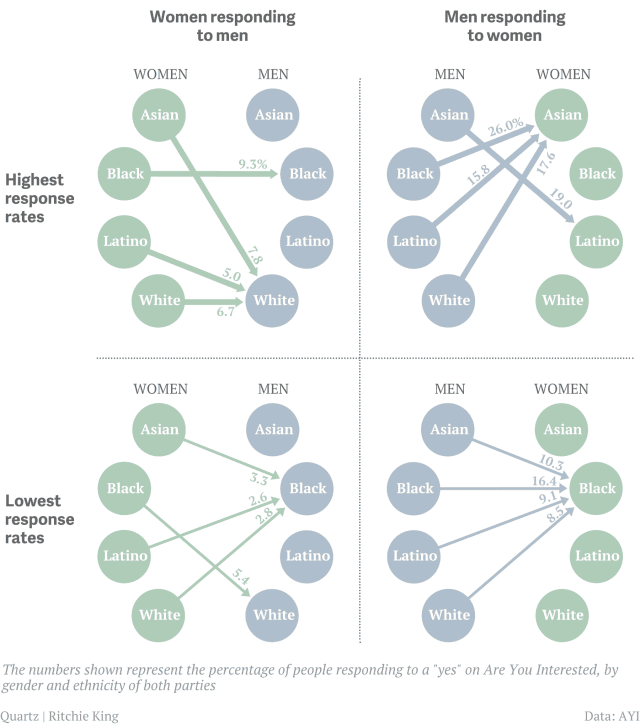
From a societal perspective, the main problem with race-mixing between Asians and whites is that it deprives millions of Asian men of love, sex, and children. This wouldn’t be a problem if fewer Asian women dated outside their ethnicity, or even if as many white women dated Asian men as there are white men dating Asian women. But this is not the reality. Aside from that, East Asians have favorable genetics for maintaining modern civilization due to their higher IQs, lower crime rates, and greater propensities for hard work compared to white people, and White-Asian multiracial adults are also the most likely to say that their racial background has been an advantage. These facts affirm that the dating market imbalance created for East Asian men is the primary disadvantage to race-mixing between Asians and whites, from a societal perspective centered in the Western world.
Some people have suggested that black women and Asian men could pair together since they are both the least desired ethnicities of their respected sexes, but I predict that this is unlikely to be a good matching in most situations, otherwise they would’ve already done so. They’re too genetically different from each other, not attracted to each other enough, and the average intelligence between the two may be too different for them to be compatible together (although IQ differs a lot between East Asians, Southeast Asians, and South Asians). Another thing to consider is that black women have the highest testosterone levels of all women, whereas Asian men have the lowest testosterone levels of all men, which helps explain why Asian men and black women both have relatively low desirability. The difficulty of Asian men and black women trying to find a partner will probably decrease fertility rates slightly, which can be a good thing if the country is on the verge of overpopulation, or a bad thing if the country wishes to boost its population.
Why does it matter if white men and Asian girls date? If they both love each other, why should it matter who dates who?
The fact that so many people think this way demonstrates that most people don’t consciously or attentively realize the nature of how value judgments for objects are both positive and negative:
Unlike truth, value is not convergent for similar brains. Tom and Joe could have identical brains, but make very different value judgments from their perspectives. For example, suppose that Joe and Tom both want to date Sally. Their value judgments are identical in one way, but opposite in another way. Joe positively values Joe dating Sally, and negatively values Tom dating Sally. Tom positively values Tom dating Sally, and negatively values Joe dating Sally. – Blithering Genius, from What is Subjectivity?
In the context of the sexual market between the country’s ethnicities, we can state the following:
- The Asian male positively values being with the Asian woman and negatively values the White male being with the Asian woman.
- The White male positively values being with the Asian woman and negatively values the Asian male being with the Asian woman.
From the individual-centric perspective of the partners in a WMAF relationship, they both positively value race-mixing, since it allows them to be together and procreate together. From the ricecel’s perspective on WMAF relationships, they negatively value that race-mixing since it deprives them of partners to procreate with. The high rates of inceldom among Asian men is a good example of how race-mixing has noticeably unfavorable consequences on society (especially for incels in particularly), although we should acknowledge that it’s also had favorable consequences between WMAF couples as well.
At the end of the day, the only thing that matters (as far as reality is concerned) is who has the power to get what they want and make it happen. Preventing the race-mixing from ever happening in the first place can only be achieved by segregation or preventing the mass immigration of Asians into Western countries. But that has already happened. Besides pop-cultural movements that could portray Asian men and black women in a more positive light (e.g. K-Pop has recently given Korean men somewhat higher social status), or shaming Asian women and white men for marrying outside their races, there isn’t much else that can be done to prevent a sexual market imbalance for Asian men. It will suck for the Asian men, black women, and everybody else who ends up being unable to find loving partners, sex, and children for life, but countless people throughout history also lived that way until the day they died. Their lineages died off, and they were forgotten about forever. Such is the nature of life.
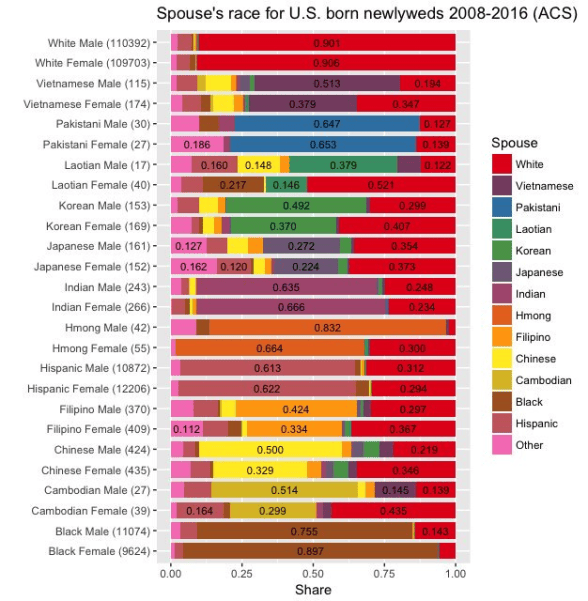 |
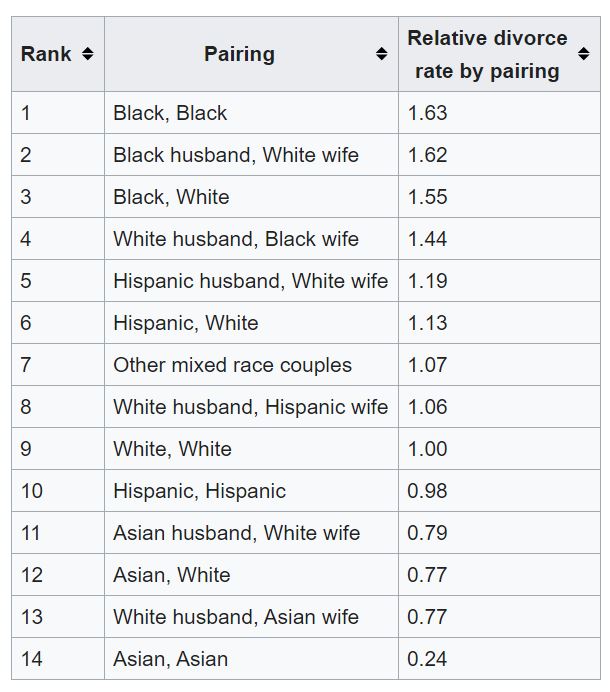 |
Ethnonationalists tend to argue that interracial marriages have higher divorce rates, but it would be more accurate to say that divorce rates generally depend more on race than race-mixing. For instance, Black + Black marriages have the highest divorce rates, Asian + Asian have the lowest, and WMAF divorce rates are lower than WMWF divorce rates. The pairing table shown here is pretty much what we would expect to see, based on theory and observation.
Read More:
- Racial Dating Preferences and Sexual Racism – LessWrong Post.
- The rise of multiracial and multiethnic babies in the U.S. - Pew Research.
- Demography from multiracial children to gender identity - Pew Research.
- Interracial marriage: Who is ’marrying out’? - Pew Research.
- Other Pew Research Intermarriage Articles.
- Pew Research Statistics: Key facts about Asian origin groups in the US.
- Study finds bias, disgust toward mixed-race couples (2016).
- Demographics of Inceldom - Incels Wiki.
7.7. Is the Contact Hypothesis True or False? Why?
The Contact Hypothesis proposes that “intergroup contact under appropriate conditions can effectively reduce prejudice between majority and minority group members”. The Wikipedia article mostly cites evidence in favor of the Contact Hypothesis, whereas race idealists tend to cite evidence suggesting that the Contact Hypothesis is false (i.e. interracial contact increases discrimination). My beliefs on the Contact Hypothesis are more nuanced than a simple “true” or “false”.
Evidence Against The Contact Hypothesis
The way how inter-racial contact affects people’s perceptions about race probably depends on many different factors. We can identify multiple reasons why races may want to avoid each other, including linguistic, cultural, religious, and appearance differences, as well as different propensities for violence. Exposure to such strong contrasting differences likely increases hostility to other races for most people, since these differences reduce social stability.
When whites and blacks live next to each other, white flight tends to increase. The higher crime rates and greater violence among black people is probably the main cause of white flight, and a leading cause of social instability and inter-racial tensions in cities. Wokists usually attribute white flight to anti-black racism, but this ignores that blacks have higher crime rates than whites. Crime is well-documented to worsen urban sprawl. The poorer academic performance of blacks probably also contributes to white flight. Increasing the black populations of public schools likely decreases the quality of public education provided to white students, since accommodating lower performing students often comes at the expense of providing optimal resources for higher performing students. It’s also conceivable that anti-white racism (e.g. demographic quotas) exacerbate white flight.
The Wikipedia statement of the Contact Hypothesis also specifies “under appropriate conditions”. This prepositional phrase does a lot of heavily lifting. For academics (the people who conceived the Contact Hypothesis), “appropriate conditions” is likely white graduate students interacting with black graduate students for hours about sociology studies and other academic stuff. Ergo, “appropriate conditions” has a selection bias, since white and black graduate students aren’t representative of average everyday people.
It is delusional to believe that a few positive interactions can wash away all discrimination. Research on the Contact Hypothesis should focus on repeated and strong interactions with outside groups, not brief single interactions. It should also design a reliable metric for quantifying the “prejudice” that people might have. Prejudice can range anywhere from a minimal bias that barely impacts a person’s personality, to alt-right racism that makes up a person’s main obsession and personality.
It’s also worth pointing out that alt-right racism usually has no correlation with behavior. Most racists don’t usually treat black strangers much (if any) differently than white strangers. Even if they hate other races for whatever reason(s) that might be, it’s usually foolish to behave without a mask in public, since that tends to have undesirable social repercussions.
Lastly, Werkat cites other evidence against the Contact Hypothesis:
- When whites and blacks live next to each other, support for slave reparations and wokism decline.
- Exposure to immigrants doesn’t moderate the relationship between disgust sensitivity and opposition to immigration.
- There’s a high publication bias in favor of affirming the Contact Hypothesis, since academia has widespread woke biases.
Evidence In Favor Of The Contact Hypothesis
The Contact Hypothesis isn’t totally devoid of evidence, especially when it was first proposed in the mid-1900s, when data on multi-racial and multi-group environments in Western countries was rather scarce.
There is at least some evidence and valid reasoning to suggest that it sometimes true, especially when multiple conditions are satisfied.
The Wikipedia article suggests that equal status, common goals, intergroup cooperation, and liberal laws are four conditions that are critical to reducing prejudice under intergroup contact. I agree that satisfying these conditions can lead to more mutually positive inter-group relations, however I’m skeptical that having common goals necessarily improves inter-group relations. Often times, having common goals (e.g. obtaining money, obtaining prestigious positions, etc) actually increases competition, rather than cooperation between groups.
As mentioned before, the Contact Hypothesis doesn’t consider that groups that are already more similar to each other tend to get along with each other better. The thesis and evidence for the Contact Hypothesis are stronger when outgroups have fewer differences between each other. It also makes sense to postulate that hostility immigrant groups tends to decrease if or when immigrants assimilate into the main society, culturally, linguistically, religiously, political allegiance, etc.
We know that some animals fear humans since they don’t know whether humans pose a threat to them or not. When many animals are exposed to humans, they may judge that humans are harmless. Similar patterns sometimes apply when outgroups interact with each other. Exposure to other groups may thus theoretically reduce stranger danger attitudes towards outgroups. Intergroup contact may also increase people’s ability to do perspective-taking for people from outgroups, which may reveal that outsiders have commonalities and are capable of inter-group cooperation.
It’s not unreasonable to conclude that the rise of humanism has probably caused many people to view out-groups more positively, when they otherwise wouldn’t have. Research has shown that there is a positive correlation between heterosexual people who personally know LGBTQ+ people and less discriminatory attitudes towards such people. Of course though, there may be a selection bias present here. LGBTQ+ people are probably more likely to come out to more tolerant people.
Homosexuals and bisexuals are also more likely to have only a single difference (i.e. sexual orientation) against heterosexuals, whereas there tends to be multiple differences between people from different races, besides just race. Unsurprisingly, tensions against transgender people increases when they are granted greater rights in society at the cost of the freedoms of normal cisgender people.
Conclusion
Overall, I judge the Contact Hypothesis to be mostly false, when considering a wider range of characteristics and explanations.
Most evidence suggests that ethnic and demographic diversity tends to destabilize societies, unless the minority demographics assimilate and conform to the majority.
Although the Contact Hypothesis Wikipedia article cites many reasons and studies in favor of it, the criticisms section actually affirms that most evidence contradicts the Contact Hypothesis.
7.8. Final Thoughts on Race-Mixing and Ethnic Diversity
Whether race-mixing is “good” or “bad” depends on one’s values, the races being mixed, and the perspective that it is viewed from. In my case, I positively value the race-mixing that eventually lead to my creation, and I negatively value race-mixing if it leads to me being deprived of any potential partners to date, marry, and procreate with. Alternatively, it makes sense to positively value race-mixing when it enables the subject to find a more suitable partner to procreate with.
If I had to make a choice from a societal perspective, I would generally oppose race-mixing in most cases. There’s no evidence that racial diversity confers any major advantages to a society in any real way. Racially homogenous society are more optimal for creating more stable civilizations. However, creating ethnostates may not be viable in multiracial countries, or even in Modern Western countries where minorities now make up too high of a portion of the population. Race-mixing is only likely to continue and speed up in the modern world as time passes. Whites in the West could hypothetically race-mix with East Asians to result in offspring with slightly higher IQs, but race-mixing between whites and East Asians would still cause somewhat negative consequences for society. Asian men in particular would be the most affected, unless AMWF relationships were to become as common as WMAF relationships. Until then, this will be the main downside to whites and East Asians cohabiting the same society. Regardless, most race-mixing won’t matter much for societies in the long-term.
Preventing overpopulation, mass immigration, and environmental degradation are much more important problems than miscegenation will ever be. Modern healthcare and technology eliminate most of the biological concern against race-mixing, assuming that modern civilization won’t collapse in the future. And racial conflicts, discrimination, and imbalances in the sexual market will be gradually reduced over time to an extent if race-mixing and tolerance of other races continues to become more common. There are also some cases where race-mixing can be a “good” thing (depending on the perspective). In the long run, race-mixing won’t be a major problem for modern societies that restrict mass immigration and practice population control and laissez-faire eugenics.
8. Does Race Realism Promote Collectivism?
This depends on the definition of “collectivism”. In this case, I define collectivism as: when individuals place the collective above the individual for the sake of the collective, or in other words, when individuals sacrifice their individuality and personal benefit for the collective.
To answer the question with respect to this definition, the answer is “no” because biological realism (a more general concept than race realism) is nothing more than a set of truth claims. Accepting truth claims doesn’t necessarily imply any value judgments.
Part of biological realism entails recognizing that all life (including humans) is intrinsically selfish. A functional society has to figure out ways to coordinate selfish actions into cooperation. Altruism is self-defeating and cannot exist long-term in (human) nature:
- Debunking the Selfish Gene by T. K. Van Allen
- Altruism and Selfishness.
- Kin Selection Theory is Wrong.
- Bees are not Social/Altruistic.
- Pathological Altruism.
- Family and Society: Transfers of Energy and Exchanges of Labor.
8.1. But don’t the members of each race evolve together (group selection theory)?
No, they don’t. The group selection theory of evolution is incorrect. There is no identified mechanism for how such it would actually work in the real world, and group selection theory doesn’t explain anything any better than the phenocentric theory of evolution does. Selfishness occurs on the individual level, so life isn’t just a competition between groups, but also between organisms that compete for resources among the other organisms in their respective groups.
There are better explanations than altruism to explain why organisms might help each other in nature:
- Parents care for their children because they have strong selfish incentives to do so for their own reproductive success.
- Kin altruism between siblings is best explained as the parents’ selfish behavior being expressed in the children as part of their extended phenotype (cooperative children are easier to raise than non-cooperative children).
Hypothetically, this could also extend to cousins, as part of the extended phenotype of their grandparents, but the selective pressure would be much weaker.
Even sibling altruism is not a general rule. It tends to occur in species that have nests, where sibling competition could be very harmful to the reproduction of the parents. Even in nesting species, sibling competition is very common. - Most people would never “self-sacrifice” themselves to benefit their societies.
The incentives for why people may fight (and die) for their societies are better explained by selfishness:
- Soldiers/warriors may expect to win the war. Perhaps he believes that he can and will rape or marry the other tribe or society’s surviving women, if his side wins. Winning the war provides him with a potential opportunity to become reproductively successful.
- Their societies brainwashed their minds with propaganda to sacrifice themselves for the “greater good” and that supporting this greater good is somehow in their best interests.
- They were forced or conscripted by their own societies to fight in said wars.
- A person might fight in a war for social status. If their side wins and they didn’t do their part, then their side might exile them from the society for being a free rider who did not contribute his share part of the war effort.
- Stotting/pronking is a demonstration to predators to try catching someone else in the herd that is obviously less physically fit than the pronker.
- Friends helping friends is cooperation motivated by selfish interest and the emotional accounting system, not “reciprocal altruism” (which is oxymoronic since altruism is selfless).
- Other purported examples of kin altruism can be further disproved on a case-by-case basis.
It is wrong to assume that childless people who do things that help other people in their society or tribe are doing so to benefit their tribe or their tribe’s shared genes. We have desires that are instrumental to reproduction, not automatic desires to reproduce. So of course it’s possible for people to do actions that help others. It’s possible even if those actions don’t benefit their own reproduction, and are hence maladaptive. That remains true regardless of whichever evolutionary selection theory is true. So, it’s not necessary for the phenocentric theory to explain why that happens. That is not an argument against the phenocentric theory.
Read More:
8.3. But race-mixing is uncommon. Ethnically diverse areas have lower social cohesion.
Yes, there are multiple reasons for that:
- Different races are less likely to share a common territory. Geographic barriers prevent race-mixing.
- Different races are less likely to share a common language.
- Different races are less likely to share a common religion, culture, and/or values.
- Some races are more likely to commit crimes and are less cooperative. Higher crime rates lead to lower social cohesion and lower trust, even among races that are less likely to commit crimes.
- Most people favor people who look like themselves.
The first three factors (geographic barriers, language, and religion) aren’t even related to genetics. The tendency towards ethnocentrism and the lack of social cohesion in multiracial societies is clearly much weaker when controlling for the first four factors. It’s easy for selective immigration to control for the first four factors, and the last factor isn’t really a big deal.
Ethnocentrism is common among humans, but it should be stressed that it is mostly a learned behavior, rather than innate. Ethnocentrism doesn’t strictly depend on race. It can depend on other factors like sharing a common language or a common religion. And the preference to be around people who look similar to oneself or to one’s family can be explained at least partially by the mere-exposure effect.
8.4. But people who breed with other races are “throwing away their blood lines”.
People who breed with other races are “throwing away their blood lines”. They are not preserving their genes.
They are still preserving their genes. No matter who a person mates with, the child can only inherit ~50% of his/her genes at most. That doesn’t become false just because she/he is breeding with someone of a different race. To conclude otherwise is a fallacy. Did the homo sapiens throw away their bloodline when they bred with neanderthals, denisovans, and other hominids? Or the ancestors of modern people? Again, it’s the genes that get passed on that matters, not the race.
Also, race-mixing doesn’t always negatively affect a person’s reproductive fitness or adaptivity to the environment. People don’t necessarily value genes just because they have them encoded into their own DNA. People value genes that make them and their children more adapted to their respective environments. For example, a person with sickle cell anemia is not going to value having a child who also has sickle cell anemia if they also value their reproductive success. If procreating with someone of a different race would improve the fitness and other desired qualities of one’s prospective children, then race-mixing is warranted and preferred according to the subject’s psychological values. Aside from valuing adaptive genes, in most cases humans would tend to value that their offspring have genes that are the same as their own, if and only if those genes are not maladaptive.
More generally, most animals in nature try to mate with as many other animals as possible. Mating with multiple partners instead of just one increases the genetic diversity of their offspring, which increases the probability that some of their offspring will be successful. Humans have this natural instinct too, which is why humans have adaptations like the Coolidge Effect that motivate us to mate with multiple different partners, rather than just one or someone is the most genetically similar to us. This is further evidence that the reproduction of successful offspring is the true biological purpose of life.
But insisting that only a maximum of 50% of genes are passed on disregards the shared or non-shared genetics in one’s mate.
By this logic, group selection theory concludes that it was a mistake for the ancestors of modern white people (Western European Hunter-Gatherers, Early European Farmers, and Proto-Indo-Europeans) to interbred with each other to create mixed-race offspring. But given that most white supremacists are supportive of the historical race-mixing that lead to their creation, this implies that it’s contradictory for them to unilaterally oppose all race-mixing. It also suggests that they should re-evaluate their opposition to race-mixing.
Moreover, virtually nobody (except maybe for the most fervent believers in the genocentric theory of evolution) actually calculates with mathematics how closely genetically related they are to the person that they are mating with just to make sure that the offspring will have as many of their genes as possible. It’s simply ridiculous that anyone would actually prioritize genetic similarity with their partner over other traits that are much more likely to be desirable instead. The fact that basically nobody thinks that way is further evidence in favor of the phenocentric theory of biological purpose, instead of the genocentric theory.
The genocentric theory of evolution also ignores the mutations that every organism inherits, which is an important reason why anyone would be motivated to care for their children instead of other people’s children in the first place. Currently, every human is born on average with ~60-100 or so new, random mutations, although most are situated in non-coding DNA and are neutral. So even if someone breeds with someone of a different race, their child will inherit approximately half of their mutations (~30-50), as well as many of the mutations of that parent’s ancestors. That’s 30-50+ genes that the parent and child uniquely share, that almost no one else has. This is a big deal because evolution wouldn’t be possible in the first place without the genetic variation that mutations provide. If someone cares for someone else’s children instead of their own, those children are probably not going to have any of the mutations that are present in the parent, which is a good reason to favor raising biological children instead of adopted children if the mutations are adaptive, even if the other parent is of a different race.
Furthermore, the whole reason why sexual reproduction evolved in the first place as an alternative to asexual reproduction is because it increased the genetic diversity of the descendant organisms, which increased their fitness. This allowed all sorts of adaptive, interesting, and creative organisms to arise during the Cambrian Explosion and its aftermath that otherwise never would’ve spawned into existence. Organisms that reproduce via sexual reproduction only pass on ~50% of their genes, whereas organisms that reproduce via sexual reproduction tend to pass on ~100% of their genes. It doesn’t matter that sexually reproducing organisms pass on a smaller percentage of their genes because the objective goal and meaning of life is to reproduce, not for an organism to spread genes by producing exact copies of oneself. Modern humans would not exist today if organisms were supposed to care about having offspring that have as close to ~100% of their genes as possible, instead of caring about reproduction. Race idealists don’t understand this because they don’t fully understand evolution.
Lastly, if we think about evolution on much longer timescales, then it’s inevitable that you may not share any genes with some of your ancestors, even if you are a direct descendant of them. Conversely, your descendants in the far future may not directly inherit any genes from you, regardless of what races you reproduce with. Humans have around three billion base pairs, but the number of ancestors doubles for every generation. That implies that it’s not possible to share genes by ancestry or descent between you and all of your ancestors. This is another reason why it doesn’t make sense for parents to obsess about the genetic similarity between them and their children. It reaffirms that the biological purpose of an organism is to reproduce. Reproduction is the only link that a person is guaranteed to have between themselves and all of their ancestors. Reproduction is why life exists at all in the first place.
8.5. But Europeans produced a better society than Mestizos in the New World.
This next quote was written by a white nationalist in response to Does Evolutionary Theory Imply Genetic Tribalism? by Blithering Genius:
We see the difference in success between North America and South America. The shipping of brides to North America seemed to produce a radically different society than the one win which the brides were found among the native population of South America. Does this not contradict this theory a bit?
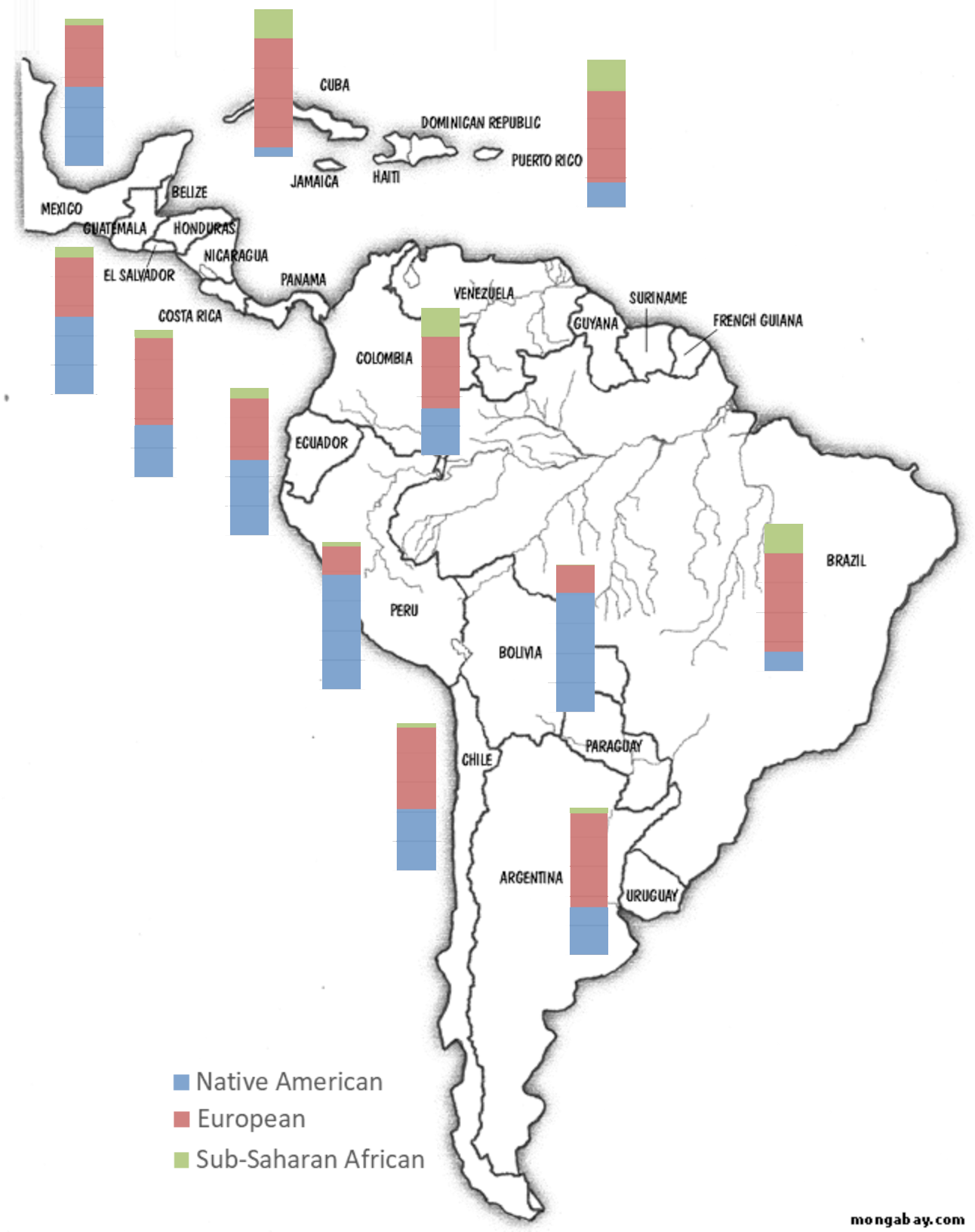 |
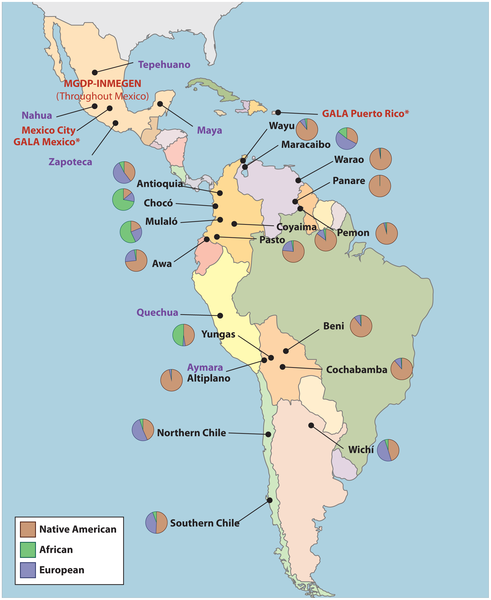 |
From the perspective of white nationalists, the race-mixing that happened largely between American Indian women and white European male colonizers was a bad thing when considering the modern societies that that genetic admixture produced, in comparison to the largely white descended population of the United States and Canada. But we still have to remember that from the biological perspective of the Amerindian women, the race-mixing was a good thing because it enabled them to reproduce and replicate their genes to re-populate the Americas after ~90% the American Indians died of disease.
We also have to keep in mind is that the American Indian women had knowledge of how to live off the land, whereas the white colonizers did not. As Blithering Genius mentions in his essay titled “Space Colonization and Industrialization” from his book Futurist Fantasies, advanced technology alone would not’ve been sufficient for colonizing the Americas in the 1500-1700s because technology depends on the scale of civilization, and more complex levels of technology cannot develop unless the more primitive technologies that created their existence were invented and used beforehand.
Perhaps the white colonizers could’ve eventually colonized the Americas by breeding with white women to create a purely genetic admixture if they had waited longer to build technology that could help colonize the rest of the Americas, but this undoubtedly would’ve taken longer. And if the colonizers who were there in the American colonies wanted to colonize the Americas as soon as possible, it simply would’ve made more sense to breed with an American Indian woman due to their knowledge of how to live off the land. They would have to have children with the American Indian women in order to incentivize them to care for the descendants of the white colonizers, since those children would be theirs too. If the European colonizers in the Americas during the 1500s didn’t interbreed during that century, then other European men from later centuries would’ve populated the continent instead, and that would’ve been a loss for their selfish reproductive biological interests.
In terms of psychological and social value, most people today who value modern civilization may prefer that the Americas had been populated exclusively or near exclusively by white people instead, but this ignores how the ancestors of the modern inhabitants of Latin America (both the white colonizers and Amerindian women) valued the procreation that created all of their descendants. Might makes right, and power is self-justifying.
Ultimately, if white nationalists really want to promote white preservation and stop the great replacement (both of which I support), then they should encourage white people to have more kids. The more kids white people have (irregardless of who they breed with), the greater the white proportion of the gene pool will be.
8.7. Other Errors With White Nationalist / Race Idealist Ideology
I support ethnostates (or I’m at least not opposed to them), so I could technically be considered a white nationalist depending on how it’s defined. However, I don’t associate myself with that label since most white nationalists believe in multiple things that I strongly disagree with and condemn:
- Most WNs believe in Group Selection Theory, instead of the Phenocentric Selection Theory.
- Most WNs believe in the r/K Selection and Differential K Theories, even though they’re based on fallacious reasoning.
- Most WNs believe in kin altruism and Kin Selection Theory, but it’s based on fallacious reasoning.
- Most WNs believe in the Jewish Conspiracy Theory. I don’t believe it’s real, and most of the evidence for it falls apart once Group Selection Theory is rejected. I’ve never seen anyone convincingly argue for either position without doing a lot of hand-waving.
- White nationalists believe that race differences in crime and IQ are due to genes (genetic determinism), but they also believe that white people are completely controlled by Jewish propaganda. So they also believe in a very strong form of cultural determinism too, which is a contradiction.
- Many WNs deny the Holocaust. My position is that the Holocaust was real and the forced labor camps certainly existed, but it’s reasonable to be skeptical of the 6 million deaths figure and some other aspects. Regardless, I very strongly condemn the Holocaust.[11] We should also acknowledge that the Holocaust has become a sacred narrative for justifying arbitrary morals. No historical event should ever be off-limits from questioning.
- WNs tend to be racist and anti-Semitic, whereas I condemn such discrimination.
- Many WNs are white supremacists who support a form of race idealism. I oppose racial supremacy on a philosophical basis, and am better described as a race realist, not a race idealist.
- Some white nationalists are not willing to live with other people of other races, even if they conform well to the society’s goals. This is irrational.
- Race-mixing is okay under some conditions. Whether it’s “good” or “bad” depends on values.
- White nationalists tend to oppose having a globalist government, whereas I’ve never seen a principled argument against global governments that doesn’t also apply to lower levels of government. If one is willing to support one level of government, it’s contradictory to not support other levels as well.
- Generally speaking, most white nationalists aren’t philosophical enough for my tastes. Besides topics that relate to race and politics, most of them wouldn’t be very interested in the other topics on this website’s homepage.
- Some WNs argue that the United States and other Western countries don’t need high-IQ non-white immigrants.
For example, Thuletide stated that the US alone contains ~4.5 million Whites with an IQ over 130, which he probably computed using a normal IQ distribution for European Americans.
- I believe that it would be a huge mistake to not accept any high-IQ immigrants from other races. Immigrants from foreign countries make up the majority of the US STEM workforce.
- The labor supply of European Americans with IQs over 130 would also be smaller if women are excluded from working in occupations that require high intelligence. I’m noting this because many WNs believe in strict gender roles.
- While I believe that a lot of technology is overused these days, it’s clear that the US would probably become economically poorer and less intelligent without selective foreign immigration.
- I believe that Thuletide and other WNs might reconsider their position if they understood this.
 |
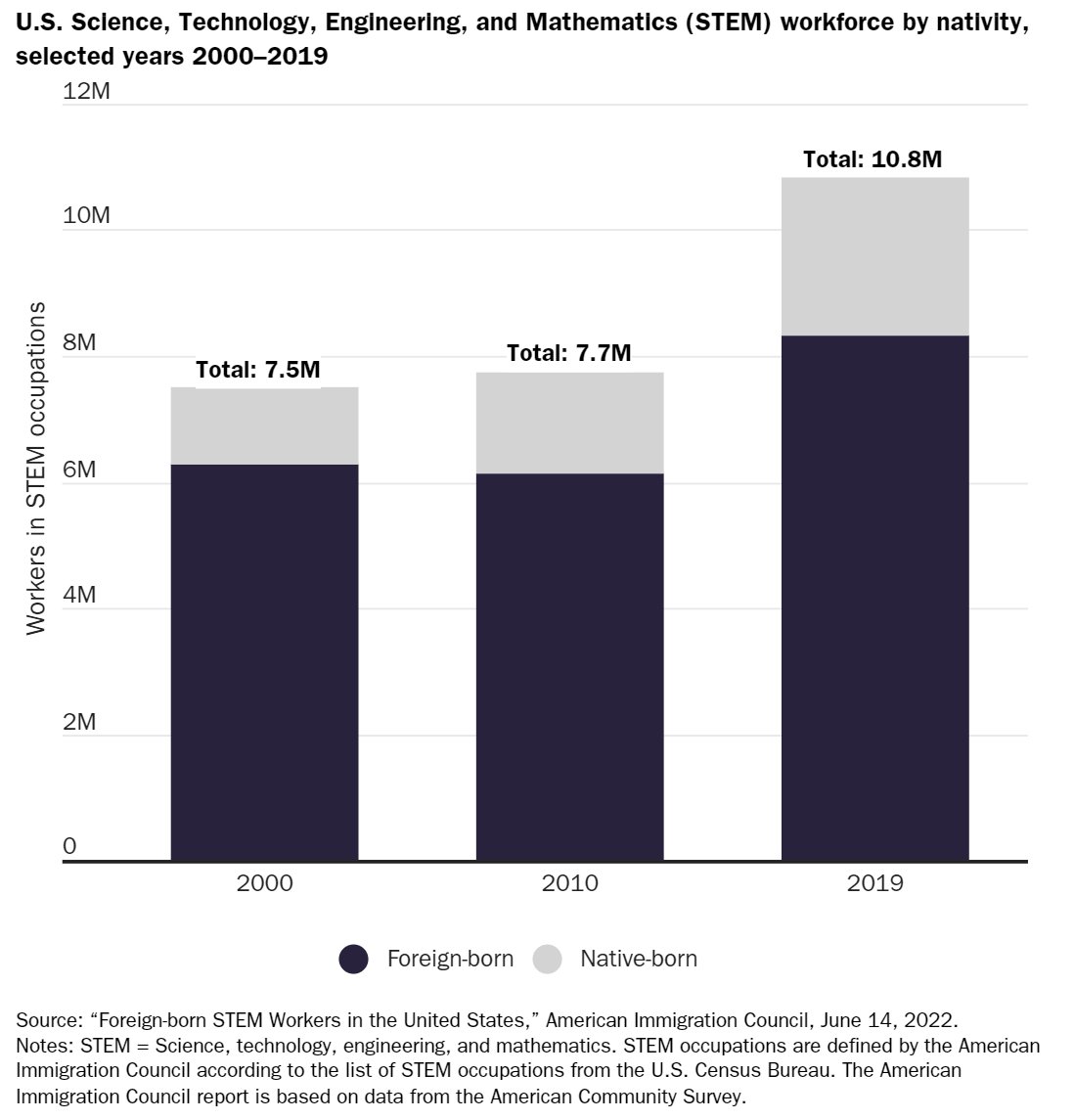 |
- First Image: White nationalists are divided between those who think that Christianity is a Jewish psyop, and those who proudly value their Christian religion with pride.
- Second Image: Immigrants from foreign countries make up the majority of the US STEM workforce.
9. Ethnostates
9.1. What Are Ethnostates?
Perhaps the most common misconception about ethnostates is that they require killing every non-White person, gassing Jews, and/or requiring 100% of the population to be descended from the ethnostates’ ethnicities. This is not true at all. Even the most practical white nationalists recognize that the one-drop rule is not a useful guideline for ethnostates.
The Oxford Dictionary defines “ethnostate” as follows:
A sovereign state of which citizenship is restricted to members of a particular racial or ethnic group.
Dictionary.com defines ethnostate as follows:
A country populated by, or dominated by the interests of, a single racial or ethnic group.
Wiktionary.com defines ethnostate as follows:
A political unit that is populated by and run in the interest of an ethnic group.
As we can see from these definitions, an ethnostate is just a state that exists for the interests of one group. For example, >98% of the people in Japan belong to the Yamato ethnic group, and the state serves the interests of the Yamato people. So Japan is an “ethnostate”, but the state doesn’t harm every non-Japanese person. White nationalists just want ethnostates for White people.
It really is that simple. And many ethnostates already exist all over the world for other ethnic groups (China, Korea, Cambodia, Israel, Somalia, etc), so what’s wrong with having some white ethnostates too? Every other major ethnic group already has their own ethnostates, so it’s only fair.
In non-human species, environmental conservationists often try to prevent admixture between different species and subspecies. The idea is that this helps preserve biodiversity. For example, crossbreeding between American bison and cattle is usually discouraged as much as possible in order to maintain a pure basin genome. Most people generally find this to be uncontroversial, so it would be inconsistent to hold the opinion that we shouldn’t try to preserve different human races (i.e. subspecies) in their original forms or not. For maximal biological diversity, it’s probably best to strike a reasoned balance between interspecies breeding and isolation for both human and non-human organisms.
Another common misconception is that white preservationism, white nationalism and white supremacism are all the same thing, but they are not. Personally, I hate white supremacists, as well as everybody else who is absolutely obsessed with thinking that race is everything (that includes most leftists as well). Racial homogeneity would be helpful to any society that has it, but it’s not worth obsessing over. As for White Preservationism, I define it as: A movement to counter the Great Replacement by increasing white fertility rates in the Western World. To me, the goal of white preservationism should be to preserve (most of) the (good) genes of Europeans, not necessarily to preserve distinctively European appearances or to preserve white people as a distinctive race, although I’m not against that.
In many cases, there is essentially no difference between an ethnostate and a government that simply acts in the interest of the society. I personally support restricting immigration, eliminating demographic quotas, enforcing meritocracy, reducing or eliminating welfare, and other policies that coincidentally benefit the most dominant ethnic groups in Western and Westernized countries. Some people would consider those to be ethnonationalist policies, but all those policies would benefit most people on average, regardless of their race. Most people don’t benefit from mass immigration, meritocracy is best for everyone (on average), and maintaining a sustainable government budget is in the long-term interests of society. Ethnonationalists may be likely to support those policies, but so would most reasonable people.
9.2. The Limitations of Ethnostates
In the West, white nationalists and eugenicists both agree that reducing mass immigration, deporting illegal aliens, and removing welfare benefits are important priorities. It could be done strategically if there’s enough political will and power to make it happen. There is no debate that racially homogenous societies tend to perform better than multiracial societies. The main disagreements between WNs and race-blind eugenicists are 1. how practical it would be for Western governments to prioritize benefiting the dominant ethnic group over the minority ethnic groups, 2. whether or not that’s feasible according to the size of the minority population, and 3. race-mixing should be forbidden. The white nationalists’ main justifications are that: 1. it would take too long for minorities to assimilate into the society, 2. it can happen if there’s enough political will to do it, and 3. race-mixing would be dysgenic and culturally unstable in most cases.
The US, the UK, Canada, France, and other Western countries all should’ve became ethnostates that greatly curtailed foreign immigration in the 90s, but I am skeptical that it will be possible to reverse the mass immigration from previous decades in the 2020s and beyond. Non-white people make up too much of the US and Canadian populations[12] (they might have too much leverage), there isn’t enough mass public support and political authority to greatly curtail mass immigration from foreign countries, and there’s not even enough support among white people for turning those countries into ethnostates. Bringing up the proposal to turn Western countries into white ethnostates would ignite strong opposition and accusations of racism, and it is difficult to substantially change any person’s worldview on just about anything. For the United States, a more likely scenario is that some region of the US becomes a de facto ethnostate for white people. Assimilating minorities into the society may take generations, but it’s not impossible, especially if EPC limits their population growth. Whether race-mixing is dysgenic and harmful to the civilization is a more complicated issue.
The greatest problem facing the West is mass immigration from other countries. Reducing foreign immigration would greatly curtail wokism, anti-Western hatred, and the cost of rent, while boosting wages, fertility rates, and eugenics. This is a smaller goal than achieving a white ethnostate with wider public appeal, so it’s more feasible. We will have greater success at reducing immigration if we focus on emphasizing all the problems that it’s causing. Ethnostates would help achieve white preservationism, but the most important thing is that the fertility rates of white people are increased in general. Reducing foreign immigration will help with this.
There’s not much that an ethnostate can do that can’t already be solved by a eugenostate. The biggest problem that ethnonationalist policies won’t solve by themselves is preventing overpopulation. Overpopulation is a free-rider problem, so population control is the only way to conceivably prevent overpopulation without war, disease, or famine. Ethnostates don’t prevent dysgenics by themselves either since they don’t regulate reproduction. Every successful ethnostate would have to enforce EPC in order for it to be sustainable for the long-term future. Over time, eugenic policies could cause the average black or white person to be as intelligent as East Asians are today, with even lower crime rates too.
Read More: How Practical Are Ethnostates For Promoting Eugenics?
9.3. The Logistics For Creating Ethnostates
Theoretically, these are the most likely steps for converting Western countries into white ethnostates:
- White identity and support for pro-white policies gradually increase over the years as white people continue to be marginalized and discriminated against.
- Westerners (especially White Westerners) start to vote more conservatively than they already do.
- Western countries eliminate their welfare for immigrants. In the US, eliminating welfare could disincentivize over 50% of immigrants from staying.
- Some immigrants leave Western countries once the welfare stops. If they riot in response to the elimination of welfare, then they are deported. Political support for deporting them would be in response to their rioting and violence. Hard-working immigrants who support the country can (and should) stay.
- The public gains enough support for stopping mass immigration, since it increases the cost of rent, and reduces wages, fertility rates, and eugenics.
- The Conservatives amass enough popular support for deporting the rest of the illegal aliens from Western countries (there are over 10 million illegal aliens in the United States alone).
- As wages rise, white fertility rates increase. The West takes measures to boost white fertility rates.
- Western countries reach critical demographic and political thresholds for becoming white ethnostates.
- The public gains enough support for EPC to turn the country into a eugenostate.
Note that this is an (overly) optimistic event sequence. It’s not clear whether the West will achieve even half of the objectives on this list in the future, but we should try to accomplish whatever we can. All Western countries used to be white ethnostates, and it may be possible to restore that.
Read More: Population Dynamics FAQs: Ideas For Boosting Western Fertility.
9.4. Is miscegnation into a “global race” inevitable?
To an extent, the notion of “mixing” is somewhat misleading, because there aren’t separate discrete types that are being “mixed” together. Rather, existing racial clusters can disappear and/or change, due to different selective pressures and global migration. In that sense, some level of “mixing” is always inevitable, since genes are always mixed when a male and female mate and conceive a child.
Globalization and race-mixing are causing many distinctive racial differences to disappear. If countries decide to enforce very strict immigration/miscegnation/etc laws, then many distinct races will be mostly preserved as the original genetic clusters that they were historically. If there’s enough political will to prevent race-mixing, then it could theoretically be prevented. Until then, global immigration, and interracial relationships will continue to blur the boundaries between genetic clusters. But this doesn’t imply that racial categories won’t still be useful for having predictive power.
10. The Great Replacement
10.1. Isn’t The Great Replacement Of White People Just A Conspiracy Theory?
No, not at all. Anybody who claims the Great Replacement is a myth is a liar, and I say that as someone who is less European than the average American (as of 2025).
The Great Replacement is not a theory nor a hypothesis. It’s an observation and a chrononym, on the same level as “The Great Plague”, “The Great Depression”, “The Great Migration”, “The Great Vowel Shift”, or Climate Change.
Statistics consistently show that countries with indigenous and/or historically European populations are gradually being replaced by non-European people. This trend has been happening for decades. People can pretend that this isn’t a problem or that it won’t lead to the perishing of white people all they want, but it is undeniable that if the trend continues for several decades, white people will be replaced by other races by and large, unless something happens to reverse the trend and increase the fertility levels of white people within their own indigenous and historical countries.
“A report by the U.S. Census Bureau projects a decrease in the ratio of Whites between 2010 and 2050, from 79.5% to 74.0%. At the same time, Non-Hispanic Whites are projected to no longer make up a majority of the population by 2045, but will remain the largest single ethnic group. In 2050 they will compose 46.3% of the population. Non-Hispanic whites made up 85% of the population in 1960. However, white Americans overall are still projected to make up over 70% of the population in 2050.” Source
_from_1960_to_2020.gif)
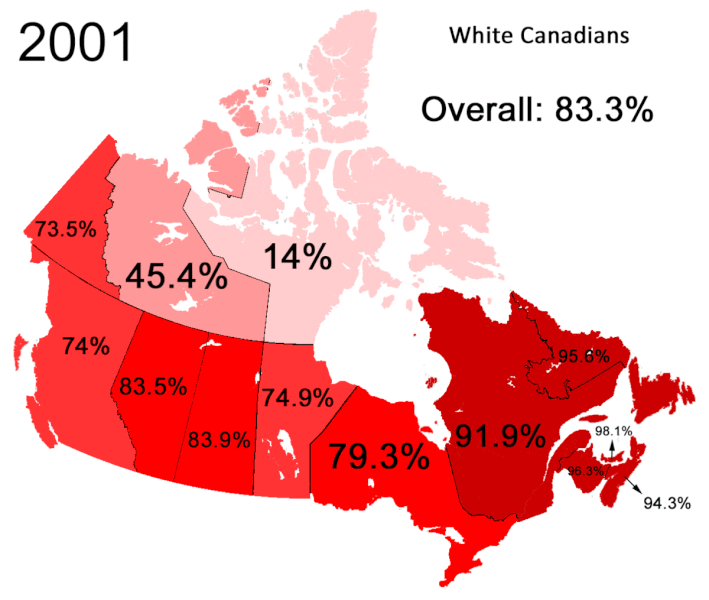
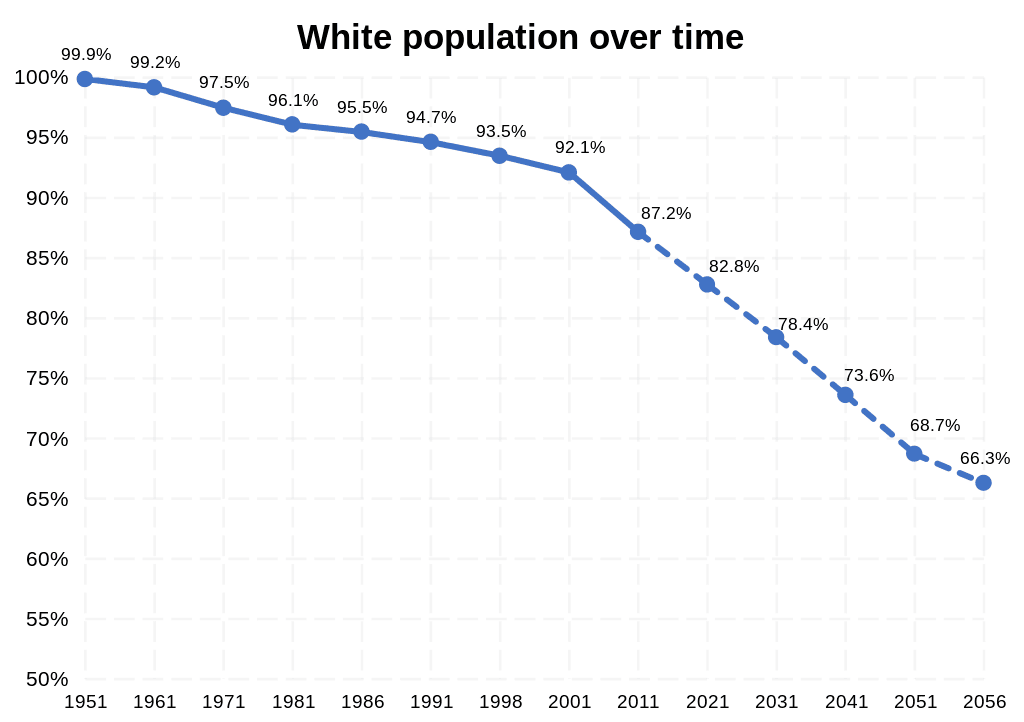
The evidence clearly shows that white people have relatively low fertility compared to other races in Western countries (mass immigration doesn’t help with that either), that the population of mixed-race people is on the rise in the West, and if the fertility rates of white people don’t increase, then they will get replaced by humans with different genetics. If the United States does not enforce stricter immigration policies soon, it is on course to become akin to Brazil racially and like South Africa politically.
There are no other countries in the world, besides Western ones that import foreigners in great numbers and then indoctrinates them to hate and resent the host population. People who deny the Great Replacement Theory are following the typical leftist tactic of denying that something bad is happening, but if it is happening, then it’s actually a “good” thing.
Figure 8: White America (of one race) from 1960 to 2020, CC BY-SA 4.0, by Tweedledumb2.
Figure 9: White or European Canadians from 2001 to 2016, CC BY-SA 4.0, by Tweedledumb2.
Figure 10: White population in UK including projections to 2056, CC BY-SA 4.0, by Tweedledumb2.
10.2. Fallacies Used To Deny The Great Replacement
Why is it a bad thing for whites to become a minority? Doesn’t that imply that it’s difficult to be a minority? Doesn’t imply that minorities are discriminated against or something?
There are multiple problems with this argument:
- Would anyone say that to American Indians when they became minorities on their native continents? “What’s the matter? You don’t like becoming a minority within your homeland? Just deal with it!”
- This argument implicitly suggests that it’s okay for whites to become minorities within former white-majority countries. Since it also assumes that minorities are discriminated against, it implicitly admits that it’s okay to normalize discrimination against whites.
- This argument has a contradiction. Either:
- Minorities are discriminated against, in which case it’s perfectly reasonable for white people to be averse to themselves becoming a minority within their own countries.
- Minorities aren’t discriminated against. Hence, we can end all the DEI and anti-racism nonsense.
- If minorities are discriminated against, and we have an obligation to end all discrimination, then the most logical conclusion is for everyone to return to their ancestral homelands where they are the majority demographic. If there’s no benefit to being a minority within a society, then it makes more sense for everyone to migrate somewhere where their demographic constitutes a majority.
The percentage of white people in the US and other Western countries may have gone down, but the raw number of white people has gone up. Whites made up 75.1% of the total US population in 2000, and 72.4% in 2010. This is not a decrease in population because the overall number of whites actually rose from 211,460,626 to 223,553,265.
First, those statistics don’t specify who gets counted as being “white”.
- Do Arabs count as white? Most Arabs consider themselves to be separate from White Europeans.
- Do Jewish people count as white? What about Ashkenazi Jews specifically?
- Do Middle Easterners and Central Asians count as white?
- If the average black American has ~24% of their genes originating from white people and they make up ~13% of the population, should that fraction of the 13% count as white?
- Do mixed-race people count as white, or only the percentage of their genetics that can count as white?
- Do white Hispanics count as white? In a 2015 study, the average European admixture among self-identified White Hispanic and Latino Americans is 73%.
Most censuses would classify Arabs, Jews, Middle Easterners, white Hispanics, and people who identify as being white as “white”. Given that Hispanics were/are one of the fastest growing ethnic groups in the US during the early 2000s, it’s doubtful that the number of wholly European-descended Americans has increased.
Furthermore, even if it’s true that non-mixed-race European Americans went up in overall numbers, the decline in the percentage of the white population still matters for multiple reasons:
- It reflects a changing balance of power between whites and minorities, who tend to lean conservative and leftist respectively.
- Even if the number of white people in the US and the West increases, white people are still projected to become minorities within historically white countries, an unprecedented phenomenon.
- The increase in the non-white population is related to the increase in foreign immigration, which should be opposed for multiple reasons.
- White people have lower fertility rates than non-whites.
- Older generations are more white than younger generations. It may take a few decades or so, but once the West’s older and more white population eventually dies off, we’ll see that the raw number of white people in the West will go down, not just the percentage of white people. This is inevitable when the youngest generations are the most racially diverse generations in history, and when future generations are only projected to become less and less white.
- Purely white people may continue to exist in the future, but if they do, it’s plausible that they’ll eventually become as rare as whites in South Africa, or as uncommon as American Indians are in the US.
Many countries in Europe, especially Eastern Europe, remain ethnically and culturally homogeneous.
Nobody is saying that white people are disappearing in every country. The point is that both the numbers and percentages of white people are projected to decrease in historically white countries like the US, Canada, Australia, and most of Western Europe. So much so, that white people will no longer be the majority demographic within their own countries.
How can Great Replacement theory be true when political conservatives tend to have higher birth rates than political leftists?
- Political conservatives still have below-replacement fertility.
- Mass immigration will cause their numbers to continue declining.
- White populations are still declining, in spite of conservatives having higher fertility rates than leftists.
Japan and South Korea might have even worse birthrates than Europe, but they do not have the same levels of foreign immigration. In a hundred years, Japan and South Korea might have only 10% their current populations, but they will still be populated mostly by Japanese and Koreans. This is not the case in Europe. In a hundred years, Europe will be mostly Muslim, and a large percentage will not have European ancestry.
Since you’re a mixed-race person, why do you care about stopping the Great Replacement? Shouldn’t you live by your words and migrate out of the West?
The immigration policies set by Western governments are not aligned with the people of the West. I care about stopping the Great Replacement because white people were the ones who built the modern world, and I don’t want them to die out.
I support turning Western countries into white ethnostates because I’ve concluded that ethnostates are more stable societies and I want modern civilization to continue prospering. Obviously, I’m not opposed to minorities living in Western countries and having citizenship, as long as they make positive contributions towards the preservation of human civilization, which is what I care about above all.
10.3. Anti-White Ideology and Propaganda in the West
The only way anyone could overlook the current anti-white propaganda and policies in the West is if they have an ideology that blinds them to it. When “It’s okay to be white” is labeled as a hate slogan, we clearly have a problem. When Westerners think about racism or racial oppression, the first things that usually come to mind are moral narratives, like the history of slavery, the Jim Crow laws, European colonialism, Nazism, or the Holocaust. For this reason, it’s harder for people to notice anti-white racism, even though it’s the most common type of racism in the Modern West.
Links Regarding Anti-White Ideology And Propaganda In The West:
- Systemic Anti-White Bias in Western Media: A Ton of Evidence (Available as PDF).
- The Rise of Anti-White Bias in Media (with Statistical evidence).
- The Intentional Destruction of White Birth Rates: Leaked reports from Planned Parenthood, the Rockefeller Foundation, World Bank, US NSC (including CIA, military etc).
- Imperialism and Colonialism: White Guilt and Historic Non-White Conquests of European Territories.
-

- Woke, Anti-White Wikipedia:
- Wikipedia: Black Pride.
- Wikipedia: Asian Pride.
- Wikipedia: Gay Pride.
- Wikipedia: Straight Pride.
- Wikipedia: Disability Pride.
- Wikipedia: White Pride – Note how this is the only article that portrays racial pride negatively.
- The “Right” Amount of Concern about Racism - Noah Carl, Aporia Magazine: This article presents eight examples of how the West’s concern with anti-racism has gone too far, to the point of being counter-productive: cancel culture, self-censorship, the media’s Great Awokening, responses to police shootings, hiding the race of suspects, hugging people during a pandemic, not profiling terrorists, and ignoring grooming gangs.
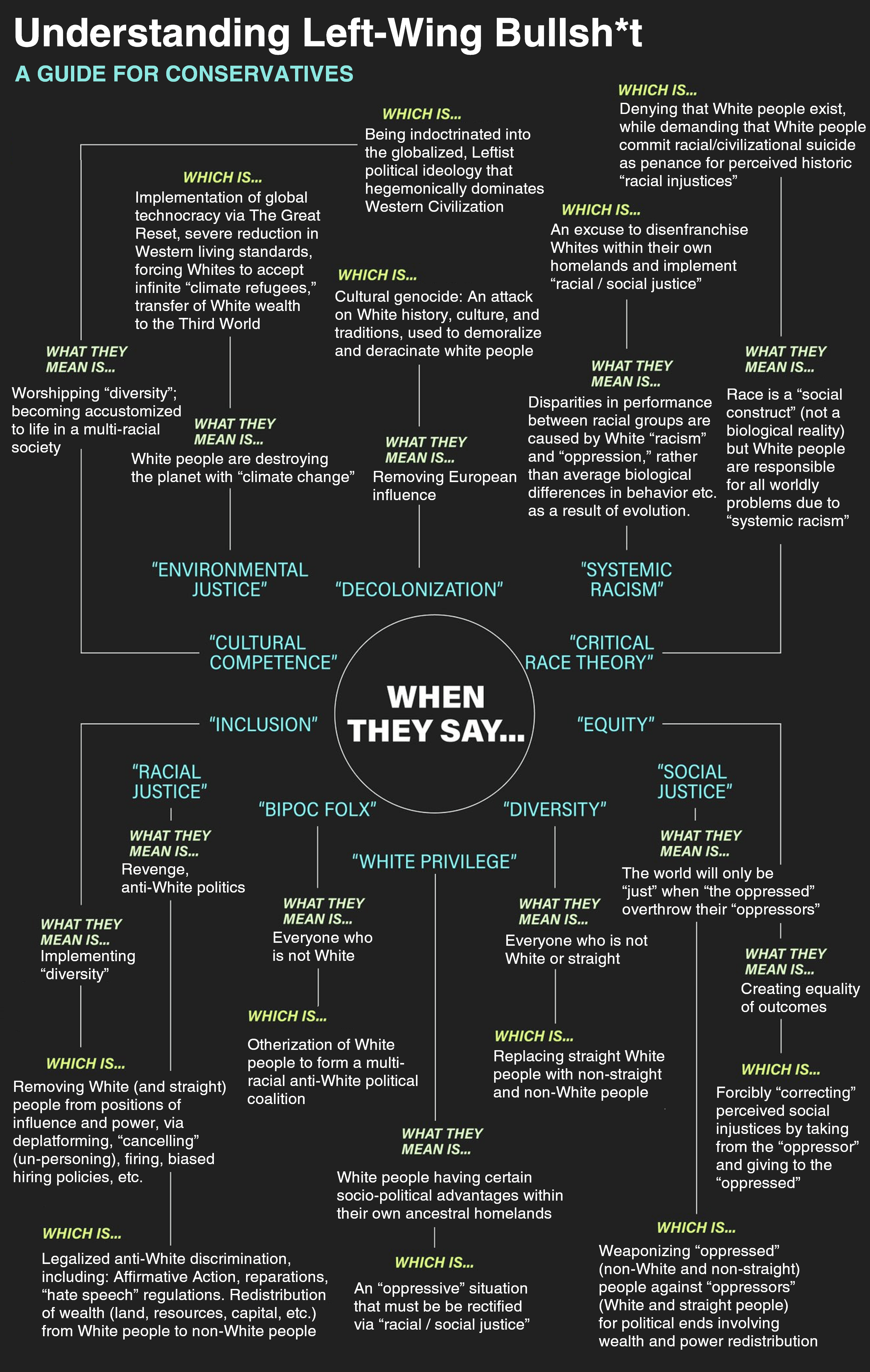
Links For Reading More About The Great Replacement:
- Whiteness and the West - Aporia Magazine
- Documenting The Great Replacement, Master Post - Charles Angelson
- Documenting The Great Replacement, Part I - Charles Angelson
- The Great Replacement is a top-down project: The role of the United Nations and other transnational Globalist organizations
- The United Nations’ leading role in criminalizing racial and ethnic homogeneity: Legally binding “refugee” conventions and more
- Globalist Agenda Summary: Where are elites taking us, and why?
- US Census shows America’s post-2020 population is driven by diversity especially among the young
- Timeline of the Replacement Migration Agenda
- Eternal Anglo: A data analytics blog that covers the fertility rates of different races by country
- More Statistics On White Demographics
10.4. Ideas For Boosting Western Fertility
11. Glossary
- Evolution
- The change in the heritable characteristics of biological populations over successive generations. Evolution is a three-step process consisting of: 1. Reproduction (to excess), 2. Variation (caused by mutations) in offspring, 3. Selection.
- Biological Realism
- The unbiased application of the implications of evolutionary reasoning onto human beings, regarding race, sex, selfishness, eugenics/dysgenics, and intrinsic violence.
- Biological Determinism
- The theory that many traits, abilities, and much of human behavior are determined primarily (or even exclusively) by biological and hereditary factors, such as genetics, hormones, and evolutionary influences.
- Race Realism
- See: What is Race Realism?.
- Scientific Racism
- A pejorative term for “race realism” that misrepresents what it actually is. This term is intended to suggest that the belief is motivated by racism and justified by “pseudo-science”. Race Realism does not imply racism.
- “Human Bio-Diversity” (HBD)
- Another term that generally means “race realism”, but can be extended to also talk about other things like sexual differences and such. It seems that HBD may have fewer stigmas or negative connotations than either “Race Realism” or “Scientific Racism”.
- The Hereditarian Hypothesis
- The hypothesis that genetics determines most human traits and differences. Another term that is related to and/or refers to “race realism”.
- Race
- A statistical cluster of genetic variation, which is characterized by phenotypic similarities and shared ancestry“. Races typically refer to humans, and are akin to subspecies. Racial categories tend to have predictive and explanatory power, barring outliers.
- Statistical Cluster
- A grouping of a set of objects in such a way that objects in the same group (called a cluster) are more similar (in some sense) to each other than to those in other groups (clusters). For more info, see: Wikipedia: Cluster Analysis.
- Mixed-Race
- Having genes and ancestry from multiple different races. Note that being Mixed-Race cannot be well-defined unless two or more races are defined beforehand.
- Ethnicity / Ethnic Group
- A grouping of people who identify with each other on the basis of shared attributes that distinguish them from other groups. Those attributes can include common sets of traditions, ancestry, language, history, society, culture, nation, religion, or social treatment within their residing area.
- Racism
- There are multiple definitions for “racism”, since the term doesn’t have a clear meaning. I personally prefer the following definition: Irrational prejudice or discrimination based on race or ethnicity.
- The West
- Countries that have majority European populations and/or have been influenced by Western Culture, including Europe, the Americas, Australia, and New Zealand. Sometimes I use this term more generally to also include Japan, South Korea, Taiwan, and Singapore since those countries have also been influenced by Western culture, and have decent genetics for modernity, as far as our policy objectives are concerned.
- Westernized
- Japan, South Korea, Taiwan, Singapore, and other countries that have been significantly influenced by Western culture. These countries also have similar values to Western countries and decent genetics for modernity, as far as our policy objectives are concerned.
- The Great Replacement (of White People)
- The phenomenon where white people are being replaced by foreign ethnicities within Western countries. It is very real and in several decades, it is projected to be finished by the end of the 2000s.
- White Preservationism
- A movement to counter the Great Replacement by increasing white fertility rates in the Western World. From a eugenics standpoint, the goal of white preservationism is to preserve (most of) the (good) genes of Europeans, not necessarily to preserve white people as a distinctive race.
- White Nationalism
- An ideology that promotes ethnostates for white people, perhaps as a way to support white preservationism.
- White Supremacy
- A form of race idealism that values white people.
- Race Idealism
- An ideology that espouses racial superiority, preserving racial composition, and racial solidarity (v1) as its core values. Race idealism is accompanied with racism and selective data and interpretations to affirm its values.
- Ethnostate (v1)
- A country populated by, or dominated by the interests of, a single racial or ethnic group.
- Ethnostate (v2)
- A sovereign state of which citizenship is restricted to members of a particular racial or ethnic group.
- Ethnostate (v3)
- An ethnonationalist state that enforces racial or ethnic homogeneity.
- Ethnocracy
- The same thing as an ethnostate, except there doesn’t necessarily have to be a single ethnic group that populates the majority of the country.
- Eugenostate
- A state that enforces Eugenic Population Control, Laissez-Faire Eugenics, and Immigration restrictions, regardless of race or ethnicity.
- Race Denialism
- The denial of Race Realism, either with fallacies and/or a refusal to extend the implications of evolutionary reasoning onto human beings.
- Race Nihilism
- The same as Race Denialism, with an emphasis on how race denialists have contradictory, two-faced beliefs on race.
- Blank Slatism
- The same as Race Denialism.
- Race Creationism
- The same thing as Race Denialism, with the connotation that the belief is similar to religious dogma.
- Racial Solidarity (v1)
- Solidarity between all the members of a race with each other. Proponents of racial solidarity tend to believe in kin altruism.
- Racial Solidarity (v2)
- Solidarity between people from different races with each other.
Read More: Race 101 Genetics Glossary - Thuletide.
12. Credits
Many parts of this page’s contents were written by other people. When possible, I’ve tried to quote people and give credit to them by displaying their text in block quotes and/or linking to where I first saw the text. Unfortunately, there are some limitations to doing this due to the formatting, design decisions, the software that I use to create pages on this website, and other factors. So, I created this section to give credit to people where it is due. I’d like to thank the following people for writing the text that is featured on this FAQs page:
- The numbered list argument of Isn’t Race just a social construct? was copy-edited from text displayed in one of WhatIfAltHist’s videos. The introduction and this numbered list were helped by Gnew on Discord.
- Many bullets in Examples of Race Being Biological were paraphrased from Race and Morphology/Physiology on Metapedia.
- The bullets in Athletic Performance were paraphrased from The Role Race Plays In Sport by B4 FleX.
- About half of the bullets in Behavioral Differences were copy-edited from JayMan’s post How Much Hard Evidence Do You Need?
- The following sections have paragraphs that were copy-edited from JayMan’s Race FAQs/FRBs:
- But race exists on a continuum, so race does not exist.
- No one has found a gene for intelligence, criminality, or any behavioral trait, so mental traits can’t be inherited. (The second paragraph was written by myself.)
- But there’s no objective way to define “intelligence” or quantify it with IQ scores.
- Racial Disparities in Intelligence.
- Racial Disparities in Economic Status and Academic Achievement.
- There can’t be racial differences because human evolution stopped 50000+ years ago.
- Some of the paragraphs in Why does it matter that people accept that race is biological?, K-Cluster Analysis, and But humans are too similar to each other to be considered separate subspecies were copy-edited from Anglo Tremilia on Discord.
- The numbered list in Hasn’t Academia debunked race realism as anti-scientific pseudoscience? was copy-edited from Thuletide.
- In Hasn’t Academia debunked race realism as anti-scientific pseudoscience?, the text analyzing the selection biases in Wagner et al, 2016 was copy-edited from zfc on Discord.
- The paragraphs in Organ Transplants were copy-edited from Thuletide’s posts. Many subsections in Tactical Nihilism Fallacies and many of the unsourced images were copy-edited from Thuletide’s website.
- The first paragraph of But there’s no objective way to define “intelligence” or quantify it with IQ scores was paraphrased from Gnew on Discord.
- Some of the arguments in Wouldn’t high intelligence be adaptive in all environments? were copy-edited from Metapedia’s Arguments Regarding the Existence of Races. The hypothesized genetic explanation for the correlation between IQ and myopia was conceived by Anglo Tremilia on Discord.
- Some paragraphs in Occam’s Razor on Racial Disparities were written by Blithering Genius in Response to my RatWiki Entry. Some paragraphs in Responses To Objections About Racial Disparities In Crime Rates and Wikipedia Articles Citing Tribal Warfare Between American Indians were paraphrased from Blithering Genius on Discord.
- The Black-White IQ Gap in the United States was written by Kent.
- A paragraph in What is the difference between genetic similarity and relatedness? was copy-edited from Felix on Discord.
- Most of the text in But what about Lewontin’s Argument? was copy-edited from Commander Waldo’s video, The Biological Reality of Race.
Zero Contradictions wrote, compiled, and formatted everything else on this page, and many authors have influenced my thinking. Overall, I’d personally say that Blithering Genius has been the most influential person in shaping the beliefs that I accept and have stated on this page.
Disclaimer: I want to be clear that just because I’m quoting and citing text written on other websites, that does not mean that I agree with other things that they’ve written, even though some people have falsely accused me of otherwise. I recognize that Thuletide and Metapedia endorse white supremacy in some of their webpages, but that does not mean that I support white supremacy, hence why I avoided citing anything that they wrote that is biased towards race idealism and racism. I re-emphasize that I strongly condemn all forms of racism. Likewise, JayMan has written about many other ideas on his blog besides race realism, and I disagree with most of them (e.g. See: Re: The Rise of Universalism by Blithering Genius).
Footnotes:
This argument is also used to argue that gender is a social construct with no biological implications.
See this essay for a concise informative explanation of how evolution works.
There are so many genes that have been identified and associated with higher or lower intelligence that it’s possible nowadays to do embryo selection that will yield children who are 2, 6, or 10.5 IQ points more intelligent than the parental average (when selecting between 2, 10, and 100 embryos), compared to if the parents didn’t conceive children via embryo selection.
“Racialist” is another pejorative that is often used to slander race realists. It’s worth asking “Is it possible for something to be both true and ‘racialist’”? For example, is it racialist to say that Nigerians usually have darker skin than Europeans? If it isn’t, then the accusation of “racialism” falls apart once the opponent concedes that race realism may well be true.
There is no clear consensus on what “racism” is or how it should be defined. However, I propose that racism is most reasonably defined as a negative value judgment(s) towards a race(s).
This Venn diagram was retrieved from Anatoly Karlin’s website, where he explained why he categorized each item as he did in the original image. All (or most) of the information presented in my modified version is more up-to-date and correct as far as I know.
To be clear, the heritability of intelligence doesn’t necessarily show how much the differences in IQ between races are genetic. They’re not the same value.
Genetic data shows Ashkenazi Jews are approximately half European and half Middle Eastern, so some people would consider them a separate race from Europeans. This is true for Jewish people in general.
As an aside, there are few rational arguments against consensual pedophilia, contrary to what most people believe. So, even if whites are more likely to be pedophiles than other races, this actually isn’t too bad, assuming that most (preferably all) of them only engage in consensual sexual activity.
The number and percentage of interracial marriages has increased by an unknown amount since 2010.
In addition to condemning the Holocaust, I’ve written about how it was dysgenic, rather than eugenic.
It’s unclear what percentage of the American and Canadian populations are European, since Arabs, Jews, Middle-Easterners, mixed-raced people, and white Hispanics are often categorized as “white”.
